OUT OF THIS WORLD
HOW OSU HIGH-ALTITUDE BALLOON RESEARCH IS AIDING NASA’S EXPLORATION OF VENUS
 Research, scholarship and creative activity at Oklahoma State University
Research, scholarship and creative activity at Oklahoma State University
Under President Kayse Shrum’s leadership, Oklahoma State University recently released our strategy, We Are LandGrant: Uncommon Preeminence for the Common Good . The strategy, released in October 2022, outlines OSU’s commitments, aspirations, priority areas and critical actions for achieving the bold intention to become “the nation’s preeminent land-grant university.”
OSU’s We Are Land-Grant strategy identifies several priority areas that align wonderfully with our research strengths. You’ll find a whole section of this issue of OSU Research Matters dedicated to those priorities.
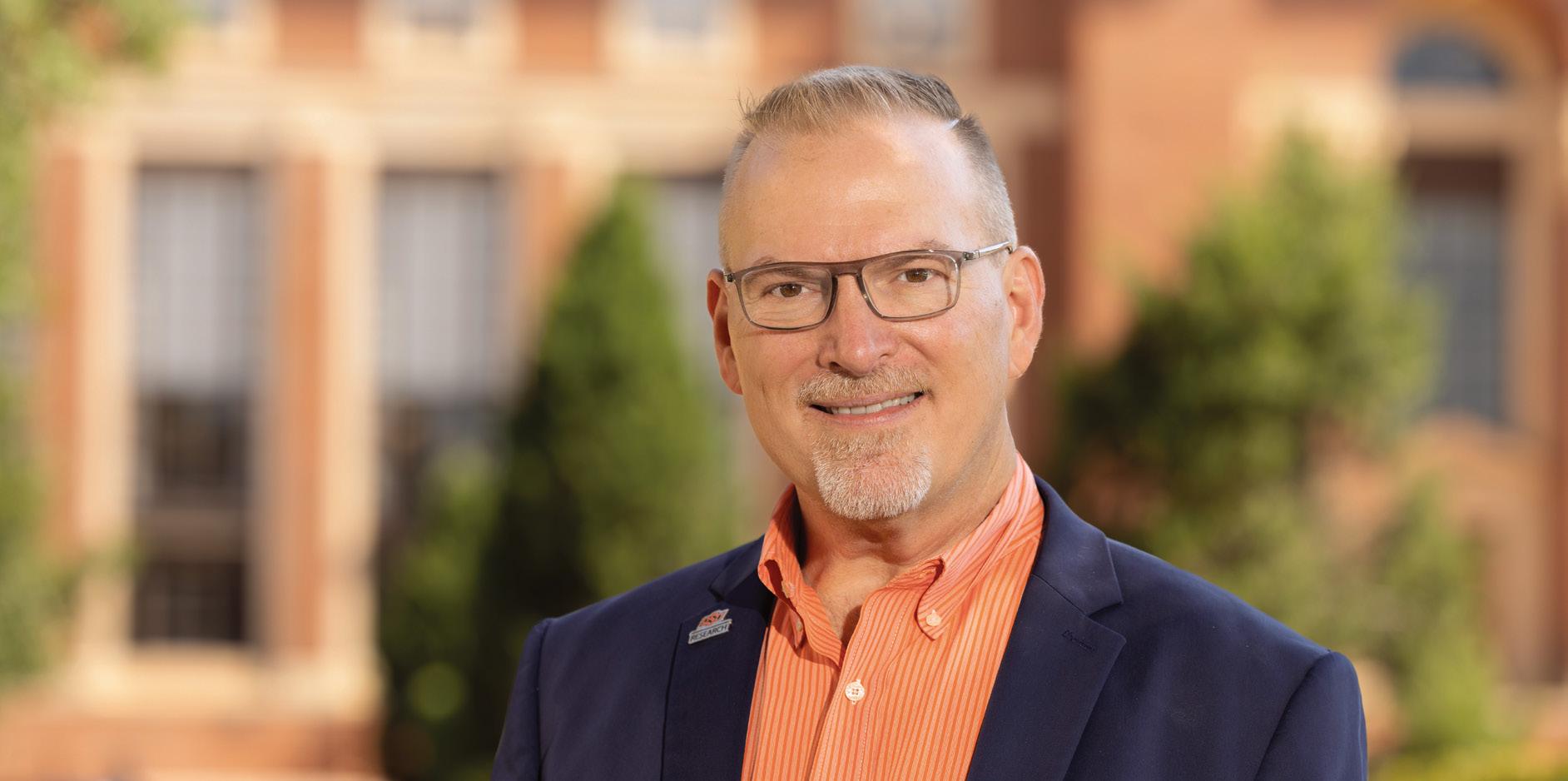
OSU’s strategy is organized around a set of Imperatives – things that we absolutely must do to achieve the vision. Not surprisingly, one of these imperatives directly points to research:
• Research Imperative – Elevate OSU among the ranks of R1 universities and leverage this top-tier status to advance research that impacts society.
As a comprehensive research university in Carnegie’s highest classification of research activity (commonly termed R1), OSU strives to attain even greater prominence and impact of its research enterprise. We will accomplish this by attracting and retaining high-talent innovators, leveraging our institutes to drive transdisciplinary discovery and broadening the reach of OSU research to make a positive difference in as many lives as possible.
In these pages, you will find many direct references to our strategy, our priority areas, our institutes and our innovative researchers who truly are the reasons why we are land-grant . I think you’ll like what you see.
GO POKES!
Kenneth W. Sewell, Ph.D. Vice President for Research

FROM THE DESK OF THE VICE PRESIDENT FOR RESEARCH
On the Cover Aerospace students testing heliotropes on Earth to withstand the atmosphere of Venus. (Cover photo by Gary Lawson)

14
President Kayse Shrum unveiled OSU’s strategic plan last fall, with four areas of research being the building blocks for her vision.


(Pages 14-45)
Future
OSU
PRESIDENT Kayse Shrum, D.O.
VICE PRESIDENT FOR RESEARCH
Kenneth W. Sewell, Ph.D.
EDITOR
Harrison Hill
COPY EDITOR
Jordan Bishop
ART DIRECTOR
Dave Malec
DESIGNER
Cody Giles
CONTRIBUTING WRITERS
Jordan Bishop, Alisa Boswell-Gore, Mack Burke, Abby Cage, Harrison Hill, Jeff Hopper, Stephen Howard, Kirsi McDowell, Erin Milek, Shannon Rigsby, Sydney Trainor and Mak Vandruff
PHOTOGRAPHERS
Mitchell Alcala, Taylor Bacon, Gary Lawson, Ryan Jensen, Aaron Murphy, Phil Shockley, Nina Thornton and Jason Wallace
OSU Research Matters is published annually by Oklahoma State University and is produced by the Office of the Vice President for Research. For details about research highlighted in this magazine or reproduction permission, contact:

OFFICE OF THE VICE PRESIDENT FOR RESEARCH
405.744.6501; VPR@OKSTATE.EDU
Oklahoma State University, as an equal opportunity employer, complies with all applicable federal and state laws regarding non-discrimination and affirmative action. OSU is committed to a policy of equal opportunity for all individuals and does not discriminate based on race, religion, age, sex, color, national origin, marital status, sexual orientation, gender identity/expression, disability, or veteran status with regard to employment, educational programs and activities, and/or admissions. For more information, the director of equal opportunity/Title IX coordinator is located at 401 General Academic Building and can be reached at 405-744-1156 or by visiting https://eeo.okstate.edu.
This publication, issued by Oklahoma State University as authorized by the Office of the Vice President for Research, was printed by Modern Litho, at a cost of $7,699.67/3M/ September 2023/No. osurm23.
16
Pillars of Research
48
in Time
Back
hosts medieval manuscript exhibit, allowing students, faculty and staff to see evolution of bookmaking. 56
OSU Library
of Work
tomorrow with AI. 38 54 74 74 16 14 48 56 Plus … 2 How Research Moves 4 CAREER Awards 10 Justice Research 12 Undergraduate Symposium 46 Baby Talk 54 Weight Stigmas 62 Awards
researchers working to create the factory of
RESEARCH.OKSTATE.EDU 1 TABLE OF CONTENTS
HOW RESEARCH MOVES
In the last issue of OSU Research Matters, the “How Research Moves” segment provided an overview of the primary reasons why research is integral to Oklahoma State University’s mission. First, the research mission draws experts from across the globe to join the OSU faculty. These experts then provide a powerful example of scholarly and scientific achievement to OSU students in the classroom, the laboratory and the field. Finally, OSU research extends beyond the institution’s boundaries to impact the public.
MOVING FROM PROJECT TO IMPACT (AT A GLANCE)
ADVANCING
DISCIPLINARY KNOWLEDGE
EXPAND/EXPLODE
DISCIPLINARY BOUNDARIES
TRANSLATIONAL RESEARCH
PUBLIC IMPACT RESEARCH
APPLIED RESEARCH AND DEVELOPMENT (OR APPLIED R&D)
EXPLAINING THE DIFFERENCES IN RESEARCH AND WHO THEY AFFECT
MOVING FROM PROJECT TO IMPACT
Any given research project can create impact in a variety of ways. Some types of impact are completely intentional from the outset, whereas others can be serendipitous, cumulative or accelerated by additional actions after the research is completed.
ADVANCING DISCIPLINARY KNOWLEDGE is often the intended impact of “basic” or “fundamental” research. Well-crafted research projects produce new insights on how the world works within a particular discipline. These findings are presented at professional meetings and published in journals to be read by other researchers. The research then becomes the launchpad for follow-on research that might create yet further impact (of the same or different type). Even when the initial intent is primarily to advance disciplinary knowledge, some research breakthroughs find their way into even broader impacts.
Some research is planned and executed to intentionally EXPAND/ EXPLODE DISCIPLINARY BOUNDARIES; at times, this occurs because of the findings rather than the researchers’ intent. Regardless, the very act of transcending the silos of individual disciplines provides the scientific and scholarly communities with new pathways to solve the problems of society. For example, consider a project that proposes to understand the bonding processes between a mother and her infant (the domain of developmental psychology) by mapping
PUBLIC RESEARCH COMMUNICATION 2 OSU RESEARCH MATTERS 2023
specific behavioral interactions onto neurochemical activities within the brain (the domain of neurology). If successful, such research has the potential to positively impact future generations (of research and people) in ways that neither developmental psychology nor neurology could do in isolation.
Some research endeavors are carried out with the explicit intent to result in a direct solution/answer to a problem/need within society.
TRANSLATIONAL RESEARCH takes knowledge from a disciplinary domain and translates it into a product or service that directly addresses societal problems. The most easily understood examples of translational research are in medicine. Researchers used the basic understanding of how a novel virus works (from the discipline of molecular biology) first to identify and characterize the SARS-CoV2 virus, then to create methods of testing for its presence in living organisms, and finally to create, test and deploy effective vaccines to prevent the virus from realizing even more devastating effects. For all this to come to fruition, the research requires more than just a team of skilled molecular biologists. To scale the production of test kits and vaccines, to get them into the hands of the appropriate professionals, and to create public acceptance of the safety and effectiveness of these new tools requires teams of systems and manufacturing engineers, logisticians, bioethicists, communications specialists and social scientists.
Research focused on the needs of a particular community is often planned
not just by the researcher; rather the researcher teams up with members of the community to determine what information or innovation is most needed and would provide the community with the greatest benefit. Projects of this sort are often called PUBLIC IMPACT RESEARCH. Other terms sometimes used are communityengaged research, community-based participatory research, or participatory action research. The central themes of these Public Impact Research models are that the community needs remain at the center of the research, and the primary benefit of the research should be to the community. OSU’s Rural Renewal Initiative is a great example of Public Impact Research. RRI research scholars embed within a rural community and design projects in partnership with community leaders. The findings are then used by the community to design policies, workforce programs, infrastructure plans, etc. that directly benefit the community.
Researchers engage in APPLIED RESEARCH AND DEVELOPMENT (OR APPLIED R&D) when trying to invent or refine a technology with market potential. Often, researchers are starting Applied R&D projects with technologies that were invented to solve a temporary problem in the laboratory. For example, perhaps a researcher needed a filter to keep a specific type of particle from contaminating her chemistry experiment … and produced a makeshift way to create one. Then the researcher (or someone else) ascertained that a filter of that type
might improve upon the current technology for automobile air filtration. At that point, Applied R&D would take the makeshift laboratory invention, protect it (via patent or trade secret mechanisms), and conduct additional proof-of-concept research. Assuming success at each subsequent stage, the Applied R&D would create a prototype, engage with entrepreneurial partners to evaluate the product’s market potential, secure investments and take the product to market by scaling up production and selling it via a startup company or a license to an existing company. This process is what we often refer to as technology transfer.
Finally, all the types of impact discussed above can have an even greater impact if we follow them up with PUBLIC RESEARCH COMMUNICATION . In fact, this article — and the entirety of OSU Research Matters — are examples of Public Research Communication. For far too long, researchers have been content to communicate mostly to other researchers … and often only within their own disciplines. Sharing the many types of fascinating research that goes on at OSU with the public at large multiplies the impact of the research. That said, most researchers are not communications experts. So, partnerships with communications professionals are crucial … whether as writers for popular publications and media outlets, or as trainers of researchers who desire to better communicate their work to the public. When the public understands research, it can best benefit from research.
RESEARCH.OKSTATE.EDU 3
EARLY SUCCESS
SIX OSU FACULTY
RECEIVE PRESTIGIOUS NSF CAREER AWARDS
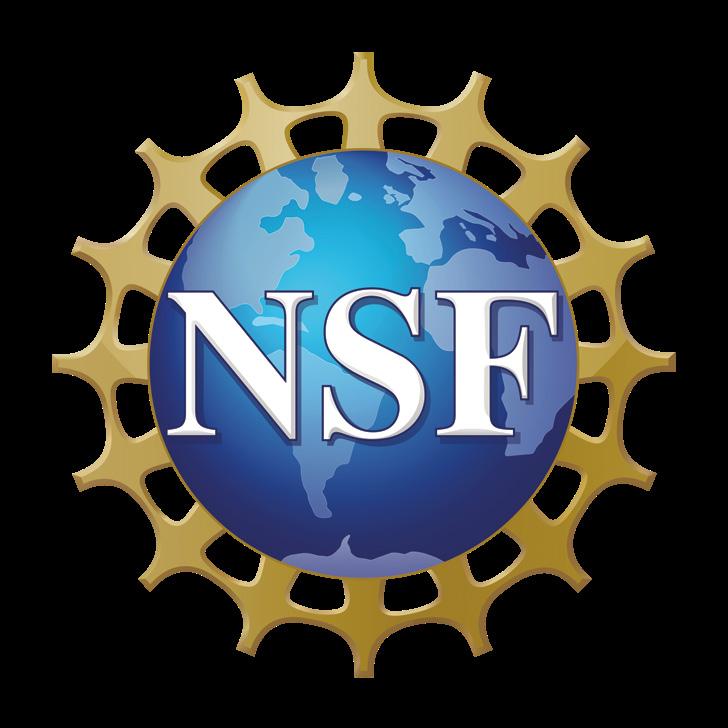
The future is bright for Oklahoma State University faculty.
OSU had six National Science Foundation CAREER award winners in 2023 from the College of Engineering, Architecture and Technology, and the College of Arts and Sciences.
The Faculty Early Career Development (CAREER) Program is an NSF award given to 500 people annually. Winners are chosen based on their potential to serve as an academic role model and to lead advances in the mission of their department or organization.
“We believe this is the largest number of NSF CAREER awards given to OSU investigators in a year,” said Dr. Kenneth Sewell, OSU vice president for research. “It is a reflection of the highly talented faculty members we have been able to recruit and retain.”
OSU’s recipients are Dr. Marimuthu Andiappan, Dr. Aurelie Azoug, Dr. Nicoletta Fala, Dr. Martin McCullagh, Dr. John O’Hara and Dr. Ritesh Sachan.
The faculty were awarded grants for a specific proposal in each of their fields.
STORY ABBY CAGE | PHOTOS GARY LAWSON AND PROVIDED 4 OSU RESEARCH MATTERS 2023
Nicoletta FALA
Using virtual reality to advance research and learning and promote positive skill transfer in complex environments with applications in enhanced flight training
Fala is an assistant professor in the School of Mechanical and Aerospace Engineering. She is a licensed commercial pilot and flight instructor and graduated from Purdue University with her bachelor’s, master’s and Ph.D. Her project will study skill transfer from VR-based simulation to the real world by evaluating the physical, functional and cognitive characteristics of simulation, as applied to the flight training environment.
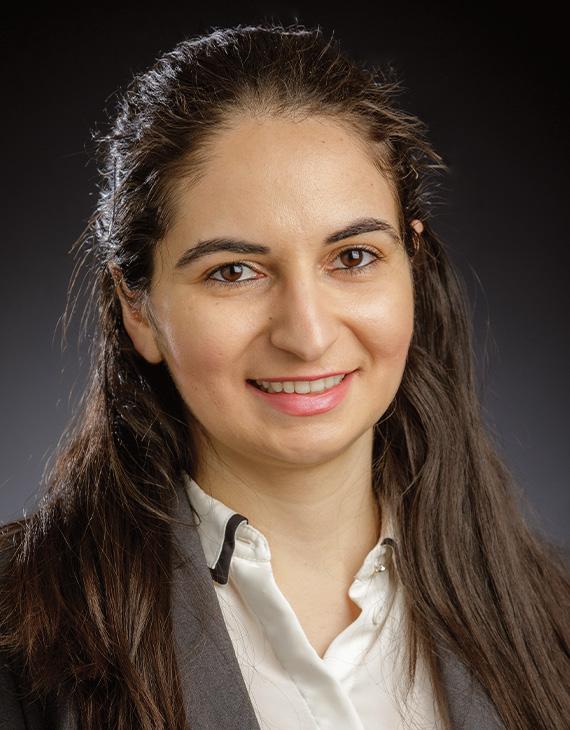
“I am passionate about all components of the project: education, research and implementation, so it seemed like it was made for me,” Fala said. “It’s nice to have someone else who believes in your work. It’s easy to formulate an idea and believe that it is a good idea in your own silo, but to also have the recognition of your peers and others in the research area agree is very rewarding.”
Aurelie AZOUG
Dissipation Mechanisms and Damping in Smart Elastomers with Intermolecular Organization
Azoug attended school in France at the Université de Technologie de Compiègne and Ecole Polytechnique. After spending time as a postdoctoral scholar at the University of California, Berkeley and Johns Hopkins University, she moved to OSU to be an assistant professor.
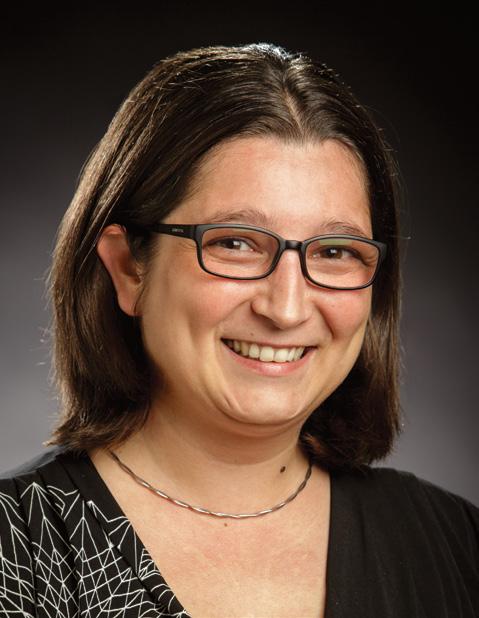
Her research will focus on three objectives — introducing soft robotics, improving coding skills and mentoring through research — with the hope being to increase women’s confidence and interest in engineering.
“This award is very validating,” Azoug said. “It’s recognition that says, ‘Hey, you’re doing good science and we’d like to see you continue down this path and see where you can take this research.’”
EARLY SUCCESS NSF
RESEARCH.OKSTATE.EDU 5
CAREER AWARDS
EARLY SUCCESS NSF CAREER AWARDS
John O’HARA
Taming the Terahertz for 6G Wireless Backhaul
O’Hara recently became an associate professor in the School of Electrical and Computer Engineering. He earned his bachelor’s degree from the University of Michigan and a doctorate from OSU.
He spent time as the director of central intelligence postdoctoral fellow at the Los Alamos National Laboratory, where he was part of a team pioneering the studies of artificial electromagnetic materials in the terahertz frequency range.
O’Hara’s project will leverage the existing abilities of his laboratory to explore system architectures and channel models needed for 6G communication systems.
“I’ve been very fortunate to have been surrounded with immense support and great colleagues,” O’Hara said. “It’s a bit serendipitous, just be at the right place at the right time and capitalize on opportunities that you’re afforded.”
Martin MCCULLAGH
Developing a Computational Workflow to Quantify Atomic-level Allosteric Mechanisms
McCullagh recently was promoted to associate professor in the Department of Chemistry after being an assistant professor for three years. He graduated with his doctorate from Northwestern University.

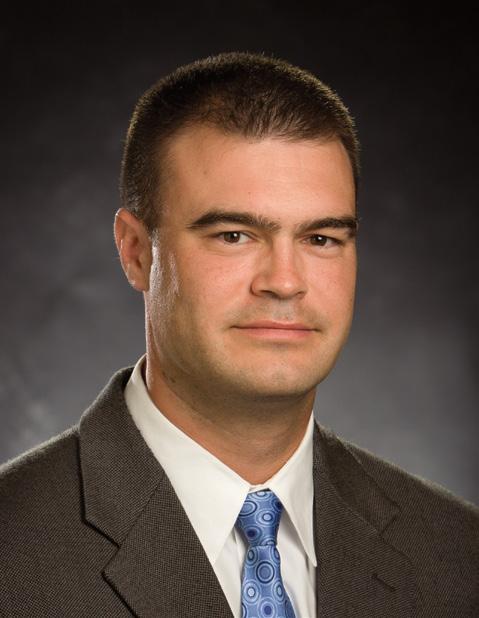
McCullagh and his students at OSU will be working to develop computational workflow to quantify atomic-level allosteric mechanisms. Allostery, referred to as the “second secret of life,” is a poorly understood control knob that can be used to regulate the function of almost any protein. Additionally, as part of this grant, the McCullagh group will develop and disseminate an online chemistry textbook that utilizes coding to help facilitate learning in chemistry.
“I am honored to receive the NSF CAREER award and excited to continue research on allosteric mechanisms in proteins,” McCullagh said. “More specifically, we will attempt to understand how the function of pyruvate kinase, an important enzyme in glycolysis, can be turned on and off by different ligands. The NSF CAREER award also has a focus on education and outreach and, to that end, we are excited to facilitate the uptake of coding in the local chemistry curriculums by developing an online textbook as well as hosting a local, annual workshop for chemistry faculty.”
6 OSU RESEARCH MATTERS 2023
EARLY SUCCESS NSF CAREER AWARDS
Ritesh SACHAN
Leading to Accelerated Discoveries in HighThroughput Ultrafast LaserDriven Processing of High Entropy Alloy Nanoparticles
Sachan graduated with his doctorate from the University of Tennessee. He was a National Research Council research associate at the Army Research Office before becoming an assistant professor at OSU.
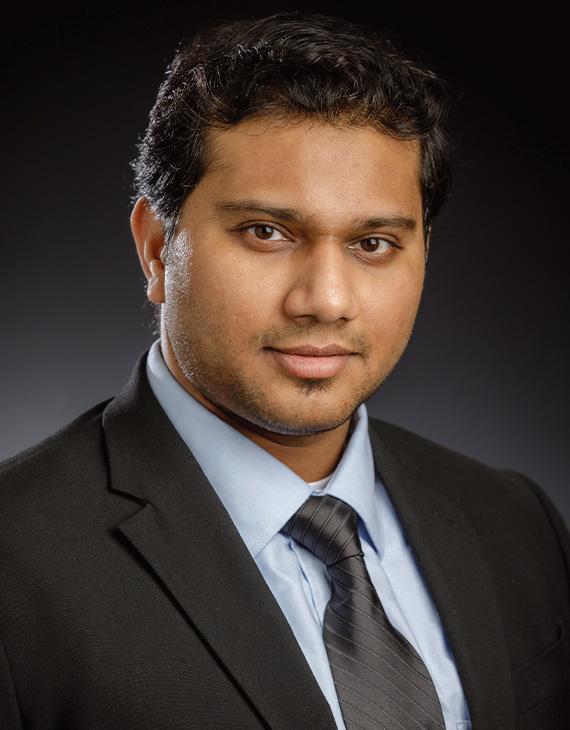
Sachan will be conducting fundamental research in the area of novel nanoparticle composition and its benefits, as well as using new methods to review and understand the microstructure of these nanoparticles.
“It is exciting because we have a pathway forward,” Sachan said. “We know the steps we are going to take. Whether it is successful or not remains to be seen, but it will be an interesting journey.”
Marimuthu ANDIAPPAN
CAS-Climate: Structure-PropertyPerformance Relationships of Iron- and Copper-Based Hybrid Mie-Resonator Photocatalysts for C-C and C-N Coupling Reactions
Andiappan received his doctorate from the University of Michigan. Before coming to the OSU School of Chemical Engineering, he worked as a research scientist at Eli Lilly & Company. His project includes educational activities that build upon the proposed research to infuse photocatalysis and solar energy concepts into the chemical engineering curriculum at OSU.
“It’s an amazing recognition to receive,” Andiappan said. “It is an amazing feeling to have our research recognized by our peers and national agencies like the National Science Foundation. It has provided a lot of confidence to me and my students to move forward and continue this amazing research.”

RESEARCH.OKSTATE.EDU 7
Summer in Bozeman
How an OSU theatre professor is impacting rural arts engagement
Shakespeare in the park productions are typically stationary – meaning people travel to see them. In the summer of 2022, Eric Barker found himself traveling with a mobile production, taking Shakespeare’s plays to the people.

The Oklahoma State University assistant professor of scenic design was awarded a Research Jumpstart/ Accelerator Grant. After his original plans to work with the Richmond Shakespeare Festival in Richmond, Indiana, fell through, he had nowhere to spend the grant, though.

The RJAG is designed to aid faculty in getting their research started following the COVID-19 pandemic. Barker knew he needed to find another research project and did just that, landing the chance to work with Montana Shakespeare in the Parks in Bozeman, Montana.
“I had never been to Montana, let alone lived there for six weeks, so this was going to be a new experience for me,” Barker said. “After I watched PBS documentary about Montana Shakespeare in the Parks, I was sold on
Eric Barker
STORY ERIN MILEK | PHOTO PROVIDED BY ERIC BARKER
Crew members put finishing touches on the final set for the opening production of “King Lear” at Montana State University. Each summer, the two traveling shows open for a weekend run at the campus’s duck pond before they load out for a 12-week summer tour across seven states.
8 OSU RESEARCH MATTERS 2023
this incredible opportunity and could not wait to be a part of this team.”
At OSU, Barker teaches students all aspects of scene design in the College of Arts and Sciences’ Department of Theatre. Drawing on his experience, Barker was brought on as the properties — or props — designer, meaning he oversaw the various materials that the actors carried and utilized on stage. That included all the furniture and set dressings, such as curtains, books and photos.
With productions of “Twelfth Night”— set in post-Hurricane Katrina New Orleans — and “King Lear” — set in 1890s Butte, Montana — Barker had his hands full with research. He needed to fully immerse himself in each era to get a vision for how each prop would fit with each play’s time period.
“Learning the details that surrounded the exact time and location was paramount in order to design the correct period prop for
each production,” Barker said. “I was responsible for designing and building anything from a throne to New Orleans funeral umbrellas.”
Adam Kukic, MSIP production manager, added that in addition to the play’s historical contexts, Barker also had to consider the durability of the props. The items would be used in every production, all summer long.
“From shackles for a prisoner to a fake bloody mary for a party reveler, all items must not only ‘fit’ in the world of the play, but also must be safe and able to withstand nearly three months of outdoor performances while out on tour,” Kukic said.
After opening night on Montana State University’s campus, the 11-person crew packed up the costumes, scenery and props to take the show on a 70-day tour. MSIP visited more than 60 communities and put on more than 77 performances during the summer 2022 season.
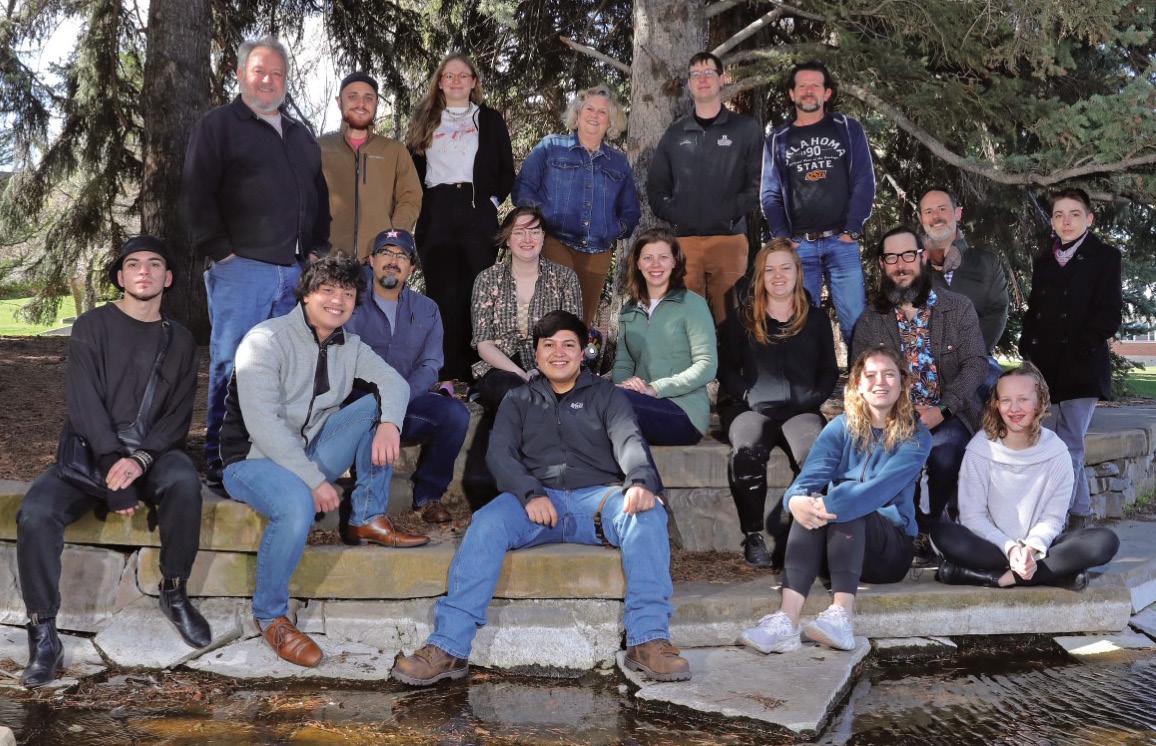
“MSIP is a unique Shakespeare company in that they tour their productions,” Barker said. “Most summer Shakespeare festivals remain in the same location after the show opens and the audience travels to see the show. MSIP focuses on the opportunity to bring productions to rural communities that otherwise might not have exposure to this type of art.”
Barker returned to Bozeman for the summer 2023 season to continue his work with the organization. With productions of “The Three Musketeers” and “Measure for Measure” on the schedule, he once again found himself immersed in history and impacting thousands along the tour route.
“Eric brings much to our creative process,” said Kevin Asselin, MSIP artistic director. “He is insightful, resourceful and is able to bring the highest level of professionalism to our mission.”
Eric Barker (back, third from right) poses with the 2022 Montana Shakespeare in the Park’s full creative team. The team, comprised of designers, stage managers and wardrobe personnel oversee the various artistic elements of the summer’s productions.
RESEARCH.OKSTATE.EDU 9
Intuitions about justice are a consistent part of human nature across cultures and millennia
Thou shalt not kill” may be the most recognizable moral prohibition in societies around the world.
But where does your sense of justice come from?
Throughout history, justice and laws about wrongdoing have been attributed to one god or another. More recently, justice has been traced to moral truths that can be discovered by judges and other legal experts, and to social norms that vary across cultures.
However, our research instead suggests that the human sense of justice, and criminal laws, is generated by the human brain.
Put simply: Being human makes you a decent lawmaker even if you’ve never stepped foot in law school. To an important extent, criminal laws appear to be the end products of gut feelings about justice that are a part of human nature.
Here’s how we investigated just how universal these intuitions are.
TESTING THE HUMAN BRAIN’S SENSE OF JUSTICE
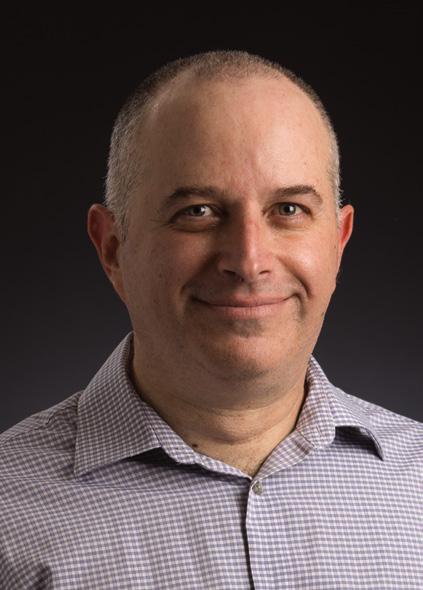
Human conflict ranges from the mild, as when neighbors disagree about the appropriate loudness of music, to the serious, including cases of fraud, robbery, rape, homicide — the stuff of criminal law.
Laws and litigation come in handy when you’re butting heads with someone. But your brain automatically generates intuitions about justice when there is even the potential for conflict, long before you set foot in court. People, even young children, have strong feelings about what counts as a wrongful action and how much punishment a wrongdoer deserves.
These justice intuitions come naturally to everyone. They’re like human lungs or human retinas — part of being human.
So maybe the standard-issue human brain forms the basis of formal and informal justice. If so, a distinctive prediction follows: Laypeople will make decent lawmakers using their sense of justice even when they have no training in law. Further,
laypeople will be able to intuitively recreate core features of actual criminal laws from cultures they are totally unfamiliar with.
We devised a study to test those predictions. We showed participants various offenses drawn from actual criminal codes but not the punishments that the law establishes for those offenses.
Some of the offenses we presented came from a modern and culturally familiar society, drawn from Title 18 of the Consolidated Pennsylvania Statutes. But other offenses were truly ancient and culturally foreign. Some participants evaluated offenses from the Laws of Eshnunna, a 3,800-year-old Mesopotamian legal code — one of humanity’s most ancient legal codes. Other participants saw offenses from the Tang Code, a 1,400-year-old legal code from China.
These archaic laws are the next best thing to time travel. They are like fossils that preserve the legal thinking of ancient lawmakers.
To give some examples, some of the Eshnunna offenses shown to participants included: biting out the eye of another man, seizing a boat fraudulently and failing to keep one’s aggressive ox in check, resulting in a slave being killed by the ox. Such were the offenses of an ancient Mesopotamian society.
Despite the massive cultural differences between the ancient city-state of Eshnunna and modern societies, if the sense of justice, and laws, originates in the human brain, then the king who decreed the Laws of Eshnunna and the participants in the study may be of one mind.
So, next we asked participants to rate each of the offenses they saw. Some participants were asked to imagine they were lawmakers; they were asked to mock legislate the fines each offense would deserve by law. Other participants mock legislated prison sentences for each offense. To make sure
STORY DANIEL SZNYCER AND CARLTON PATRICK | PHOTO PHIL SHOCKLEY
FACULTY AUTHORED STORY FROM THE CONVERSATION
“
10 OSU RESEARCH MATTERS 2023
Daniel Sznycer
participants were giving their untrained intuitions, we excluded from analyses participants who attended law school.
Indeed, the Eshnunna king and the participants in our study did display a shared sense of justice. The more study participants judged an ancient offense as serious, the higher the actual punishment provided by law for that offense.
This match between participants’ intuitions and ancient laws wasn’t perfect, but it was substantial. It suggests that human beings share a sense of justice, and that people today can recreate the core of criminal laws from faraway societies that are thousands of years in the past.
CULTURAL EFFECTS ON THE SENSE OF JUSTICE
A shared sense of justice that is part of human nature does not deny cultural differences.
Consider this Tang offense: “All cases of a master who kills a slave who has not committed an offense are punished by one year of penal servitude (NB: redeemable by paying a fine of 20 copper chin).” The Tang Code considers this offense to be relatively mild – consider, for example, that “beating and killing a person in an affray” was punished by the Tang Code with strangulation or a fine of 120 copper chin. In contrast, study participants judged “killing a slave who has not committed an offense” a very serious transgression.
And yet, participants’ intuitive responses generally matched the responses called for in the ancient criminal codes. For instance, participants agreed with the Tang lawmakers that beating and killing a person in a fight is a worse offense than betting goods and articles in games of chance.
To us, this mix of cross-cultural differences and similarities suggests that the brain machinery that generates the sense of justice combines universal principles with open parameters that are filled in with local information. The universal principles may explain why participants generally saw eye to eye with the Eshnunna king and the Tang lawmakers. The open parameters may explain cultural variation.
EVOLUTIONARY ROOTS OF A SENSE OF JUSTICE
Conflict is evolutionarily ancient. Organisms, including nonhuman animals, can offend against others — for example, by preying on them. And so natural selection would have endowed organisms with means that help them solve conflicts in their favor: fangs, antlers, neurotoxic venoms. These defenses and weapons are useful. Our ancestors lived in a world without police, and so they had to be their own police if they were to survive and thrive.
But human conflict is special. With their ingenuity and knack for cooperation, people can produce a huge array of goods and services that other people can swindle, rob, adulterate, counterfeit, embezzle and destroy. So, the scope of human conflict is vast.
Brawn may help in human conflict, but brain is key. Humans live in an information-dense world, where it’s important to know precisely how much harm is being done to you when someone offends against you. Accurately appraising wrongs allows victims to demand or deliver an amount of punishment that is, as in the story of Goldilocks, just right: neither too small that an undeterred offender will re-offend, nor too great that the offender will counter-punish the original victim. Our human ancestors didn’t have price
tags or written laws to appraise wrongful actions, so they needed to appraise wrongful actions with their brains.
The brain mechanisms for appraising wrongdoing appear to be part of human nature — the same in all times and places humans have lived in. Of course, justice intuitions and criminal laws vary across cultures. Grand theft auto wasn’t appraised in Sparta because there were no cars 2,500 years ago. Written criminal laws are absent in societies without writing systems.
Nevertheless, the human sense of justice seems to be fundamentally similar across space and time. And criminal laws everywhere may be shaped by a sense of justice and offense-appraising mechanisms that are universal — akin to how universal mechanisms of taste perception give rise to the world’s diverse cuisines.
Daniel Sznycer, assistant professor of psychology at Oklahoma State University, and Carlton Patrick, assistant professor of legal studies at the University of Central Florida, wrote this story in partnership with The Conversation. The Conversation is a nonprofit news outlet dedicated to sharing research from experts like those on our faculty.
CHECK THIS OUT: Interested in other OSU faculty stories? Read more at okla.st/theconversation RESEARCH.OKSTATE.EDU 11
Impact of Undergrads
Annual Undergraduate Research Symposium highlights importance of student work

No matter where students find themselves in their academic careers at Oklahoma State University, they can take part in groundbreaking research.
For undergraduates, that research was on display in April at the annual Undergraduate Research Symposium.
The symposium is an opportunity for undergraduate students from all academic disciplines to present what they have learned through their research experiences to the OSU-Stillwater community.
“Undergraduate students who participate in research activities and programs under the direction of a faculty sponsor gain important skills that can be
transferred to other professional activities,” said Dr. Christine Johnson, associate vice president for research and one of the key organizers for the event. “For example, they learn to think and work like a scientist by employing critical thinking and problem-solving skills.”
Providing space for students to share their research, scholarship and creative activity with others is pivotal to highlighting the connections between research and learning in the academic classroom.
Events like the symposium also help students make deeper connections with their peers and other faculty at the university, which increase retention and graduation rates, Johnson said. She
STORY HARRISON HILL | PHOTOS PHIL SHOCKLEY
12 OSU RESEARCH MATTERS 2023
Electrical engineering student James Boudreaux explains his project at the Undergraduate Research Symposium.
also mentioned another reason OSU hosts the annual symposium.
“Symposiums are fun!” Johnson said.
The URS symposium included seven sessions, each one hour, organized by a broad discipline area.
“Most of our students gave poster presentations, which are highly interactive with attendees reviewing the posters and asking questions of the students,” Johnson said. “It was a high energy event with so much engagement by those who attended. We had parents, grandparents, faculty, graduate students, staff members, fellow students and community members in attendance.”
Landon Edwards, a psychology senior, presented his research on how testing environment impacts students’ sense of test anxiety at the symposium.
For Edwards, undergraduate research is a steppingstone for his future goals.
“A big motivator [to get into undergraduate research] was the dream of going to a graduate program,” Edwards said. “A lot of graduate programs are research heavy, so they love looking at your curriculum vitae and seeing that you can develop projects, you can follow through and overcome.”
Edwards said he presented his first big poster presentation during last year’s undergraduate research symposium.

“It’s a little bit of a hurdle at first, just trying to make sure you know what to say and you’re confident you remember the information. But I think once you get over it, it’s so much easier,” Edwards said.
Dr. Kenneth Sewell, OSU vice president for research, attended a handful of the morning sessions to talk with students and learn about their research.
“What impresses me the most is the breadth and the depth,” Sewell said. “The breadth of topics that these students are studying, but also when you talk to them individually, the depth of their understanding and their ability to communicate is truly top-notch. It’s every bit high quality as if you were going to a graduate seminar and these are undergraduates, so I am extremely impressed.”
The symposium is held each April to align with Undergraduate Research Week. The week was formally recognized on Nov. 16, 2010, by the U.S. House of Representatives to celebrate the work undergraduates do across the nation.
“We encourage students from all disciplines to participate,” Johnson said. “You can be doing a humanities project,
a visual arts project or a social science research study.”
There are three presentation formats available for students to choose from: poster, oral flash talk or a short video for performing and visual arts. However, one of the most important aspects of the event comes the day after.
“If you ask the student participants, they will convey the unique aspect of our symposium is that they receive written feedback a day after the event,” Johnson said. “Thanks to about 85 graduate students and professional staff members, presenters received formative feedback on the presentations.”
From the breadth of presentation options, the diversity of research topics allowed, to the feedback provided, the symposium is focused on helping the students.
“I think it’s definitely been very beneficial, looks great on my curriculum vitae, and it’s given me skills I’m able to transfer over elsewhere,” Edwards said. “Just being more comfortable with public speaking and following through with projects, it shows that I have the determination and dedication to complete things that I’m interested in researching.”
“Undergraduate students who participate in research activities and programs under the direction of a faculty sponsor gain important skills that can be transferred to other professional activities.”
DR. CHRISTINE JOHNSON, ASSOCIATE VICE PRESIDENT FOR RESEARCH
Civil engineering student Daisy Rosas explains her presentation to a passerby at the Undergraduate Research Symposium.
RESEARCH.OKSTATE.EDU 13
PILLARS OF RESEARCH
Oklahoma State University’s We Are Land-Grant strategy identifies its four interdisciplinary priority areas as:
• Leading in Aerospace Innovation and Application
• Innovating to Nourish the World
• Enhancing Human and Animal Health (One Health)
• Powering a Growing World Population
Sustainably and Responsibly
These areas of priority are not only of great importance to the state and the communities OSU serves, but they also represent the fundamental research strengths already in place at the university. So, this section of OSU Research Matters has been organized to focus on these critical priorities.
OSU’s leadership to Nourish the World is most obviously exemplified by its prominent research in production agriculture as well as in nutrition. But as with all these priorities, other — perhaps less obvious — disciplines play important roles as well. Researchers in business, entrepreneurship, basic chemistry and biology, engineering, water management, and even political science all impact how the university can best nourish our world’s growing population. OSU has experts in all these domains.
Aerospace Innovation and Application at OSU easily invokes its mechanical and aerospace engineers as well as the aviation programs that
focus on flight training and aviation business. But this focus also includes other disciplines within engineering such as materials science and engineering, electrical engineering and industrial engineering … as well as social sciences that investigate societal acceptance, policies and entrepreneurial supports required to move forward with innovative technologies in the advanced air mobility sector (urban air taxis, drones for package deliveries, etc.).
People need look no further than the COVID19 pandemic to appreciate the fundamental linkage between human and animal health, or One Health. OSU’s expertise in veterinary medicine, physiology, microbiology, pathobiology and toxicology plays a fundamental role in this arena while bioengineering, entrepreneurship, as well as basic chemistry and biology, all play important supporting roles.
In the energy sector (Powering a Growing World), OSU’s strengths are vast and growing. From electrical engineers and petroleum engineers to geologists, chemists and even energy accountants, OSU’s expertise in energy runs the gamut from traditional oil and gas exploration and extraction technologies to cutting-edge energy transition topics such as solar, wind, hydrogen, next-generation batteries, rare earth elements and critical minerals.
This section shares just a few examples of OSU’s depth and strength in these four areas.
14 OSU RESEARCH MATTERS 2023
HEALTH POWERING
FUTURE 16-22 23-29 30-36 37-45 RESEARCH.OKSTATE.EDU 15
AEROSPACE FOOD SUSTAINABILITY ONE
THE
OSU’S HIGH-ALTITUDE BALLOON PROJECT AIDING IN VENUS EXPLORATION
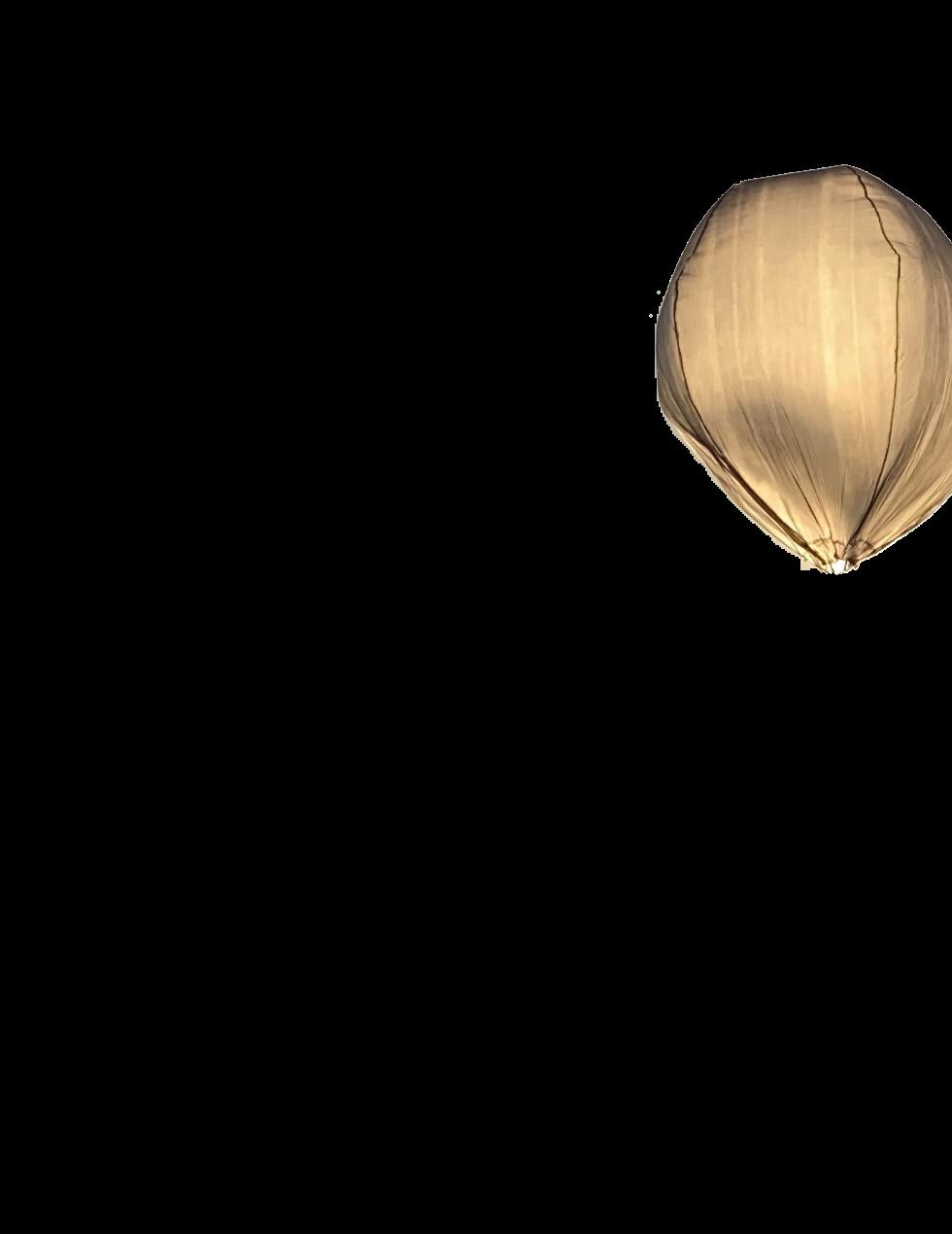
One hundred and twenty minutes. That’s how long something can survive on the surface of Venus — a record set by a Soviet Union probe in 1981 — due to the extreme surface temperatures and pressure.
Although Venus is believed to have a structure like Earth and there’s been a long history of wanting to study seismology on Venus, doing such research on the surface is almost impossible. However, in the planet’s upper atmosphere, there’s a region Earth devices can survive in.
Dr. Brian Elbing, Oklahoma State University associate professor of mechanical and aerospace engineering, has studied low frequency sounds — aka infrasound — from tornadoes for many years. Elbing’s research on the sounds below human hearing caught the attention of an OSU alumnus working at Sandia National Laboratories.
The two connected, which eventually led to a series of conversations that ultimately put Elbing and Dr. Jamey Jacob — executive director of the Oklahoma Aerospace Institute for Research and Education, Williams Chair in Energy and professor of aerospace engineering — on a proposal with the NASA Jet Propulsion Laboratory and Sandia to fly high-altitude balloons, or heliotropes.
“They wanted to do it in Oklahoma, but a concern of the funding agency was that they didn’t have sufficient flight support in Oklahoma to handle the logistical challenge of flying so many balloons in Oklahoma,” Elbing said. “And so, the timing was perfect with setting up this meeting. I said, ‘We have tons of aerospace capabilities and launch capabilities.’ So, the NASA Jet Propulsion Laboratory and Sandia National Laboratories added us on the proposal.”
NASA JPL proposed to fly high-altitude balloons on Earth measuring infrasound from earthquakes.
STORY SYDNEY TRAINOR | PHOTOS DR. BRIAN ELBING AND GARY LAWSON AEROSPACE 16 OSU RESEARCH MATTERS 2023
Theoretically, they could send a balloon to the upper region of Venus and use the same payloads to be able to understand if there’s Venusquakes, volcanic activity, storms or any type of natural phenomena with infrasound.
In 2021, OSU worked on a campaign with Sandia National Laboratories and NASA JPL with the goal of targeting small earthquakes using heliotropes. For two summers they launched over 80 balloons.
OSU was supposed to have a relatively small piece of this project, but due to the capabilities of the department, they continually got larger pieces of the project and now are responsible for every launch.
“It’s very much a testament to us, it was a relatively small opportunity, where we just did what we did and we keep getting more and more work,” Elbing said.
OSU has continued the infrasound project and is researching ways of

STATEMAGAZINE.OKSTATE.EDU 17
“
‘We have tons of aerospace capabilities and launch capabilities.’ So, the NASA Jet Propulsion Laboratory and Sandia National Laboratories added us on the proposal.”
DR. BRIAN ELBING , OSU ASSOCIATE PROFESSOR OF MECHANICAL AND AEROSPACE ENGINEERING
RESEARCH.OKSTATE.EDU
OSU balloon launch team. From left: Zach Yap, Conner Heffernan, Leo Fagge, Kate Spillman, Taylor Swaim, Madison Morton, Jack Elbing, Emalee Hough, Payton Simmons, Madison Hill, Stephen Young II, Jarrett Schwartz, John Clemmons and Nicco Wang.
improving the measurements at altitude of the balloons, Elbing said.
DROWNING OUT THE NOISE
Stratospheric wind blows east most of the year, but from late May to September, it shifts to the west, which is ideal to launch balloons due to Oklahoma’s landscape.
A typical launch day is sunny with calm winds, but for Taylor Swaim, a mechanical and aerospace engineering graduate student, wind noise is important for her NASA funded project to explore wind screens for the payloads.
A standard payload package has a microbarometer, which measures slight changes in pressure including the change in pressure due to sound, Swaim said.
The heliotropes Swaim and the OSU ballooning team launch have a high drag coefficient, so they float in the wind leaving the relative wind on the upper payload small. However, a long flight line is needed to resolve the angle of arrival from the signal. With that long line comes more wind noise, which
becomes more amplified on Venus, Swaim said.
“Noise is one of the biggest issues with capturing infrasound signals, because wind is present everywhere and it will swamp out the signals we’re trying to find. I’d say that’s one of the most difficult parts with measuring infrasound,” Swaim said. “They’ve measured vertical gusts on Venus that are up to 3.5 meters per second.
“So, our goal is to identify a compact, lightweight windscreen solution that can reduce wind noise without having any signal suppression.”
First, the project needs to find a design that works on heliotropes, which have about 3.25 kilograms of flight line weight. To combat that, Swaim is researching current ground wind mitigation and more compact methods that have been successful.
She has identified two porous materials that have worked well. Using a specific type of canvas material and polyurethane foam, Swaim created three different models to test on a standard payload.
CONTROLLING TRAJECTORY
The team continues to solve the noise problem, but the next step is learning how to guide the heliotropes in the air.
Once launched, the balloons take two hours to reach float altitude — between 60,000 and 70,000 feet — and will float for close to 12 hours in the direction of the wind.
“Currently, there is not a way to predict the exact trajectory of the balloons,” said Emalee Hough, a mechanical and aerospace engineering graduate student and team lead.
Using current wind direction and the weight of the entire system, the team can predict the expected altitude and therefore get the general idea of where the balloon will land. However, a shift in wind can change the course quickly.
“My idea is to add a little bit of control to the balloon by adding a top vent,” Hough said. “Most of our balloons have an open mouth to allow the air to recirculate. But we want to use the vent system to control altitude. When it hits a specific altitude, the vent opens to decrease altitude and then it’ll close back up and get buoyant again because we
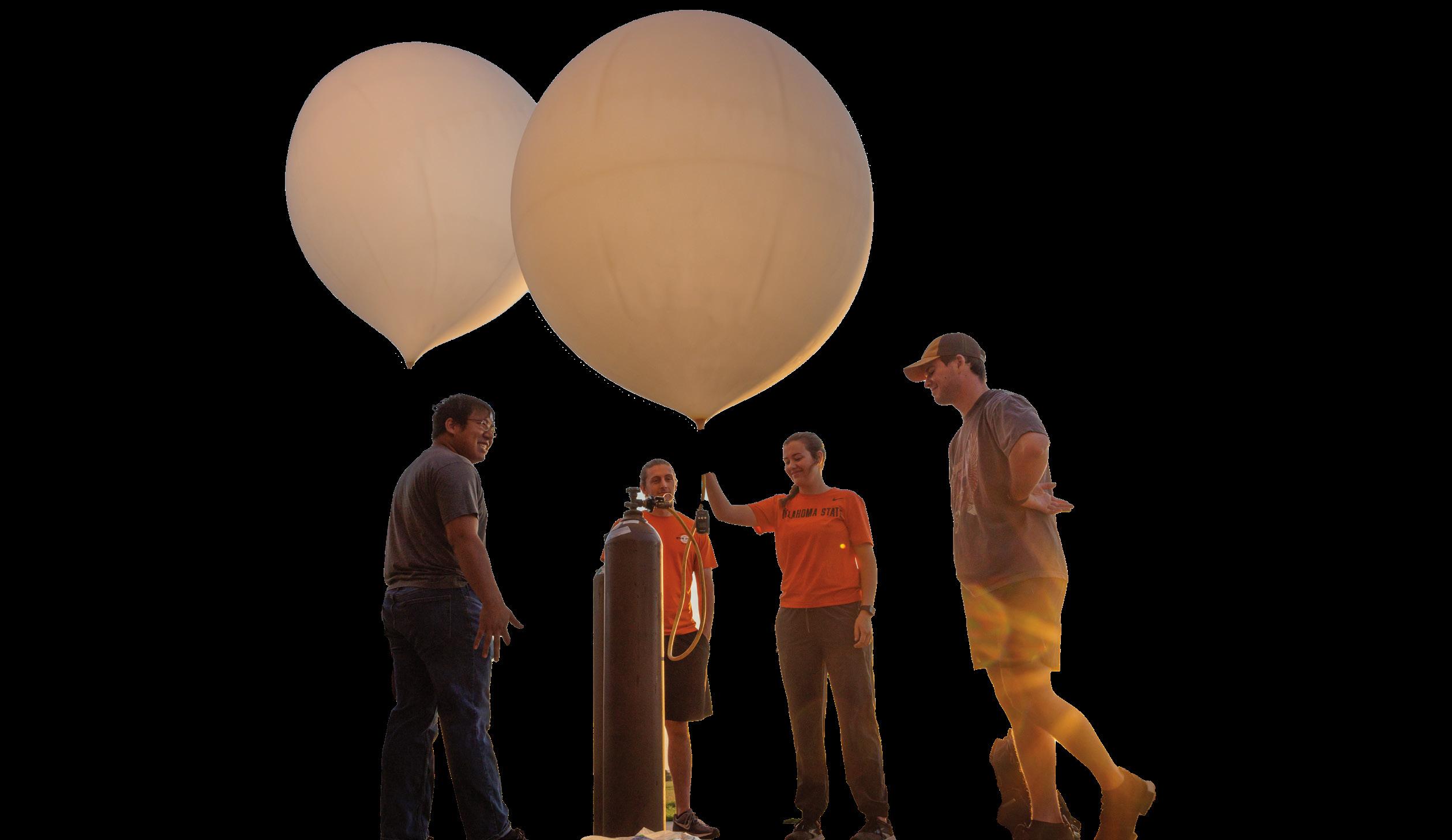
18 OSU RESEARCH MATTERS 2023
Unmanned Systems Research Institute students Zach Yap, Karrick Ray, Emalee Hough and Jarrett Schwarz prepare a pair of helium-filled balloons for a “grand slam” launch at the Unmanned Aircraft Flight Station east of Stillwater.
have the circulation of the air coming in.”
This control will eventually allow Hough to keep multiple floating balloons together, which will help make triangulating the infrasound source more accurate.
“Our balloons have two infrasound sensors separated by 100 feet or 30 meters of string. But we know that the way that it propagates across, it should be like a 0.1 second delay between the two sensors. And then you can use that to identify a circle of where the source is located,” Hough said.
KEEPING IN TOUCH
Currently, the balloons use low power long range radio (LoRa) for communication.
LoRa sensors allow for transmitting small size payloads over long distance using greater communication range with low bandwidths for wireless data transmission technologies.
Mechanical and aerospace engineering graduate student Zach Yap
is researching communication methods from balloon-to-balloon and balloon-toground looking for ways of improvement.
LoRa uses chirps with a unique signature, which allows Yap to pull out the signal even if it’s below the noise floor, giving more range for less power output, he said. The team has had some success with this method but is hoping to test it in more flight scenarios.
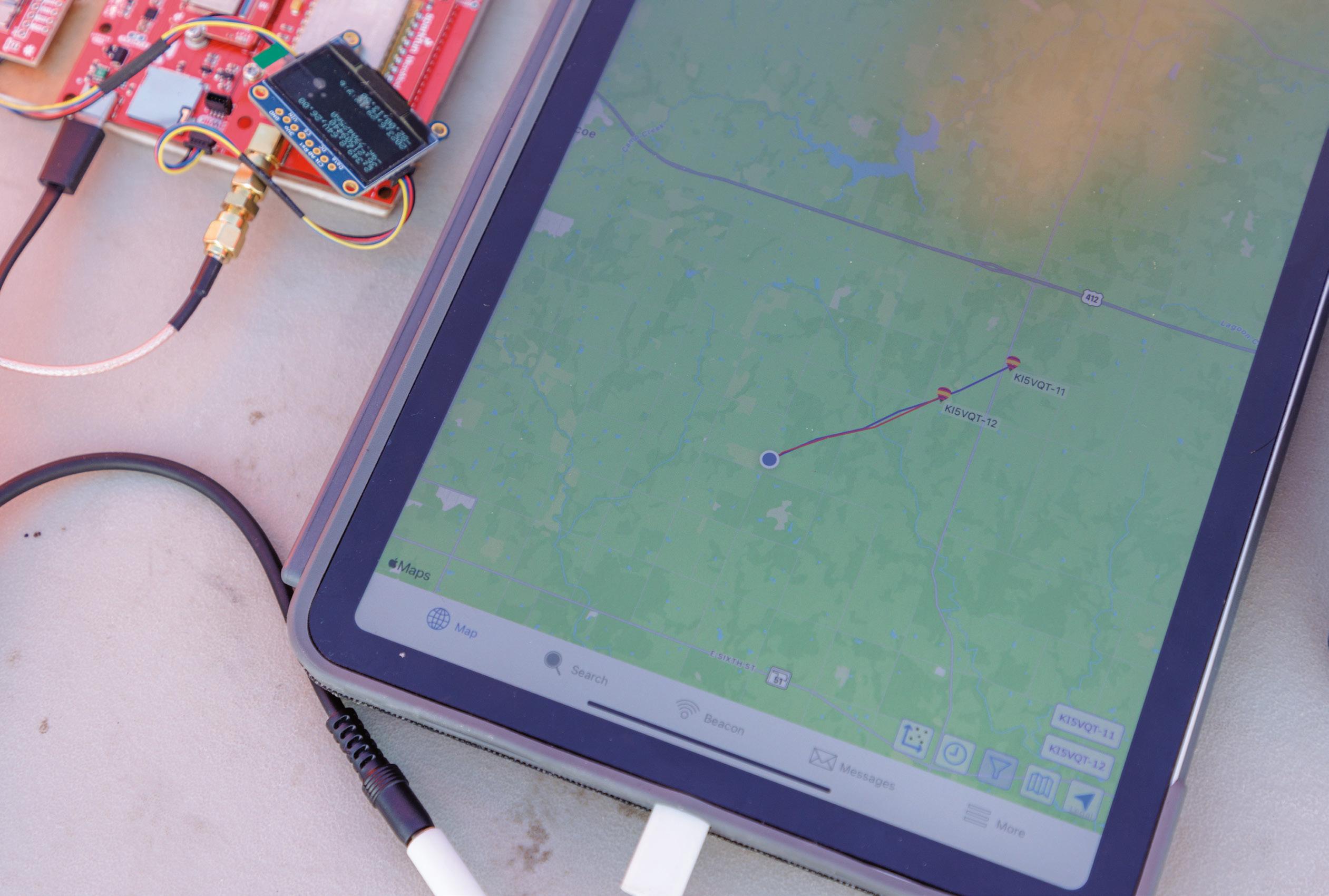
“My research idea is we have two balloons that can communicate and coordinate both information and location so that Emalee’s venting system can have the balloons maintain altitude, which that difference in altitude is the driving force behind why balloon separate,” Yap said. “If we can keep the balloons together, then we have this operating swarm of balloons, which then works with Taylor’s windscreens. So, then we can have multiple sensors that can triangulate the location of an event.
“There’s a window in time when we launch those balloons where we can accurately backtrace where the balloon
and the earthquake location is and that’s really determined by how far the balloons are apart. What we want to do is eventually get to a point where we can keep the balloons together to increase that duration of time when we can accurately do that back tracing.”
Yap leads the technical instrumentation side of the projects and coordinates with the Federal Aviation Administration for each launch.
“We have launched over 80 balloons in the last two years, and that’s shown Oklahoma State has developed this capability to a level that’s repeatable and reliable,” Yap said. “Of those 80, every single balloon that was intended to be recovered has been recovered. So, we have a 100% recovery rate and that’s a good demonstration to companies like Sandia, like JPL, who are interested in using these balloons as a lower cost research effort, that this is a low risk to other methods and for a lower cost.
“It opens a lot of doors for research that we can get funded and get grants to do.”
RESEARCH.OKSTATE.EDU 19
Once the balloon is launched, the team tracks the trajectory using the automatic packet reporting system signals.
IN THE OAIRE TONIGHT
OSU CUTS RIBBON FOR LAUNCHPAD CENTER FOR ADVANCED AIR MOBILITY WITH TULSA INNOVATION LABS AND OSAGE NATION
Oklahoma State University is taking the next step in drone research with a new facility. On June 30, OSU and partners — including Tulsa Innovation Labs and the Osage Nation — celebrated a ribbon-cutting at the LaunchPad Center for Advanced Air Mobility at OSU-Tulsa’s Helmerich Research Center.
The LaunchPad Center will house dedicated resources to promote the development of new technologies in advanced air mobility, including staff to solicit projects from industry, engineers and researchers to build new products, and supporting services to help commercialize technologies and grow new companies.
Local, tribal, state and national leaders — including representatives from the Department of Defense, Tinker Air Force Base, the Federal Aviation Administration and the U.S. Economic Development Administration — were on hand for the event, which culminated in an unmanned aerial systems demonstration.

“A key pillar of Oklahoma State University’s strategy is leading in aerospace and aviation innovation, but we know our success is shared success,” OSU President Kayse Shrum said. “This is why we are so excited about our strategic partnerships with NASA, Tulsa Innovation Labs, and Osage LLC, an Osage Nation enterprise. Additionally, the U.S. Economic Development Administration recognizes that taking Oklahoma’s aerospace and aviation to the next level has national benefits, and we appreciate the agency’s critical support.”
The LaunchPad Center will support the development and deployment of emerging aviation technologies, including unmanned aerial systems with uses ranging from critical infrastructure inspection and agricultural monitoring to emergency response and last-mile delivery. Given Tulsa’s strategic position as an urban hub in a rural region, the LaunchPad Center will also focus on developing new air transportation systems to safely and sustainably move people and goods in places currently underserved
STORY SHANNON RIGSBY | PHOTOS GARY LAWSON AEROSPACE 20 OSU RESEARCH MATTERS 2023
by aviation, including rural and tribal communities.
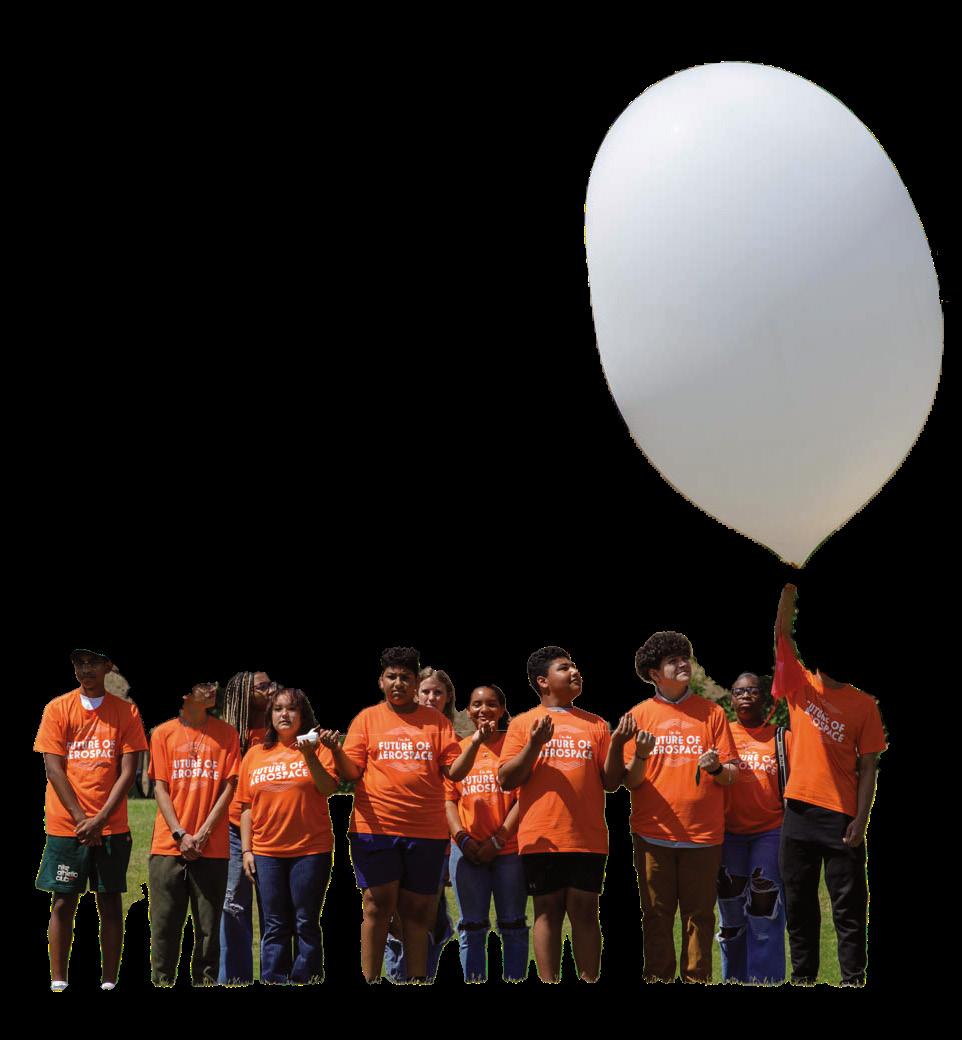


“Aviation is entering its third ‘golden age’ and the LaunchPad Center for Advanced Air Mobility is on the cusp of translating research into significant industry advancements,” said Dr. Jamey Jacob, executive director of the Oklahoma Aerospace Institute for Research and Education, director of the Counter-UAS Center of Excellence and professor of mechanical and aerospace engineering at OSU. “OAIRE and the creation of the LaunchPad Center under the OAIRE umbrella will bridge the gap between early stage research and applied technology, deploying developments to improve industry, the economy and to move the research tied to aviation and space forward.”
Jennifer Hankins, deputy managing director of Tulsa Innovation Labs, said they were thrilled to see this vision come to life.
“Not only will the LaunchPad Center position Tulsa and northeast Oklahoma for global competitiveness in advanced air mobility, but equally
important is the signal this moment sends to our local community,” Hankins said. “This investment in OSU-Tulsa is part of our commitment to supporting the ongoing revival of Tulsa’s Historic Greenwood District, where the center will be located. We are eager to see this project inspire Tulsa’s next generation of innovators, entrepreneurs and young people interested in careers in the next wave of the aerospace and aviation industries.”
The LaunchPad Center will be housed with state-of-the-art research and development laboratory assets in the HRC, capitalizing on the campus’ strategic location, educational connections and industry partnerships. LaunchPad’s first industry partner, WindShape, will create an environmental test facility in the HRC, gathering data on any conditions UAS will experience while in flight but in a controlled laboratory environment. This includes environmental test facilities to evaluate drones in wind, rain, icing and wildfire conditions.
The LaunchPad Center is one of four projects under the new Tulsa Regional Advanced Mobility Cluster, which received $38.2 million in funding from the Economic Development Administration’s Build Back Better Regional Challenge. This grant also created the Skyway Range, a flight test facility which connects the Osage Nation and its enterprises’ Skyway36 Droneport in Tulsa, OSU’s Unmanned Aircraft Flight Station near Stillwater and two additional nodes in the region to create an unparalleled asset for testing and evaluation of new technologies.
The Skyway 36 Droneport, a working airport where OSU research is already under way, is now fully dedicated to advanced air mobility applications. It will include immediate access to manufacturing space and allow researchers to work hand-in-hand with industry to advance innovation seamlessly and quickly.
“Exposing our youth to emerging aviation technologies is critical for the next generation to be competitive in advanced air mobility,” said Osage Nation Principal Chief Geoffrey Standing Bear. “Osage Nation Education and STEAM departments have laid a strong foundation for these opportunities through strategic partnerships such as this, and we are excited for the LaunchPad Center to be a resource to continue this forward momentum.”
STATEMAGAZINE.OKSTATE.EDU 21
East Central High School aerospace students participate in the drone demonstration in June on the campus of Oklahoma State University-Tulsa.
RESEARCH.OKSTATE.EDU
TO SEE THE IMPACT THE OAIRE LAUNCHPAD WILL HAVE, GO TO okla.st/launchpad
With the oldest aerospace engineering program in the state, more than 80 years training pilots and 50 years partnering with NASA, Oklahoma State University’s depth and breadth of knowledge in the aerospace industry is extensive and unmatched. Now, through the Oklahoma Aerospace Institute for Research and Education, OSU is bringing the state’s aerospace ecosystem together under one umbrella.
OAIRE connects multiple centers including the Counter-UAS Center of Excellence, LaunchPad Center for Advanced Air Mobility, NASA STEM Pathway Activities Consortium for Education (NSPACE), and Oklahoma CubeSat Initiative (OKSat) to form a unique hub under the guidance of Dr. Jamey Jacob. Through additional support and leadership under OAIRE, these centers will serve as a valuable resource for growing Oklahoma’s aerospace industry by generating high-tech jobs and cutting-edge research that brings commercial enterprise, military sustainment support, and small business entrepreneurship across Oklahoma.
In addition to leading aerospace innovation today, OAIRE also focuses on building the future of aerospace in Oklahoma through K-12 outreach programs focusing on STEM connection and generating student and community involvement in the industry with the goal of transforming Oklahoma’s aerospace workforce for the 21st century.

Through public-private partnerships and cross-industry collaborations, transitioning groundbreaking discoveries to application, and engagement with under-represented communities, OSU continues to build the future of aerospace and invest in the future of Oklahoma.

OAIRE.OKSTATE.EDU
Agricultural experiment stations are managed by landgrant universities, and each state is home to at least one land-grant institution.
The Hatch Act of 1887 established an agricultural experiment station in every state to support and maintain a permanent and effective agricultural industry.
Experiment station scientists work collaboratively with farmers, ranchers, agriculture and food industry professionals, and others involved
FERGUSON COLLEGE OF AGRICULTURE
in food production and agriculture. Federal and state governments and private industry fund research conducted at these stations. These grants, contracts and the sale of products grown or raised at the stations are key sources of funding.
Oklahoma State University Ag Research maintains 16 locations across the state that include more than 40 facilities, along with five centers and institutes. More than 260 full-time equivalents are invested, including scientists and in-field

OSU Agricultural Research Stations
• Agronomy Research Station, Stillwater
• Animal Nutrition and Physiology Center, Stillwater
• Bluestem Research Range, Stillwater
• Caddo Research Station, Fort Cobb
• Cimarron Valley Research Station, Perkins
• Controlled Environmental Research Laboratory, Stillwater
• Entomology and Plant Pathology Farm, Stillwater
• Feed Mill, Stillwater
• Kiamichi Forestry Research Station, Idabel
• Lindley Research & Demonstration Farm, Valliant
• Logan Research Station, Haskell
• Marvin Klemme Range Research Station, Bessie
• McCaull Research & Demonstration Farm, Eva
• Mingo Valley Research Station, Bixby
staff working at these stations. They study wildlife; forestry; soil fertility, nitrogen and water use efficiency; animal and plant nutrition; and the management of crops, livestock, pests and diseases. They also study other topics geared toward food and economic sustainability.
Research conducted through OSU Ag Research helps address global issues, such as food and water shortages, economic vitality and environmental preservation.
• North Central Research Station, Lahoma
• Oklahoma Panhandle Research and Extension Center, Goodwell
• OSU Range Research Station, Stillwater
• Range Cow Research Center, Stillwater
• Sandyland Research Station, Mangum
• South Central Research Station, Chickasha
• Southwest Research and Extension Center, Altus
• Stored Products Research and Education Center, Stillwater
• Swine Research & Education Center, Stillwater
• Tipton Valley Research Station, Tipton
• Turf Research Center, Stillwater
• Wes Watkins Research and Extension Center, Lane
• Wheat Pasture Stocker Unit, Stillwater
• Willard Sparks Beef Research Center, Stillwater
AGRESEARCH.OKSTATE.EDU/FACILITIES
NURTURING NUTRITION
RETIRED CEHS
PROFESSOR REFLECTS ON CAREER OF PROMOTING NUTRITIONAL STUDIES


STORY KIRSI MCDOWELL | PHOTOS PHIL SHOCKLEY FOOD SUSTAINABILITY 24 OSU RESEARCH MATTERS 2023
Early in Dr. Barbara Stoecker’s career, she witnessed malnourished children living on the streets of Jamaica.
The trip was part of a 4-H International Farm Youth Exchange, and while Stoecker enjoyed immersing herself in the Jamaican culture during her seven months there, the thought of those children was always on her mind.
It was 1965, and Stoecker, who had just earned her bachelor’s degree in home economics education from Kansas State University, had a new area of focus: nutrition.
After Stoecker earned her Ph.D. in nutrition from Iowa State University in 1970, she set herself down a path that would last more than 50 years, culminating in her retirement from Oklahoma State University in May 2023.
Stoecker finished her career as a Regents Professor and Marilynn Thoma Chair for the College of Education and Human Sciences’ Department of Nutritional Sciences after a 36 year-long tenure with the university.
However, her career started after her graduation from ISU as a postdoctoral teacher and researcher. Stoecker and her husband, Arthur, set off for Thailand for the next four years, where her extensive experience in working on international issues truly began.
She joined the National Nutrition Institute and was based out of the Department of Pediatrics at
TIMELINE OF A HEALTHY CAREER:
1965: Earned her bachelor’s degree in home economics education from Kansas State University
1970: Earned her Ph.D. in nutrition from Iowa State University.
Ramathibodi Hospital in Bangkok. There, she delved deeper into the issues of childhood malnutrition, joining studies in vitamin A needs of preschoolaged children.
When Stoecker returned to the United States, she took a position at Texas Tech University where she earned her tenure. Eventually, Arthur was contacted about a position at OSU that would mark a significant moment in her own career.
Unsure of the change, but intrigued by OSU’s history in international research, Stoecker reached out to friends and colleagues to get insight about the university and the department.
At the time, Dr. Esther Winterfeldt served not only as department head of nutritional sciences at OSU, but also as president of the American Dietetic Association; Stoecker recalls being told “If Dr. Winterfeldt is there, it’s a place you want to be.”
MOVING TO STILLWATER
In 1987, Stoecker officially joined OSU’s Department of Nutritional Sciences.
Her career largely focused on micronutrient research in children’s health and chronic disease and the study of trace minerals as they pertain to human nutrition. She became the department head of nutritional sciences from 1993 to 2001.
There, Stoecker recalls how much the department changed, including
1987: Officially joined Oklahoma State University’s Department of Nutritional Sciences.
1993-2001: Served as dept. head of Nutritional Sciences.
2010: Appointed the Marilynn Thoma Chair
2016: Inducted into the Oklahoma Higher Education Heritage Society
2023: Retired from OSU.
living through the renovation of the nutritional sciences laboratory.
“The space was down to bare bones,” Stoecker said. “We spent about 18 months working out of small cubbies.”
Although the transition to the new space presented its challenges, she thanked former dean Dr. Patricia Knaub for cajoling supporters for the funds to make vital improvements to the space.
“The lab space still serves students well today,” Stoecker said. “The idea was to promote collaboration through an open lab space while providing each investigator with their own bench.
“It’s created a really nice culture amongst the graduate students to help one another in their research.”
Until her retirement, Stoecker helped to oversee the Cellular and Molecular Nutrition Lab and managed specific pieces of the hightech equipment available for use by researchers across the OSU system.
STATEMAGAZINE.OKSTATE.EDU 25
“Dr. Stoecker’s professional dedication, devotion and humility has inspired so many of us to contribute what we have to offer to the field of nutrition. She is not only an excellent mentor with farsighted leadership, but has become a genuine family friend over the years.”
DR. YEWELSEW ABEBE, PROFESSOR AND ASSOCIATE VICE PRESIDENT FOR RESEARCH AND DEVELOPMENT AT HAWASSA UNIVERSITY
RESEARCH.OKSTATE.EDU
Regents professor Dr. Barbara Stoecker was appointed the Marilynn Thoma Chair in 2010.

She specialized in the Scanco Medical mCT 40, a unit designed to scan small bone specimens for the creation of three-dimensional models to assess the bone’s structural and biomechanical properties without damaging the original, as well as the Perkin-Elmer Elan 9000 Inductively Coupled PlasmaMass Spectrometer (ICP-MS).
The ICP-MS is used to determine amounts of trace elements present only in the parts per billion range in the analysis of biological and environmental samples, such as blood, serums, food, water and soil.
INTERNATIONAL STUDIES
Stoecker eventually returned abroad as part of OSU trips, going to China, Jordan and Iraq, as well as Ethiopia where she has focused much of her research in micronutrients as it pertains to the health of children.
Stoecker was part of a cohort of professors sent to Ethiopia to assist in establishing a master’s program in applied human nutrition. At the time of their arrival to Hawassa University in Awassa, Ethiopia, the only similar offering was a two-year program in modified home economics.
She said the program was developed in a way so that students would take one class at a time, with 15 hours of weekly coursework plus exams, to complete an entire semester’s worth of curriculum in just three to four weeks before moving on to the next.
Because the instructors were coming from all over the world to establish the program — Stoecker noted a Canadian group as well as several German faculty in addition to her OSU colleagues — the goal was to move through the program at a quick enough pace that the students who had completed the new master’s program would then be able to teach undergraduate coursework
in metabolism as well as micro- and macronutrients.
Beyond teaching and curriculum development in Ethiopia, she’s also played an active role in helping native graduate students to secure funding to attend OSU to continue their education.
Current OSU Ph.D. candidate Hailu Reda, who has known Stoecker since 2013 and has been studying under her supervision, is appreciative of her work in his home country of Ethiopia.
“Dr. Stoecker’s support of Hawassa University is unmatched. Without her support, the master’s of science program in human nutrition would not have been realized,” Reda said.
“I am very lucky to have had the opportunity to study under her. She’s a very supportive, humble and generous advisor.”
Seeing the growth of that program has been a highlight of Stoecker’s career.
“So many of the folks that we taught in the early years of the master’s
26 OSU RESEARCH MATTERS 2023
program have now gone on to become leaders of nutrition in their country,” Stoecker said.
UNFORGETTABLE IMPACT
Unsurprisingly, her career has been marked with a multitude of accolades.
Stoecker was named an OSU Regents Professor in 2002, received the university’s eminent faculty award in 2008, and in 2010 was honored to receive the Michael P. Malone International Leadership Award presented by the Association of Public and Land-grant Universities.

She received the university’s Regents Distinguished Research Award in 2015, and in 2016 was selected for induction into the Oklahoma Higher Education Hall of Fame.
Stoecker was recently awarded an honorary doctorate degree from Hawassa University for her tremendous contributions in teaching and research.
Despite being highly regarded throughout the field of nutrition on an international scale, praised as a pioneer of discoveries in trace elements, and a highly distinguished scholar with more than 250 authored or co-authored published works as well as 17 funded grants, Stoecker has remained humble. Her biggest achievement has been training and mentoring the next generation of nutritional scientists abroad and at home.
Stoecker recalls her time spent in Stillwater fondly.
“One of the best parts of our time here was raising our three children in this community. We have two OSU grads and a graduate of Drake University,” she said.
Family is of high value to Stoecker — and that has extended beyond her own.
“We really have gained special friends and become close to many families,” she said.
She and Arthur opened their home for many years to agricultural economics and nutrition students, as well as other ‘found’ students as she referred to them, for the Thanksgiving holiday when the students were unable to travel to their own families.
For this reason, among others beyond her scholarly efforts, Stoecker
has been well-liked by her students and is known for being generous with her time.
Stoecker said watching the department’s curriculum evolve over the last few decades has been fun. She remembers when the option for premedicine was added as a program and how amazing it’s been to witness the significant number of those graduates who have gone on to practice medicine. Allied health followed and has produced a multitude of registered dietitians across the nation.
Fellow OSU professor Dr. Edralin Lucas, who Stoecker hired in 2005 initially as a lab manager, said for as long as she’s known Stoecker she’s been calm, soft spoken and good natured.
“She’s one of the hardest working people I know,” Lucas said. “She would spend months abroad focused on her research, and be back to teaching her students at OSU the day following her return without skipping a beat.”
This sentiment was echoed by many others she’s engaged with over the years.
Dr. Yewelsew Abebe, professor and associate vice president for research and development at Hawassa University, came to OSU through an African Women’s Leadership Scholarship and studied for her Ph.D. under Stoecker’s advisement.
“Dr. Stoecker’s professional dedication, devotion and humility has inspired so many of us to contribute what we have to offer to the field of nutrition,” Abebe said. “She is not only an excellent mentor with farsighted leadership, but has become a genuine family friend over the years.”
Other faculty and students from Hawassa University shared resounding words of gratitude for Stoecker’s guidance, with an overarching message.
“She is the mother of us all,” they said.
RESEARCH.OKSTATE.EDU 27
FOOD SUSTAINABILITY
PECAN PARADISE
OSU AG RESEARCH FURTHERS
THE LAND-GRANT MISSION BY PROVIDING FOOD SUSTAINABILITY
Wheat and livestock often get the spotlight in Oklahoma, but the state also boasts a thriving pecan industry.
The pecan is the main fruit tree crop in Oklahoma, and the state ranks among the top five pecan producers in the U.S. In 2022, Oklahoma pecan production totaled 7.5 million pounds, adding $10.5 million to the economy. Pecans can be classified into two types: improved cultivars and native pecans. More than 80% of pecans grown in Oklahoma are native.
Pecan production in Oklahoma varies annually and regionally based on weather conditions and is highly susceptible to large-scale damage. That’s why it is important to research alternative ways to improve the health and well-being of this important economic industry.
“We work on both improved cultivars and native pecans,” said Dr. Lu Zhang, an Oklahoma State University horticulturist who specializes in pecan research.

Zhang and her colleagues are currently researching how to make pecan trees less susceptible to ice storms and spring freezes as well as how mycorrhizal fungi can increase nitrogen and nutrients in the trees. Zhang’s research agenda involves projects aimed at improving Oklahoma’s native pecan production.
MITIGATING ICE DAMAGE
Following a severe ice storm in October 2020, OSU horticulturalists began two research projects to study how managing a tree canopy might help with recovery after a pecan tree is damaged during the event.
The longest recovery periods for damaged pecan trees are caused by ice storms. Ice damage is typically more severe in pecan orchards than in other orchard crops because a pecan tree’s height, long limbs and large leaf areas are more susceptible to breaking.
“Pecan trees usually take anywhere from three to 10 years to recover sufficient productivity following severe canopy damage caused by ice storms, tornadoes or thunderstorms,” Zhang said. “Research-based information on canopy management after severe canopy loss is lacking, and producers do not have a strong understanding of when a tree can return to productivity.”
Nitrogen and zinc fertilization and irrigation are major factors that affect production recovery. In these projects Zhang and her colleagues, Dr. Niels Maness and Dr. Ali Mirchi, studied how long trees took to return to bloom at different levels of canopy loss and the role carbohydrate levels played in the process. They also
STORY ALISA BOSWELL-GORE | PHOTO MITCHELL ALCALA
28 OSU RESEARCH MATTERS 2023
studied nitrogen, zinc and irrigation management, and methods of removing epicormic shoots, which are dormant shoots beneath the bark of a tree that sprout when damage occurs.
Based on this research, they developed protocols for pruning epicormic shoots, nitrogen and zinc fertilizer application, and irrigation adjustment to accelerate a tree’s healing.
BATTLING SPRING FREEZES
Spring freeze is one of the most severe threats to Oklahoma pecan production. In 2018, late April freezes damaged up to 70% of pecan growers’ crops.
“Pecan flowers’ temperature threshold and how long they are tolerant to freezing temperatures is unknown,” Zhang said. “With some pecan cultivars, secondary buds will develop into healthy flowers if the primary buds are impaired, which functions as a fail-safe to guarantee yield. But other cultivars failed to produce or set abnormal flowers from secondary buds.”
Zhang and her colleagues evaluated and measured the critical freezing temperature and durations, flower qualities, carbohydrates and hormone levels, conducting the following research:
• Evaluated the development and qualities of flowers exposed to different freeze temperatures for different periods of time.
• Investigated how a primary bloom breaking and a secondary bloom flowering impacts carbohydrate and hormone levels.
• Assessed the influence of rootstocks on flower development related to carbohydrate status and hormone balance.
The research data will be used as an index for proper practices in managing damage.
FUNGI BYPRODUCTS
More than 90% of terrestrial plants can form a mutually beneficial relationship with mycorrhizal fungi in which the fungi can obtain carbohydrates from host plants. In return, fungi help the host plants absorb nutrients and water from the soil.
“Pecan truffle is a type of mycorrhizal fungi, and our current research shows that the truffle genus Tuber is naturally abundant in many pecan orchards in Oklahoma,” Zhang said.
Nitrogen is the most limited nutrient in pecan yields, and previous research shows that mycorrhizal fungi play an essential role in enhancing plant nitrogen uptake. In a new research project, Zhang and colleague Dr. Tingying Xu, assistant professor of geochemistry, will focus on increasing the efficiency of nitrogen uptake in pecan trees by surveying and selecting mycorrhizal fungi native to various pecan orchards in Oklahoma.
Zhang said her research team has successfully inoculated the fungi into 3-month-old pecan seedlings in a lab, and results indicate that pecan seedlings with fungus grow taller than those in the control group after six months of incubation.
“We will isolate mycorrhizal fungi from the pecan root, then screen and
identify fungi that provide the most suitable fungal candidates to improve pecan nitrogen uptake,” Zhang said. “Then, the selected fungi will be grown and introduced into pecan seedlings. Our work will demonstrate how to introduce the best biotypes of mycorrhizal fungi into pecan orchards.”
Zhang also hopes to apply her findings to mature pecan trees in improved pecan orchards and native pecan groves as a sustainable practice for Oklahoma pecan producers.
“The pecan research conducted by Dr. Zhang and her colleagues is a demonstration of the importance of the land-grant mission,” said Dr. Scott Senseman, associate vice president of OSU Ag Research. “Pecans are vitally important to our economy and food sustainability, but like many other agricultural crops, this fruit tree faces many environmental hardships. By providing solutions to these problems, Dr. Zhang’s research teams are improving the sustainability of our pecan industry and, ultimately, the lives of Oklahomans, the nation and the world.”
MORE INFO
The New Frontiers Agricultural Hall will be the new home for OSU Agriculture when it opens in the fall of 2024. The $115 million, 184,000-square-foot facility will house the Ferguson College of Agriculture, OSU Extension and OSU Ag Research.
New Frontiers will strengthen the three pillars of the landgrant mission by attracting and retaining scientific leaders and equipping collaborative teams with state-of-the-art laboratory and field facilities.
Zhang’s pecan research will benefit from the modern teaching methods, flexible laboratory spaces and interactive classrooms in New Frontiers, which will serve multiple disciplines and enhance collaboration between departments and colleagues.
STATEMAGAZINE.OKSTATE.EDU 29
“The pecan research conducted by Dr. Zhang and her colleagues is a demonstration of the importance of the land-grant mission. Pecans are vitally important to our economy and food sustainability, but like many other agricultural crops, this fruit tree faces many environmental hardships.”
DR. SCOTT SENSEMAN, ASSOCIATE VICE PRESIDENT OF OSU AG RESEARCH
RESEARCH.OKSTATE.EDU
GUT
RESEARCHERS STUDY GUT MICROBIOMES AND ESTABLISH A CORE FACILITY
No matter how still a person or animal might look, there is always a hive of activity going on under the surface.
Microbiomes — a community of bacteria — are constantly colonizing our bodies. There are hundreds of microbes inside the body that each provide essential functions. However, without the correct balance, one can experience health problems like infections and malnutrition.
To study those effects, researchers are using the idea of One Health, which is focused on improving the lives of all species, human and animal, through the integration of human medicine, veterinary medicine and environmental science.

Oklahoma State University launched its “We are Land-Grant” strategy in October with the goal of becoming the nation’s preeminent land-grant institution. The strategic plan identified Enhancing One Health as one of four focused priority areas to meet societal needs.
Dr. Joy Scaria, OSU’s Walter R. Sitlington Endowed Chair in Infectious Diseases in the Department of Veterinary Pathobiology, and his
team of students moved to Stillwater from South Dakota State University to continue and expand his research on host-microbiome interaction in the area of One Health.
Scaria’s appointment has two functions using his expertise in microbiome studies. The first is a primary research appointment on One Health and gut infections. The second component is to develop the universitywide microbiome core facility.
Scaria and his team of collaborators have three research areas: 1) Which species in the gut microbiome is important to prevent enteric infection? 2) How does microbiota change flavonoid metabolism and gut health? 3) Seek to better understand how pathogen evolution allows increased gut invasion and transmission.
“My group uses an integrative approach of combining computational studies, as well as experimentation, both on animal microbiome and human microbiome,” Scaria said.
The team is approaching these problems from multiple angles. One is genetic sequencing hundreds of healthy and sick, animal and human
STORY SYDNEY TRAINOR | PHOTOS GARY LAWSON OSU
ONE HEALTH 30 OSU RESEARCH MATTERS 2023
microbiomes to understand the balance between health and disease on a sequencing level, which requires using a supercomputer.
“Since the microbiome is composed of hundreds of bacterial species, it’s an incredibly challenging problem of how to make the right combination,” Scaria said. “Because you have 500 microbes in the gut, theoretically, then you have more than 1 trillion possibilities of making the correct combination. So, it’s a collateral computational problem. So, consequently, you need heavy computational capacity using a supercomputing cluster.”
Once microbial species are identified, they must be cultured in the lab under controlled conditions to be studied. The DNA sequence information is useless if the organism cannot be grown in a culture because then therapeutics cannot be developed. The trouble with gut microbes is they are anaerobic — they die with exposure to oxygen — making them hard to culture.
“My lab has developed methods to culture about 70% of the diversity that you see on a sequence level,” Scaria said. “Typically, most people can do 20-30%
of the diversity. So, that is one of the skills that we developed with my lab. We are one of less than 20 labs in the U.S. that has this capacity.”
The technique is called microbial cultural mix, Scaria said.
Bacteria is easier to detect from a plated sample. That sample may grow 10 different bacteria but there might be DNA markers present from bacteria that grow under special conditions and leave a trace. Those markers could be sequenced to find the bacteria’s genetic signatures even though it’s not growing.
Early in the development stage, Dr. Akhilesh Ramachandran — an

“Joy’s specialty is he is a master of all things microbes, he can grow many fastidious bacterial species that are very difficult to grow under usual culture conditions. He’s got that special touch. Plus, he’s got great expertise in DNA sequencing and validated pipelines for genome analysis.”
DR. AKHILESH RAMACHANDRAN, ASSOCIATE PROFESSOR AND SECTION HEAD OF MICROBIOLOGY AND MOLECULAR DIAGNOSTICS AT THE OADDL
RESEARCH.OKSTATE.EDU 31
Dr. Joy Scaria and collaborator Vishnu Thayil Valappil in the lab.
associate professor and section head of microbiology and molecular diagnostics at the Oklahoma Animal Disease Diagnostic Laboratory — is planning future projects with Scaria’s team.
However, their relationship didn’t begin when Scaria arrived on campus early in 2023. They’ve worked together for more than five years by supplying bacterial isolate samples from Oklahoma to Scaria for genome sequencing.
“Joy’s specialty is he is a master of all things microbes, he can grow many fastidious bacterial species that are very difficult to grow under usual culture conditions. He’s got that special touch,” Ramachandran said. “Plus, he’s got great expertise in DNA sequencing and validated pipelines for genome analysis.”
Ramachandran first experienced this kind of research when he worked on a small pilot study looking at what changes happen to animals during
cancer treatment. The idea was to study the impact of chemotherapy on gut microbiome.
Along with the microbiome research collaboration, the team is collaborating in other areas such as metagenomebased disease diagnostics and drug resistance in bacteria.
“In addition to sequencing and finding the genetic markers to identify bacteria and diagnose diseases, we can also use genetic markers that can give information on how susceptible a pathogen might be to treatment and potentially identify therapeutic targets,” Ramachandran said.
Germ-free mice are raised to be microbially sterile, providing a clean slate for any single species or microbial community: perfect for testing how drug treatments or therapeutics work. Scaria developed a unique germ-free chicken model to amplify his research and he is looking to continue to expand models available.
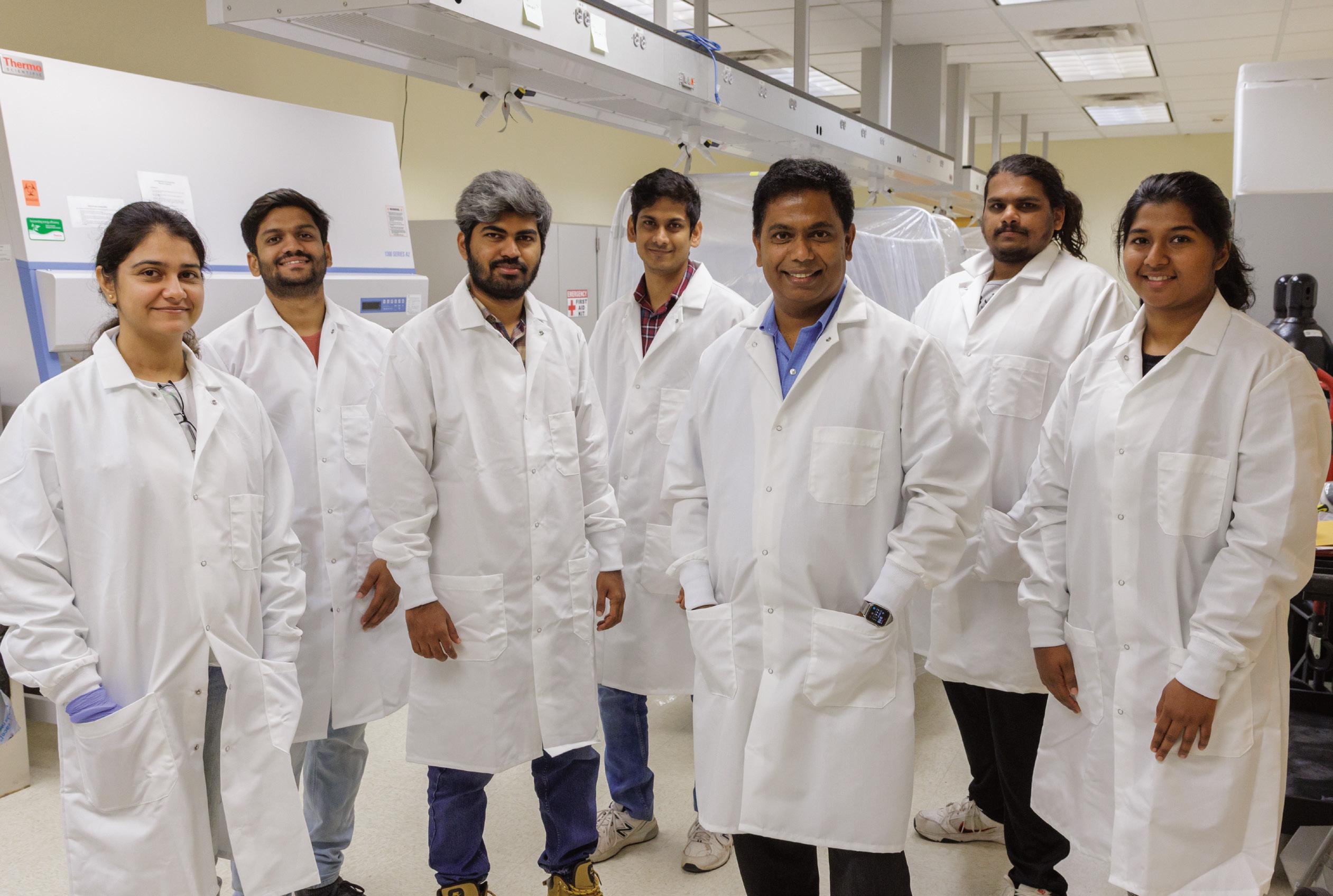
32 OSU RESEARCH MATTERS 2023
Dr. Scaria, third from right, and his team of collaborators, from left, Prabhjot Kaur Sekhon, Amal Cheemadan, Vishnu Thayil Valappil, Shalabm Mishra, Dr. Scaria, Phurt Harnvoravongchai and Binta Varghese.
Dr. Janeen L. Salak-Johnson — Temple Grandin Endowed Chair of Animal Behavior & Well-being and associate professor in the animal science department — serves on the universitywide One Health steering committee and was invited by Scaria to collaborate on the research with what she contributes to the team.
“I bring the pig model to the table more than anything,” Salak-Johnson said. “One of the initial things we talked about is that, and I also bring the immunology and the behavior to the whole equation. I’ve been getting into the microbiome stuff, and I developed a prenatal stress model looking at maternal fetal interactions.”
Salak-Johnson developed a porcine maternal prenatal stress model to look at maternal fetal interactions. This model can play a role in Scaria’s research to help understand what good and healthy microbes are.
One of Salak-Johnson’s dreams is to identify what kind of microbes they modulate in a sow that will then impact her progeny from utero and into the real world. Theoretically, the offspring would have a different signature which would hopefully allow them to better adapt and have a more profound immune response.
The 17 goals of One Health are all interconnected to Salak-Johnson. As an animal science professor and an integrative scientist, she understands problems must be approached from various angles in collaboration to be solved.
Germ-free animals do not have the same gut microbiome as normal animals born into an environment that immediately interacts with microbes. One of the questions the team is working to solve is what a normal healthy gut is, but that question becomes more complex when working with a pregnant individual.
Interpersonal microbiome variation happens both in humans and animals and is the reason drugs may work in some cases but not in others. This germ-free mouse facility will help test how the variation impacts health and therapeutic success.
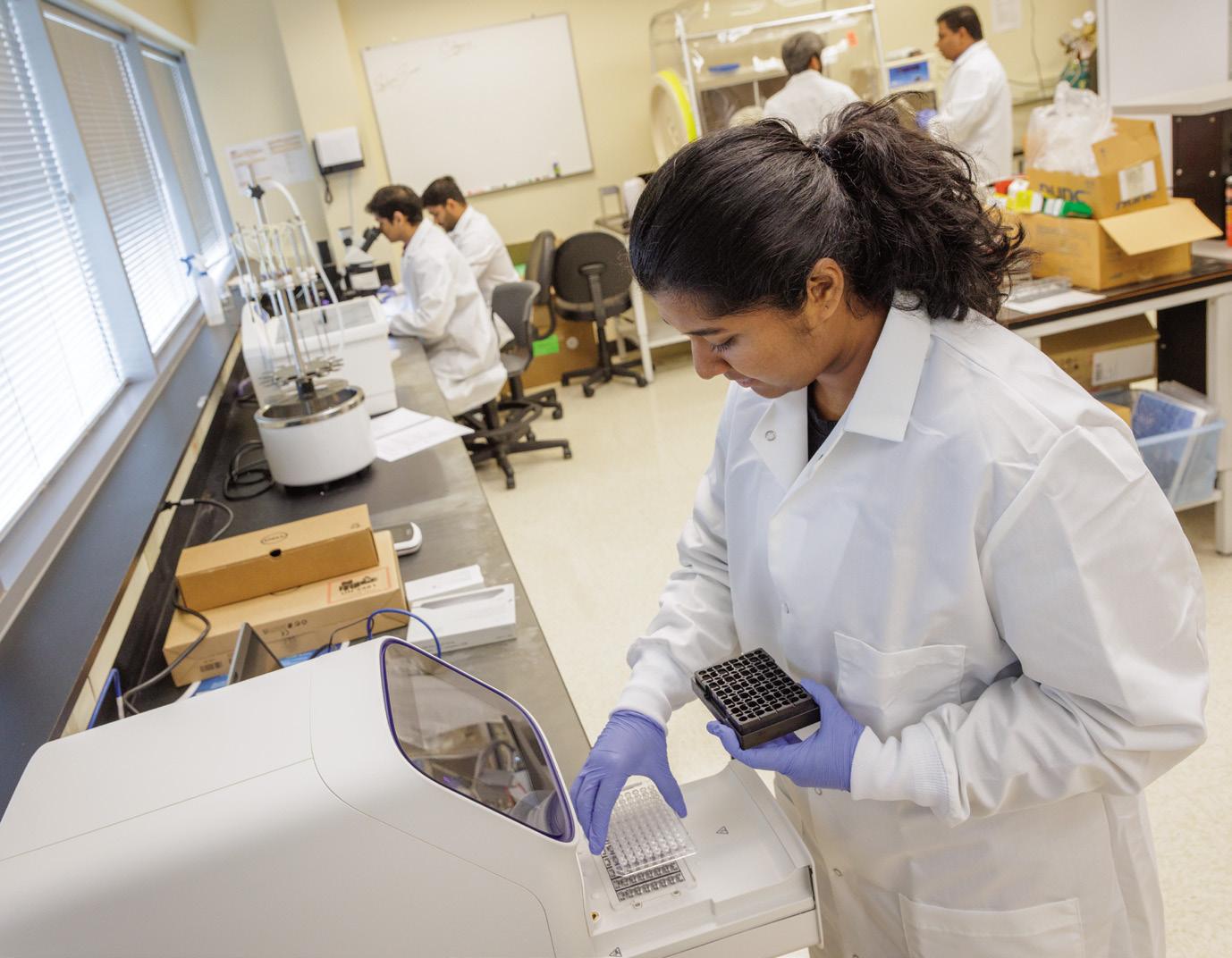
Not only will Salak-Johnson’s model help advance Scaria’s research, but the collaboration between the two benefits her by bringing Scaria’s expertise in statistical and computational information to help her better gather and understand complex data.
Scaria also uses a bioreactors model, a key part of the core facility he is developing to collaborate across the country.
“We have a second model system called bioreactors,” Scaria said. “Bioreactors are reactive systems that mimic the gut-like condition without the host factors. So, it’s a simplified model to understand what microbes and how microbes behave among each other.”
Traditional reactors are hard to manage and expensive, but this bioreactor path eliminates that problem. In a year, up to 1,000 combinations can be tested faster.
So far, Scaria’s team has developed a library of microbes from humans, pigs, chickens and cows. There are close to 10,000 isolates across the spectrum that they systematically sequence in the lab. Their culture collections library will be available to other researchers to study how healthy microbiomes interact with other pathogens.
OSU has a total capacity of 74 reactors that allows for high-throughput screening capacity. Once set up, that bioreactor system will also be a core facility open to others.
“Our studies will help in identifying the impact of microbiomes on health and how we can utilize that knowledge to improve,” Ramachandran said. “Our focus is on animal health, but I think ultimately, we will get bigger solutions that can apply to humans also. We know it’s easier to do studies on animals, than humans.”
The core facility is supposed to be an outreach and a collaborative effort and to provide opportunities for others, Salak-Johnson said.
The germfree chicken and mouse models, along with the culture library, are useful resources that Scaria makes available to every researcher in the state through the new core facility, Ramachandran said.
“Overall, it is going to add to the glory of OSU,” Ramachandran said. “It’s the next generation scientists that are being trained, and the number of students he’s training. It’s going to be really amazing.”
Binta Varghese, right, works in the lab at Venture One.
RESEARCH.OKSTATE.EDU 33
ALL IN THIS TOGETHER
OSU VETERINARY RESEARCHERS
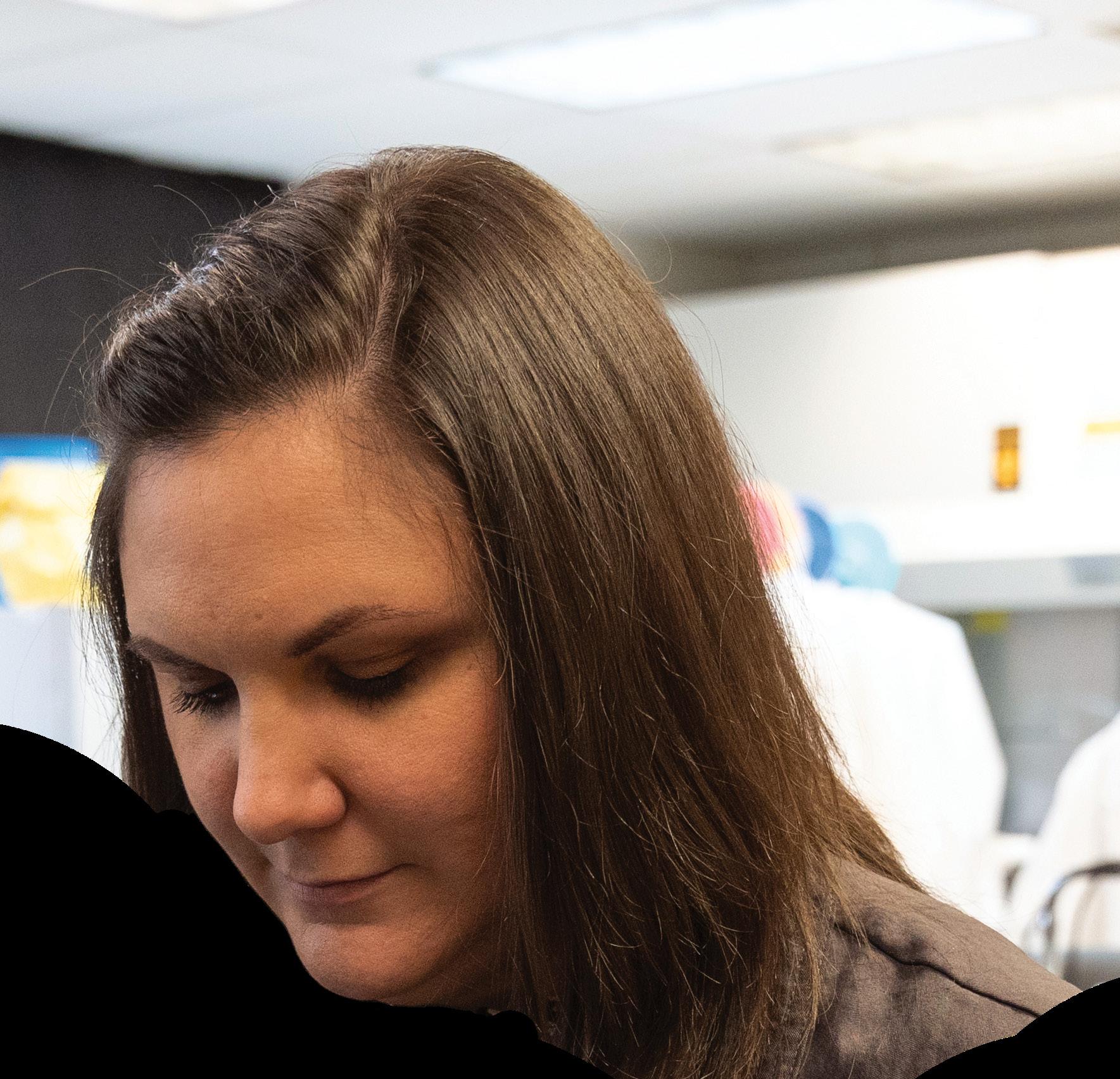
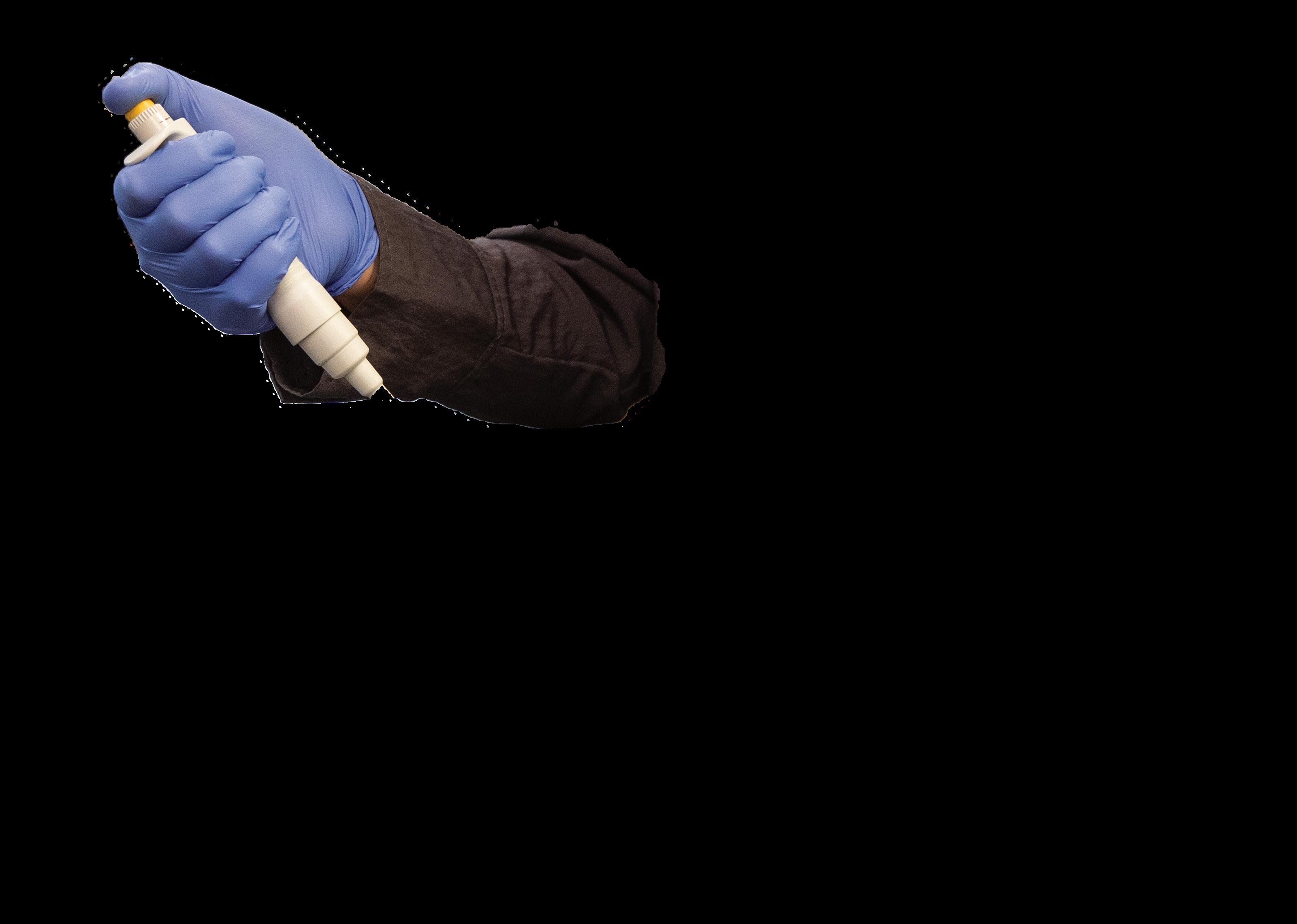
STUDY ANIMAL HEALTH TO AID IN HUMAN MEDICAL ADVANCES

ONE HEALTH 34 OSU RESEARCH MATTERS 2023
Being a veterinary microbiologist doesn’t mean exclusively working with animals.
At least that’s what Dr. Jennifer Rudd, an assistant professor of veterinary pathobiology at Oklahoma State University, has discovered.
Rudd’s research began with studying influenza, which led her to work with a combination of humans and animals. She was already in the depths of researching influenza as a potential pandemic situation when COVID-19 spread worldwide in 2020, giving her a perfect opportunity to shift her focus.

“There was a subset of us who had this unique background, this expertise that was already sort of ready to go to work in pandemic viral respiratory disease,” Rudd said. “I was one of the pieces that fell into that right away.”
When Dr. Craig Miller, a former assistant professor at OSU, received a grant for his lab to work on researching the pandemic, Rudd was brought in. She helped with the clinical aspects of the research and developing the models.
Rudd’s background as a veterinarian gave her an extra boost after learning that COVID-19 affects cats as well as humans. The disease naturally infects cats, so using them as a model better helped her understand how COVID-19 works in people. Miller said preliminary findings show there is potential for
evolution of the disease, and that they are hoping it becomes more like the common cold over time as people gain access to vaccines and build natural immunity. Whether that would make it more or less transmissible, they aren’t sure, but they say they are sure people will adapt.
In the initial findings, Rudd said one of the most interesting things they found was how similar COVID-19 is between SARS-CoV-2 infected humans and cats. Although the disease typically isn’t severe in most cats, there is a range of outcomes, including several documented deaths in large cats in zoos. So, after this discovery, Rudd said the researchers were excited to know how many questions they could answer by being able to mimic the disease.
Research starts at the laboratory bench with basic research and development of ideas before studying these in animals. From animals, these findings can be translated into preclinical studies and then clinical trials, where they can help humans in real world settings.
Miller said they are trying to bridge the gap between the research discovery phase and the clinical phase. In that preclinical space is where their models come into play. There, they can adapt the model to a translational aspect that allows them to use cats to
better understand what’s happening in humans.
“There’s that interplay between animals and humans that we can really explore to extrapolate new findings and new methods to try to help humans while also helping animals at the same time,” Miller said. “That’s how I envision One Health. We’re all in this together and we can use these different aspects to try to help different factors or different sectors of the health spectrum.”
Through this study, Rudd and Miller have emphasized the idea of One Health. The idea that the health of humans, animals and the environment are all interconnected drives much of the research in the veterinary world.
“If any one of those three pieces is struggling, there are direct and indirect implications on the other two,” Rudd said. “Instead of trying to do our research with blinders on and only look at veterinary medicine, or human medicine, or environmental medicine, there’s a push to take a more holistic approach, which is more applicable, more practical and has more ability to change. We can understand how this expertise and these different areas can work together to make each other better.”
For example, Rudd said there are cancers in dogs that veterinarians can use to create therapies that translate over to people. The Institute for Translational and Emerging Research in Advanced Comparative Therapy, a group in the OSU College of Veterinary Medicine, has projects of One Health through cancer research such as this.
Rudd, however, works in coronaviruses and said animals have been getting coronaviruses much longer than the ones people have been studying in human medicine.
“There’s always a question of what if. What if we had a better One Health approach or what if we’d have more veterinarians involved in early 2020?” Rudd said. “Would it have been slightly different? And I think we all need to learn from that and remind ourselves that we all have our areas of expertise. But we’re all better when we’re unified and working together as opposed to staying in our silos.”
STATEMAGAZINE.OKSTATE.EDU 35
Dr. Jennifer Rudd, an assistant professor of veterinary pathobiology, studies how animal health connects to human health, otherwise known as One Health.
RESEARCH.OKSTATE.EDU
Driven by science and powered by humans, the new Human Performance and Nutrition Research Institute is transforming the health outcomes of Oklahomans through the scientific study of human performance.

Under Lance Walker, Rick and Gail Muncrief executive director, HPNRI and Oklahoma State University are harnessing the university’s cutting-edge research expertise in human performance and nutrition science, coupling it with advanced knowledge from our elite strength and conditioning staff and leveraging it with leading industry partner relationships to create a first-of-its-kind research institute.
This institute will utilize scientific discoveries gained through student-athlete experiences and transdisciplinary research to produce and translate new knowledge that empowers optimum performance and health for all Oklahomans.
Through immersive learning and mentorships, HPNRI will provide students with the resources needed to develop their skills as the next generation of human performance, nutrition and health care leaders. Guided by the land-grant mission, HPNRI and OSU are enhancing the health of Oklahomans.
36 OSU RESEARCH MATTERS 2023
HPNRI.OKSTATE.EDU
The Hamm Institute for American Energy at Oklahoma State University is finding innovative solutions to forge new paths for energy in America and around the world. By establishing this modern facility, OSU is forecasting the future through security, innovation and growth for all forms of energy.

Our researchers are addressing energy security and finding ways to develop sciencebased solutions through collaboration and exploration. From events like the American Energy Security Summit to more than $80 million in energy cost savings through our energy management program, we are connecting experts and industry leaders for the workforce of tomorrow.
With the Hamm Institute serving as the center for all things American energy, OSU will educate and prepare the next generation of energy leaders. HAMMINSTITUTE.ORG
FUELING THE FUTURE
Standing in a flower bed outside the Oklahoma State Capitol building is an oil well. An iconic sight for Oklahomans, the well was placed on Nov. 10, 1941, and now serves as a reminder of the importance the energy sector has had on the growth of the state.
Although it was plugged more than 40 years later, the well is now considered a historic piece and is preserved as part of Oklahoma’s long history with oil and gas.

For Oklahoma State University, a modern-land grant institution deeply connected to the state and people of Oklahoma, this importance is not taken lightly. Energy research continues to be a focus area across campus, from the Boone Pickens School of Geology (BPSoG) to the College of Engineering,

STORY HARRISON HILL | PHOTOS GARY LAWSON AND BENJAMIN SUTER ON UNSPLASH
38 OSU RESEARCH MATTERS 2023
POWERING THE FUTURE
Architecture and Technology, and the Ferguson College of Agriculture.
“As a land-grant institution in an energy state, our school has traditionally been focused on oil and gas resources,” said Dr. Camelia Knapp, head of the BPSoG, professor of geophysics and V. Brown Monnett Chair of Petroleum Geology. “We are lucky that Oklahoma has such resources and a lot of our training here in the school traditionally was based around research for oil and gas. We have many dedicated alumni who are working in this area and now they are giving back to the school.”
Although geology is often thought of as studying rocks, it encompasses much more than that, and Knapp feels geologist is an old term not fully encompassing the modern role.
“It is from 300 years ago when geology started as a science, and that’s when geologists were going out and collecting rocks and analyzing them, but the field has expanded so much more,” Knapp said. “Really, we call ourselves geoscientists.”
Geoscience is not just rocks, it is all about solving physics of the earth, she said.
And that is exactly what they are doing.
“If you look at the history of Oklahoma, one might argue it has first and foremost been built around energy,” said Dr. James Knapp, professor in the BPSoG and Boone Pickens Distinguished Chair
of Geoscience. “The legacy of energy in what is now the state of Oklahoma can’t be underestimated. That fits in naturally into what we can do as a land-grant university for Oklahoma — build on the long traditions that made the state what it is and are clearly a cornerstone for the state.”

STUDYING SUSTAINABILITY
Issues with energy sustainability have been a topic of conversation for decades as it affects a lot of crucial areas.
“It ties into issues about mitigating climate change, it’s about providing affordable resources, especially in the developing world to advance their capabilities and quality of life and it also ties into how you most economically use those energy resources, along with water resources, for that matter, in all processes of producing food to feed the world,” James Knapp said.
A lot of that discussion is focused on how to transition to cleaner energy.
“Oklahoma is going through the same energy transition that is underway globally,” said Dr. Mileva Radonjic, associate professor of chemical engineering and the Samson Investment Chair in Petroleum Engineering. “However, due to large oil and gas infrastructure and vast amount of data and knowledge of subsurface, as
RESEARCH.OKSTATE.EDU 39
well as technically capable workforce, energy transition that will require carbon storage, hydrogen production and storage and geothermal energy usage, can have successful implementation in Oklahoma.”
Solving this problem is not just for oil and gas wells, said Radonjic, who is also an adjunct faculty member in the school of geology, but for CO2 injection/storage and for geothermal and hydrogen energy as well.
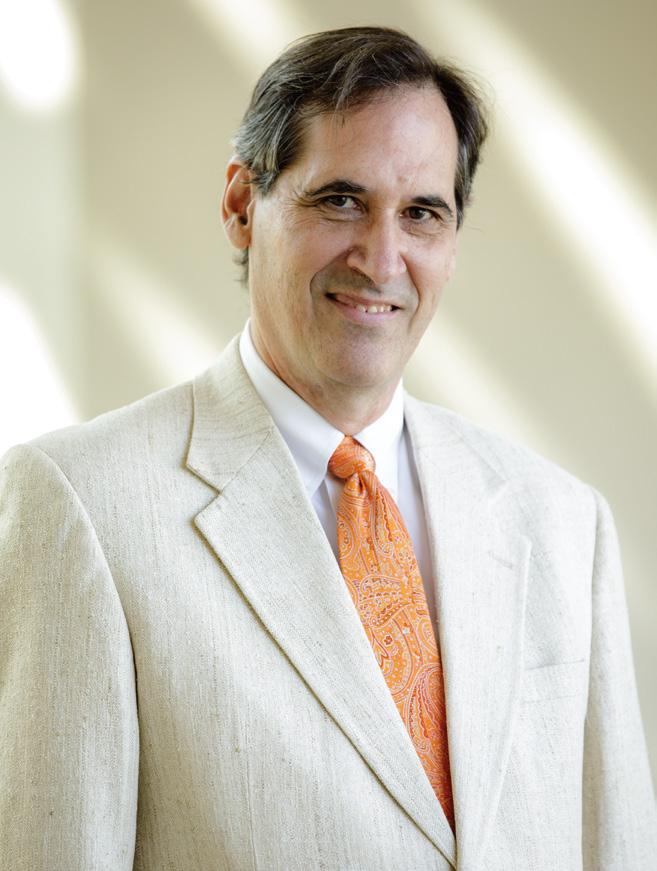
“What makes this topic cool and exciting is that it requires a multifaceted approach, which brings together geology, materials science, petroleum and civil engineering, and flow through porous media, with geochemistry, materials chemistry and geomechanics too,” Radonjic said.
ROOM TO GROW
The field of energy technology has grown rapidly over the years and so has research around it.
“We are trying to align our curriculum with our research interests. They are all connected. When we talk about energy primarily, we talk about subsurface energy, so natural resources, like oil, gas, coal and minerals.”
“Everyone is hearing more and more about energy transition. And our school has been really expanding,” Camelia Knapp said. “We like to call it energy integration.”
For the BPSoG, that growth looks like new concentrations added to the geology major including petroleum geology, environmental geology, pre-law and a secondary teacher’s certification as well as two new majors in environmental geosciences and geophysics and an accelerated master’s program. The school also added a professional science master’s in geosciences with concentrations in petroleum geosciences, hydrogeology and geophysics.
“We are trying to align our curriculum with our research interests,” Camelia Knapp said.
Every faculty member in the school is working on research relevant for the energy, water and climate nexus, Camelia Knapp said.
“Collaboration
solving
societal issues such as development of clean renewable energy resources. This was only possible when CEAT and the College of Arts and Sciences combined efforts...”
“They are all connected,” she said. “When we talk about energy primarily, we talk about subsurface energy, so natural resources, like oil, gas, coal and minerals. But our faculty do very comprehensive research.”
That research covers everything from traditional energy focuses to newer ideas like carbon capture and storage — looking at permeability and porosity of rocks that allow not only oil and gas but other fluids like CO2 to flow through, Camelia Knapp said.


“It is not only oil and gas right now,” she said. “CO2 capture and storage has become more widely available and basically the same types of geologic reservoirs that accommodate oil and gas are suitable for carbon dioxide injection and storage.”
Technology like carbon capture and storage are vital to developing a more sustainable energy system.
“Not many people know that more than 83% of the world’s energy
DR. CAMELIA KNAPP
“If you look at the history of Oklahoma, one might argue it has first and foremost been built around energy. The legacy of energy in what is now the state of Oklahoma can’t be underestimated. it energy integration.”
DR. JAMES KNAPP
is essential in
major
40 OSU RESEARCH MATTERS 2023
DR. MILEVA RADONJIC
consumption comes from oil, gas and coal,” Camelia Knapp said. “When you look at this global energy consumption, you really can’t turn a switch and say, ‘Oh, now we’re going to only start using wind and solar, and maybe geothermal.’ We need to find solutions for transitioning into a more renewable energy environment, but it’s not going to be overnight.”
That transition will take time of course, as energy is so vital to our world.
“I think there is probably very little that isn’t touched somehow by the energy piece,” James Knapp said. “On top of that, especially in the last few decades, we’ve seen the emergence of a lot of these green technologies that provide at least the prospect of diversifying how we produce energy and how we are responsive to issues.”
CREATING COLLABORATION
For research across OSU’s campuses, collaboration continues to be a growing focus. In the energy sector, this is especially clear.
“A year and a half ago, OSU established the Hamm Institute for American Energy,” James Knapp said. “That’s sort of the centerpiece for OSU for the whole energy sphere. The way forward is going to be in supporting and collaborating with the Hamm Institute.”
That means his position as a faculty fellow for strategic initiatives is to get people together with different backgrounds and perspectives to have conversations bridge different theories.
“Collaboration is essential in solving major societal issues such as development of clean renewable energy resources,” Radonjic said.
Radonjic is currently leading a DOE funded project — Caney Shale Field Lab — which is one of the major funding grants in CEAT and the BPSoG, with combined value approaching $20 million.
“This was only possible when CEAT and the College of Arts and Sciences combined efforts and included several faculty members, postdocs and graduate students, in collaboration with Lawrence Berkeley National Lab,” Radonjic said. “We have a project that is as productive and competitive as any other university in the DOE NETL portfolio of shale projects.”
Radonjic and her collaborators also contributed to energy research by graduating students ready to join industry, academia and/or national labs, as well as supporting postdocs towards faculty positions, she said.
“I would say, this multilayered interdisciplinary effort is only possible in large collaborative projects,” Radonjic said. “Encouraging a culture of collaboration, exchange and ideation is critical and not always easy in academia, where we do have some silolike behaviors.”
While those silos can be detrimental to progress, OSU researchers are focused on avoiding them and instead are connecting across fields of research and focus areas.
“You can’t do comprehensive energy research in silos,” Camelia Knapp said. “You really have to work together. Because you need a geoscientist and you need an engineering unit, you need to incorporate environmental justice, so, you need to talk to sociologists. You have to get outside of your comfort zone and work with a larger team.”
Energy is one of the biggest issues worldwide, but it is more than just a problem.
“It’s not only a problem, it’s a global opportunity,” Camelia Knapp said. “I would say that with what is going on with energy transition and energy integration nowadays it really is a global opportunity.
“I just wish we could have a bigger voice as geoscientists to tell the new generations that this is an area where they have a future.”
FOR MORE INFORMATION


Interested
Check
in learning about carbon capture and storage?
okla.st/rmcarbon
out KOSU’s Research Matters podcast to learn more about how geoscientists help us understand the earth.
READ
okla.st/kosugeoscience LISTEN UP:
ON:
RESEARCH.OKSTATE.EDU 41
EMPOWERING INDUSTRY ACROSS THE REGION
U.S. SECRETARY OF ENERGY ANNOUNCES CREATION OF GREAT PLAINS CENTER OF EXCELLENCE AT OSU
Oklahoma State University’s Industrial Assessment Center has helped manufacturers reimagine their operations for more than four decades, identifying a combined $132 million in potential cost savings and educating hundreds of renowned energy engineers.
This spring, an OSU campus visit from U.S. Secretary of Energy Jennifer M. Granholm and Second Gentleman Douglas Emhoff trumpeted the creation of a new entity that will expand OSU’s footprint across the region, amplifying its land-grant impact — The Great Plains Center of Excellence at OSU.
The new center — which will be housed within OSU’s IAC in the College of Engineering, Architecture and Technology — is one of five competitively selected higher education institutions to serve as centers of excellence for
the Department of Energy’s Industrial Assessment Centers Program.
“[OSU’s IAC] is one of 37 Industrial Assessment Centers that we have through funding with the Department of Energy,” Granholm said as she addressed a crowd during an April 7 news conference at OSU’s ENDEAVOR lab. “And the thing that is so important is that it does give students this hands-on ability to see technology in action to see how to reduce the carbon emissions price of energy, reduce energy use on-site, and that is so critical for what we want to do in both attracting and retaining engineering students, making sure that those students see in themselves a future in reducing Co2 emissions and in reducing energy use and in generating clean energy into the future. And it’s those innovative technologies that are being used right here that caught our eye.
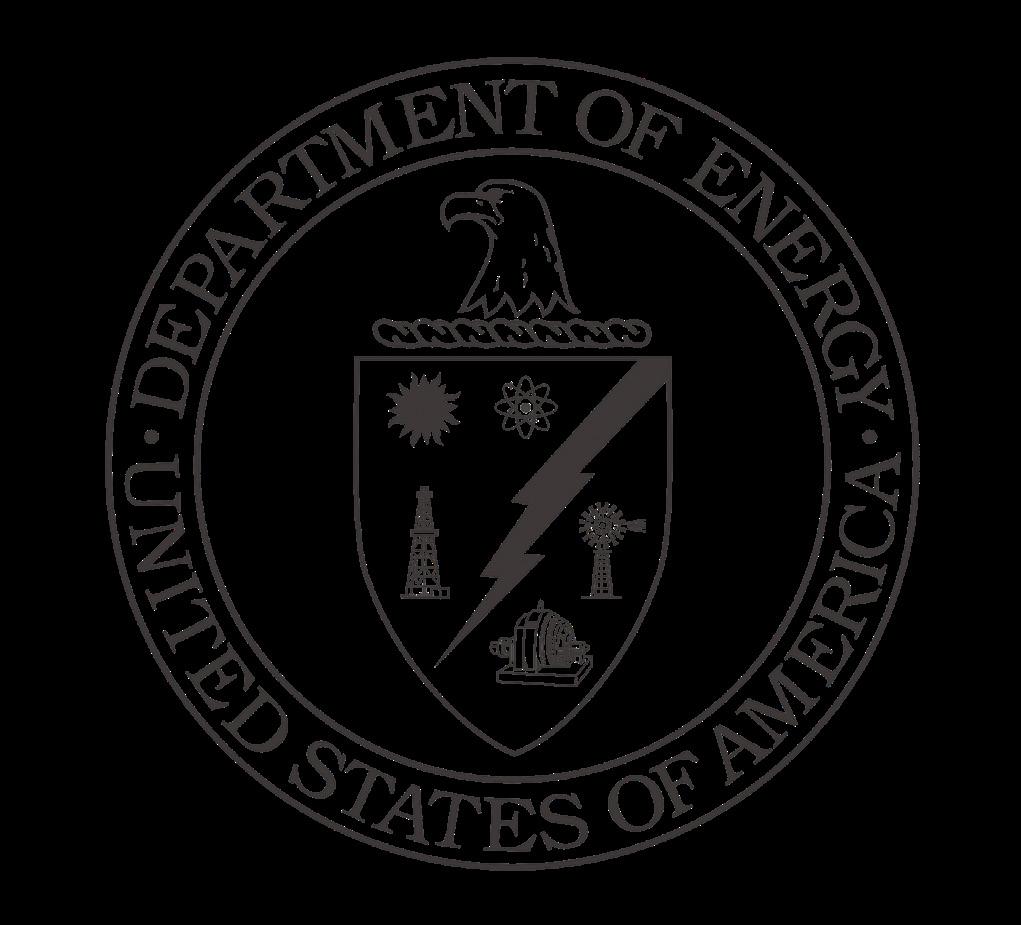
STORY JEFF HOPPER AND MACK BURKE | PHOTOS PHIL SHOCKLEY POWERING THE FUTURE 42 OSU RESEARCH MATTERS 2023
“And so today, I am proud to announce that we are awarding nearly $19 million to five universities who will host new IAC Centers of Excellence, including the Great Plains Center of Excellence right here at OSU.”
Of the combined $18.7 million in funding slated for the five new centers, the GPCoE has received a nearly $7 million funding award. That funding will directly impact the center’s ability to conduct industrial assessments aimed at helping clients reduce energy usage and increase productivity while educating the next generation of energy, waste and productivity professionals using next-generation, integrated tools and technologies, such as smartphone apps, drones and virtual/augmented reality.
The GPCoE also will focus on developing interactive learning environments for teaching, training and workforce development activities
through an interactive virtual curriculum for IAC personnel, manufacturers and employees, and university and community college students.

The creation of the GPCoE will allow OSU to further its land-grant mission to address society’s most pressing challenges through innovative, worldchanging research.
“As the largest university system in the state of Oklahoma, part of our land-grant mission is to be an economic growth engine and to deliver cutting edge research that benefits our state, our region and our nation,” OSU President Kayse Shrum said. “And this award for the Great Plains Center of Excellence certainly supports our land-grant mission and will further propel our efforts to solve society’s most pressing challenges.”
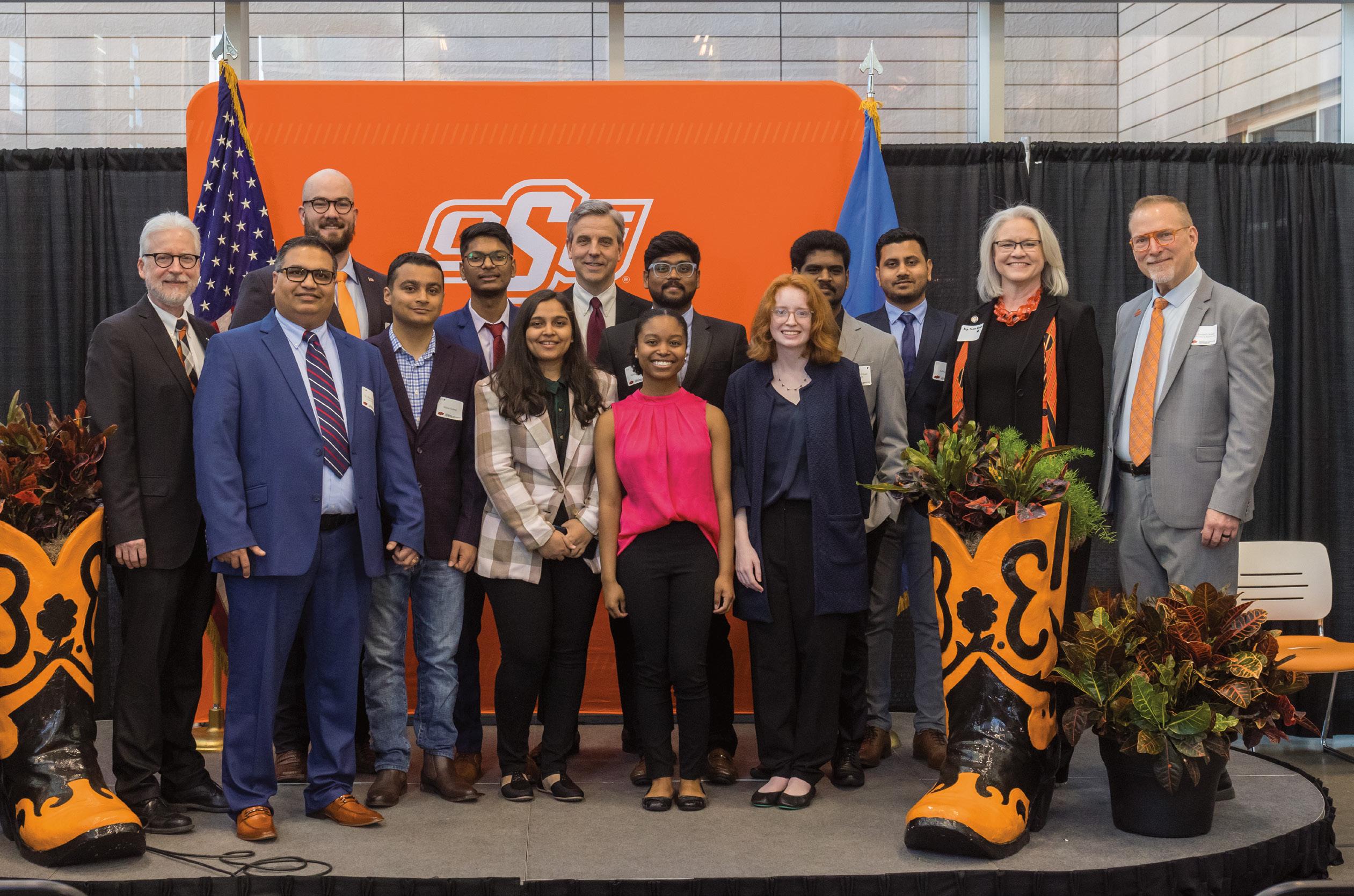
STATEMAGAZINE.OKSTATE.EDU 43
Oklahoma Gov. Kevin Stitt, Sen. Tom Duggar, Rep. Trish Ranson and
“... we are awarding nearly $19 million to five universities who will host new IAC Centers of Excellence, including the Great Plains Center of Excellence right here at OSU.”
JENNIFER M. GRANHOLM, U.S. SECRETARY OF ENERGY
RESEARCH.OKSTATE.EDU
From left: Dr. Chuck Bunting, Dr. Hitesh D. Vora, Will Gibson, Diwas Subedi, Abinash Kumar Gupta, Snehal Durugkar, John Smegal, Tionne Fultz, Rahul Nomula, Emma Cooley, Hemal Keerthipati Sumanth, Aditya Shete, Rep. Trish Ranson and Dr. Kenneth Sewell pose together following the launch announcement for the new Great Plains Center of Excellence at OSU.
FAST FACTS: GREAT PLAINS CENTER OF EXCELLENCE
• The IAC will continue its work while the new regional center of excellence expands OSU’s footprint to bolster other IACs across a 13-state region — Minnesota, North Dakota, South Dakota, Iowa, Missouri, Nebraska, Kansas, Oklahoma, Arkansas, Louisiana and areas within New Mexico, Colorado and Texas.
• Great Plains Center of Excellence (GPCoE) will serve as a regional hub for the Department of Energy and 12 Great Plains states, with seven states home to partnering IACs.
• Its main objective is to develop, deploy and test the next generation of integrated tools and technologies in the form of Smartphone apps, drones and virtual/augmented reality to allow virtual/remote data collection. It also aims to produce competent, motivated energy engineers, provide resources and expertise to complement energy conservation technologies, equitably develop the clean energy workforce and form significant collaboration focused on improving our region’s industrial competitiveness.
• The new center — which will be housed within OSU’s Industrial Assessment Center in the College of Engineering, Architecture and Technology — is one of five competitively selected higher education institutions to serve as Centers of Excellence for DOE’s Industrial Assessment Centers Program.
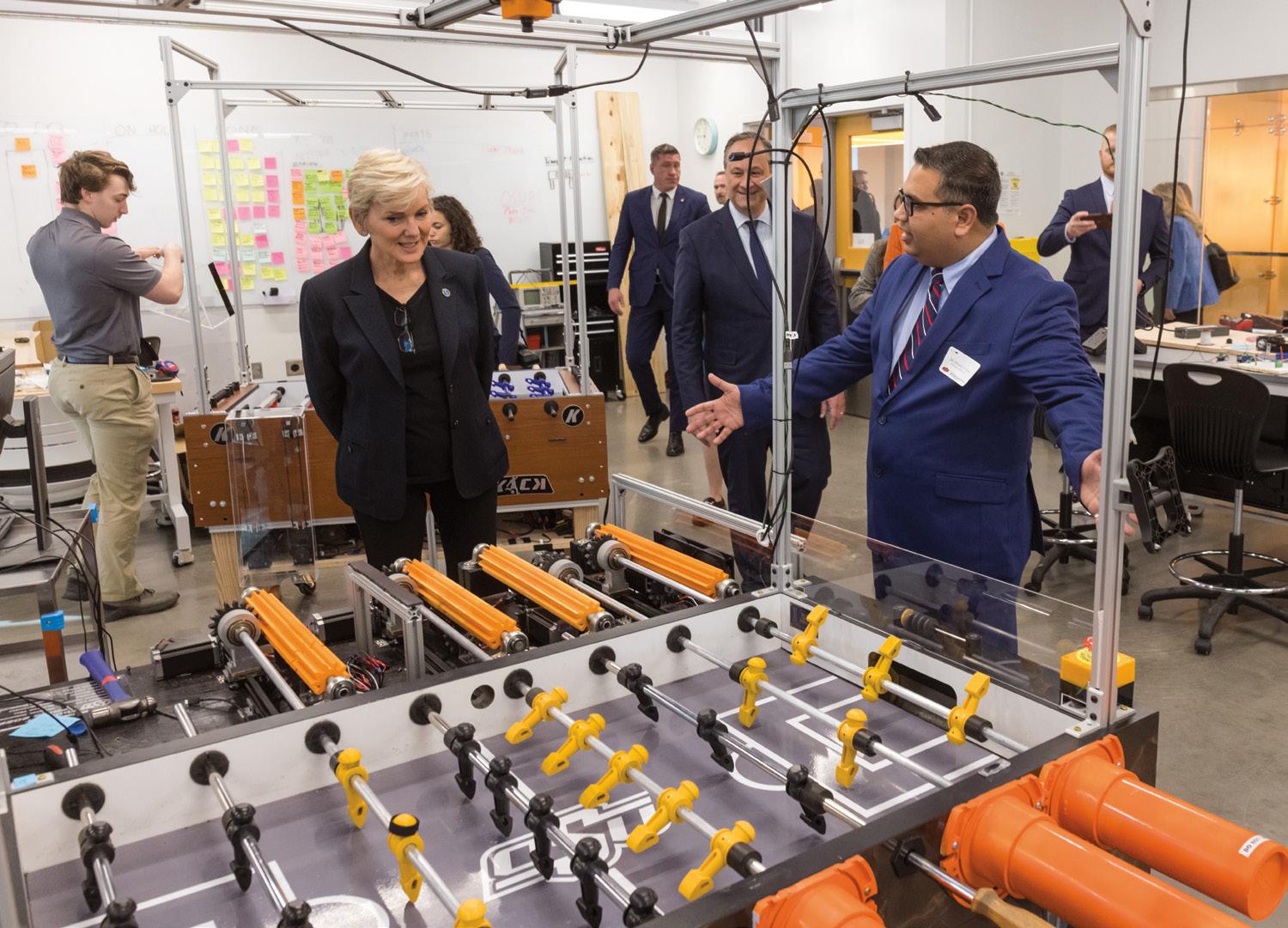
• The new regional ‘Centers of Excellence’ will expand a Department of Energy program that works with employers to train clean energy workers and identify ways to reduce energy and save money.
Dr. Hitesh Vora — OSU IAC director and principal investigator for the new center of excellence grant — were also on hand to celebrate the momentous announcement, which Stitt praised as another positive milestone for OSU and the state.
“Secretary, we’re so excited that you’re in Oklahoma and you’re investing in the state of Oklahoma,” he said. “We really appreciate your leadership on everything energy, and especially renewables and hydrogen. And congratulations to Oklahoma State University for this award.
“You know, Oklahoma has an allof-the-above energy approach. We’re so proud of our oil and gas industry. And what most people don’t realize is we’re also No. 2 in the country in wind energy, and we produce about 65% more energy than we consume. We’re a net exporter of that energy. And we’re one of only four states that over 40% of our energy comes from renewables. And that’s why Google’s largest data center is located in the state of Oklahoma and a lot of companies are looking to Oklahoma because of our affordable, reliable energy grid.”
Granholm followed Stitt’s remarks by highlighting the cooperative push behind the Bipartisan Infrastructure Law, which was enacted in 2021.
“This initiative, which is all about investing in America, is one piece of a grand strategy for us as a country to be able to get back the manufacturing jobs that we have lost over the past couple of decades,” she said. “And this is something that I know Democrats and Republicans can agree on — the importance of bringing back manufacturing in this country.”
The news conference followed a tour of OSU’s state-of-the-art ENDEAVOR lab, where Granholm and Emhoff got a firsthand look at the unique hands-on learning and research opportunities available to OSU students, even as undergraduates. The second gentleman — a noted college football fan — also enjoyed a brief meeting with OSU football coach Mike Gundy.
“Yes, I got the football from Coach Gundy, but that was a surprise,” Emhoff said. “What was really not a surprise was to see the excellence here at Oklahoma State University; to
44 OSU RESEARCH MATTERS 2023
U.S. Secretary of Energy Jennifer M. Granholm visits the ENDEAVOR Lab and speaks to Dr. Hitesh Vora at the launch of the Great Plains Center of Excellence at OSU.
see the passionate colleagues that you have, the students, the grad students, just to see the work that’s being done. You can see it. That’s what I love so much about this tour. … You can literally see the future in front of your eyes.”
One of the students impacted is chemical engineering senior Tionne Fultz. She has worked in OSU’s IAC for the past two years, and the impact the center has had on her personal and professional growth has been immeasurable.
“Since the very first day I started at the IAC, Dr. Vora has always encouraged me to speak up in meetings with clients and has consistently asked for my unique opinion on how the program is run,” she said. “All the experience I’ve gained has helped me get internships and even a full-time position as an environmental engineer after I graduate. I can’t even begin to imagine where I would be had I not joined the IAC.”
For his part, Vora couldn’t be more excited about the future. He said the GPCoE will expand OSU’s footprint and allow for rapid advancement of new technologies to be shared across the region in a way that meets the region’s specific needs. The region is predominantly rural in nature and encompasses vast numbers of census tracts designated as “disadvantaged communities.” The project design
FAST FACTS: INDUSTRIAL ASSESSMENT CENTER
• Since its official founding in 1979, the IAC has been responsible for nearly 1,100 assessments, accounting for $132 million in savings for its clients.
• The IAC’s clients are manufacturing companies, water and wastewater treatment plants, and, as of recently, commercial buildings.
includes strategies for reaching manufacturers in those communities. Because of its central location in Oklahoma and its reach into northern Great Plains states, this project will have a substantial positive impact on Native American interests in the region.
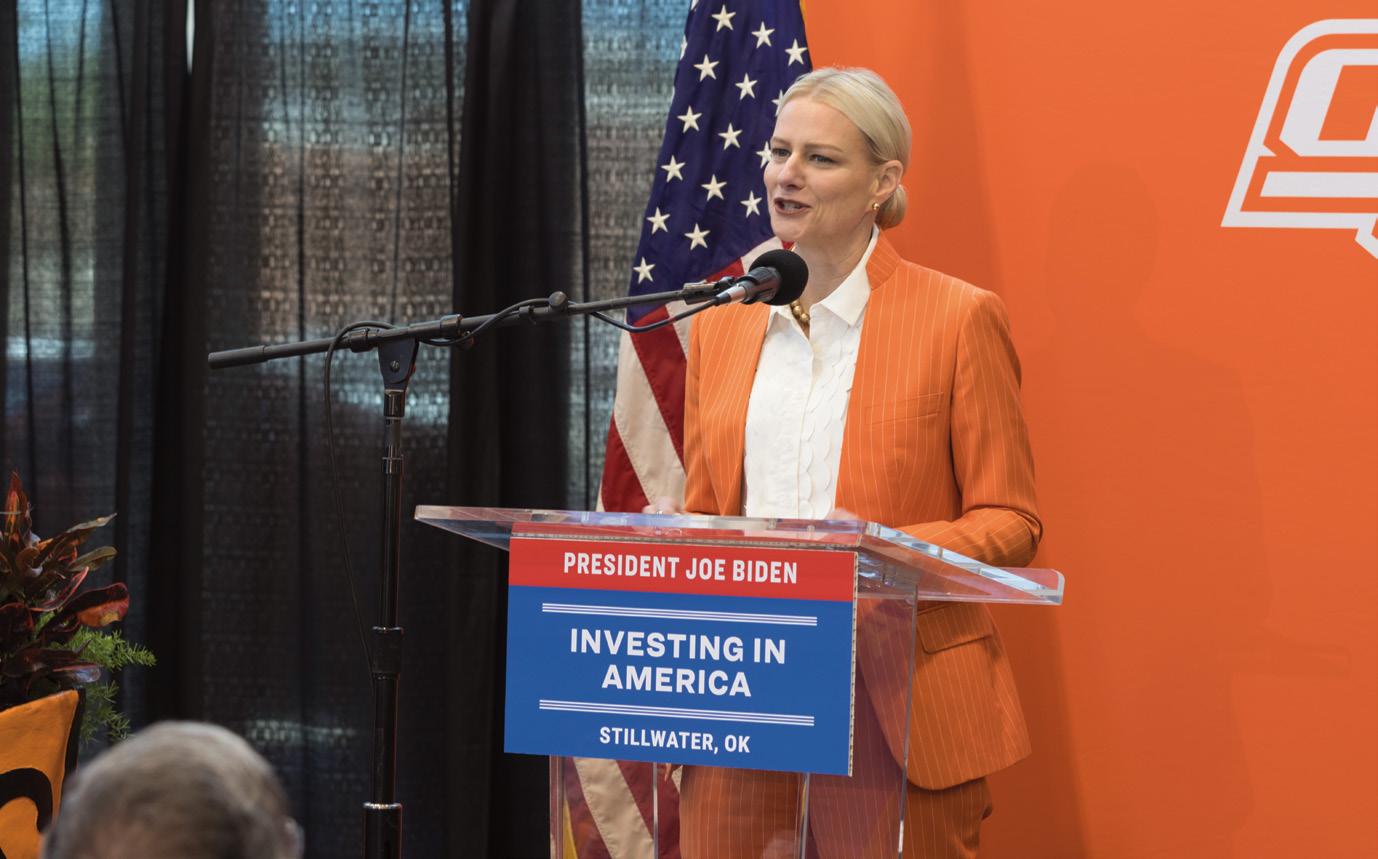
“The needs on the East Coast and in the West are so much different than we have here in the middle of the country,” Vora said. “The Great Plains Center of Excellence will allow us to provide a customized solution to IACs all over the region, providing new technology development and training so that they can work properly.”
The benefit for these centers and the industries the new GPCoE will serve is immense. But Vora said the benefit to students is life-changing.
“The student is the ultimate winner of this,” he said. “At OSU, we teach them theory in class, but any manufacturing plant can serve as a lab. These students get hands-on experience working with real data, analyzing that data and communicating it to clients.”
Vora said the opportunity to “turn stone into gold” is what drives him.
“That’s why I’m here,” he said. “These students come here without any experience, and they leave with extremely valuable experience. It’s real life experience, and they’re making a real impact on the world, even as students.”
• OSU’s Industrial Assessment Center’s current region of impact: Oklahoma, Kansas, Arkansas and part of North Texas.
• Through energy savings, the IAC program at OSU has helped to displace 1.91 million metric tons of carbon dioxide emissions from industrial sources in its four decades of service.
• IAC alumni graduate with an average of 8.9 specific skills applicable in the energy efficiency field. Alumni are hired almost twice as fast as their peers into an energy efficiency position.
• Many of IAC OSU alumni have been hired in companies such as Pepco Energy Services, EMCOR Group, Siemens, GE and more. Others have gone on to work overseas in countries including Russia, China and India. Some of our alumni have chosen to become educators at schools, such as OSU and University of Illinois Urbana-Champaign to pass on their knowledge.
RESEARCH.OKSTATE.EDU 45
Oklahoma State University President Kayse Shrum speaks at the opening of the Great Plains Center of Excellence at OSU.
Why do couples use baby talk with one another?
Imagine you’re strolling through a park and you overhear a middleaged couple cooing over each other, doting over their “wittle sugar pwum” and “baby doll.”
“Ewwww,” you might reflexively think.
Baby talk is cute when grownups dote on babies. But when adults converse with each other? Not so much.
Yet in my work as a communication sciences and disorders researcher, I’ve come across studies showing that as many as two-thirds of couples use romantic baby talk.
It may sound strange and elicit cringes, but it’s no disorder.
So why do couples do it?
First, it’s important to understand what, exactly, I mean by “baby talk.” It’s not how babies talk to one another. It’s the exaggerated pitch, tempo and intonation that parents use when talking to their little ones — what linguists call “motherese” or “parentese.”
According to speech and hearing expert Patricia Kuhl, this special
style of speaking facilitates social interactions with babies, helping them learn how to communicate. And it isn’t a phenomenon just in English. Speakers in every culture and every language will change their pitch and exaggerate their intonation when communicating with babies.
Research has shown that this style of speaking actually triggers the release of neurotransmitters that motivate infants to learn.
However, in the case of romance, this style of speech is less about learning and more about affection.
According to the affection exchange theory, which was proposed by the communication researcher Kory Floyd, specific vocal behaviors signal affection. These include the use of a high pitch, exaggerated intonation and a soft voice –traits that just so happen to overlap with the way most people talk to babies.
But there’s another side to the phenomenon: the formation of a special linguistic landscape that’s walled off from the rest of the world, a space for couples to express themselves that’s
free from the complexities and customs of routine adult conversations.
The use of “idiosyncratic,” or personalized, communication is an important aspect of close friendships and romantic relationships. A bystander listening in might be flummoxed. But to the couple, it’s a sign of their bond — a boundary that sets them apart from everyone else. Pet names like “sweet pie” and “nugget” are a part of this, and they’ve been shown to signal greater relationship satisfaction among couples.
So while adults literally going gaga for each other might sound peculiar, it’s a hallmark of humanity.
Ramesh Kaipa, associate professor of communication sciences and disorders at Oklahoma State University wrote this story in partnership with The Conversation. The Conversation is a nonprofit news outlet dedicated to sharing research from experts like those on our faculty. Read more from OSU faculty by going to okla.st/ theconversation.
STORY RAMESH KAIPA
FACULTY AUTHORED STORY FROM THE CONVERSATION
46 OSU RESEARCH MATTERS 2023

Focused on improving lives, strengthening communities and answering life’s biggest questions, OSU experts are there when you need them. FIND AN EXPERT AT Discover Oklahoma State University research at experts.okstate.edu
Link to the Past
Medieval manuscripts exhibit teaches OSU students, faculty evolution of publishing
Eight hundred years ago, in a country that most likely has a different name now, a goat was killed.
Everything from the goat was used for all manner of things in the Middle Ages, but everything eventually disappeared through time, except for one thing: its hide.
The hides of many animals were used to create parchment, which then went through a variety of different people who wrote, illustrated, bound and distributed the final product as a book.
Some of those books showed up this spring at Oklahoma State University as part of an exhibit of medieval manuscripts, still intact.
The exhibit, on loan from gallery Les Enluminures, captivated the minds of OSU
students, faculty and the public with the craftsmanship of the manuscripts and the writings in them that have stood the test of time.
Dr. Jennifer Borland, an art history professor and director of the OSU Center for the Humanities, said the talks with the gallery to receive the books as part of the Manuscripts in the Curriculum program started in 2018. However, because of COVID-19, the exhibit didn’t come to fruition until 2023.

Borland, Dr. Emily Graham in the Department of History and Dr. Mary Larson in the Library were instrumental in the exhibit coming to OSU.
“If you look at the cost of the materials that we had here, I think it was close to half a million dollars worth of manuscript material,” said
STORY JORDAN BISHOP | PHOTOS JASON WALLACE AND NINA THORNTON
48 OSU RESEARCH MATTERS 2023
Art history master’s student Molly Murphy Adams presents on the portable breviary at a campus event featuring student research held at the OSU Library in April.
BEN
DEPARTMENT OF SPECIAL COLLECTIONS AND UNIVERSITY ARCHIVES
Larson, the Puterbaugh Professor of Library Service and associate dean for distinctive collections.
Before anyone could view the materials, the Library had to ensure all the conditions were right for viewing. The manuscripts were mailed through FedEx, Larson said, and the utmost security and care was taken for them upon their arrival.
“Before we could even get the exhibit, we had to track environmental conditions like temperature, humidity, changes within a 24-hour period, all of that in the areas where the manuscripts would be held. We had to do all of that for a number of weeks,” Larson said. “… We had to put UV filters on all of our lighting to make sure that the manuscripts aren’t getting too much.”
Larson, who has a background in archeology, was tasked with a condition report of the materials when they arrived and writing one when the manuscripts were sent back.
“There was a Vulgate Bible that we had on loan and it was like onion skin,” Larson said. “I have never seen parchment that thin in my life. The size of the calligraphy, the print, the text was just tiny, even with my glasses. I pictured some monks slowly going blind copying this because it was astonishingly small and very fine.”
Larson enlisted the help of Ben Hedges and Sana Masood in the
Department of Special Collections and University Archives to help. For all three, the manuscripts were the oldest written materials they had handled. (The oldest materials in the Edmon Low Library are in the Dr. Bill F. and Jean Kelso Collection of Ancient Coins as some of those date to the fourth century B.C.)
“You find yourself in awe of them at first, just seeing the kind of history that’s sitting in front of you,” Hedges said. “And then your first instincts are also to just treat them as if they’re going to disintegrate if you look at them wrong but, in reality, they’re actually pretty hardy, they’ve survived upwards of 800 years.”
The manuscripts were kept in a safe when not on display, but otherwise, students were briefed on how to handle them when they would come to study. Hedges said one misconception was that gloves needed to be worn to work with the books, but that is not the case since they could tear the parchment more easily.
Most of the books were in Latin, and though the writing was still legible, the text wasn’t as important to many students and faculty as the construction of the manuscripts and the ways in which the texts were written with artistic flourishes and paintings. Borland said not only did the history and art history students glean knowledge
A Vulgate Bible
England, circa 1260-1275
Psalter
southern Germany, circa 1240-1260
Book of Hours
southern Netherlands, circa 1480
Hymnal
southern Netherlands, circa 1475-1500
Portable Breviary
northern France, circa 1460-1480
Divinarum institutionum
libri VII
central Italy, circa 1450-1475
Sermones de Tempore et de Quadragesima
northern France, circa 1275-1300
Commentary on Peter Lombard’s First Book of the Sentences
northern Italy, circa 1479
Franciscan Miscellany
southern Italy, circa 1450-1475
“You find yourself in awe of them at first, just seeing the kind of history that’s sitting in front of you. And then your first instincts are also to just treat them as if they’re going to disintegrate if you look at them wrong but, in reality, they’re actually pretty hardy, they’ve survived upwards of 800 years.”
HEDGES,
OSU RECEIVED NINE MANUSCRIPTS, DATING FROM THE MID-1200S ALL THE WAY UP TO 1500.
RESEARCH.OKSTATE.EDU 49
from them, but so did graphic design students and even agriculture students because of the parchment-making process.
“I think there’s a number of individual examples that can very much connect to what people are doing today in their specific spheres of research, reminding them that what they’re doing is kind of built on a centurieslong set of traditions, be they artistic, or agricultural or something else,” Borland said.
With her expertise in medieval art and architecture, Borland said she sees in her research a variety of modern things that still carry over from the Middle Ages. Renaissance fairs and pop culture such as “Game of Thrones” keep some medieval ideals in the mainstream, but Borland wants
“There’s some really interesting ways in which medieval things pop up in modern culture, and we want to give our students a way to process that, to identify it, to question it, to not just assume that it’s an accurate representation,” Borland said.
Borland’s graduate students each picked one manuscript to study and present on. Throughout the semester, Borland had them inspect the materials page by page, seeing different qualities in each book and how they differed in how they were built. For instance, the Vulgate Bible was a highly valued text and therefore had more care put to it than other texts which might have featured parchment that had been reused from a different book entirely. While looking at the parchmentmaking process, Borland brought in
explained to students how parchment is made today.

“I think understanding the labor and materials and production is something that can help us understand how we’ve changed over time, the parchment is a good example of a productive conversation,” Borland said.
Vinita Williams, a graduate student of Borland’s who earned her master’s degree this summer, said it was interesting to see how books had been repaired when they had been damaged. For the people who could afford books at that time, they were treasures.
“You might see a little scar, or you might see a hole when they accidentally sliced it or cut it when they skinned the animal,” Williams said. “And then when they stretched it out, and it dried, it created a hole. And so, what was interesting is to see how, and there are different ways that they might have handled that. Sometimes you will see
50 OSU RESEARCH MATTERS 2023
A student reads the Commentary on Peter Lombard’s First Book of Sentences.
where they’ve written the script, around the hole, and we had a couple of books where they actually repaired it with embroidery thread.”
Williams researched the Book of Hours and presented it with her fellow graduate students on April 18. She studied if women had anything to do with the production process of the manuscript or if a woman had owned it.
Although the manuscripts were a window into the past, they also very rarely mentioned contemporary women or peasants for that matter, as history at the time was written about the upper class. These manuscripts were all from a European point of view, so students had to read between the lines to see more about the times when the books were written.
“There is evidence of women artists in those times,” Williams said. “But for most of it the huge majority of the work, none of it is signed. We don’t know for sure. The only way they can tell what workshop something came from is because people have their own style, or something unique to them.”
Despite having the manuscripts for the whole semester, Borland said there were still students who said they would have loved to study them more. She is working with the Library on possibly fundraising to get a permanent collection at OSU.
“It gives students an opportunity they don’t get otherwise; like the only other time you know people at OSU would have to see material like this is behind the glass at a museum and sometimes
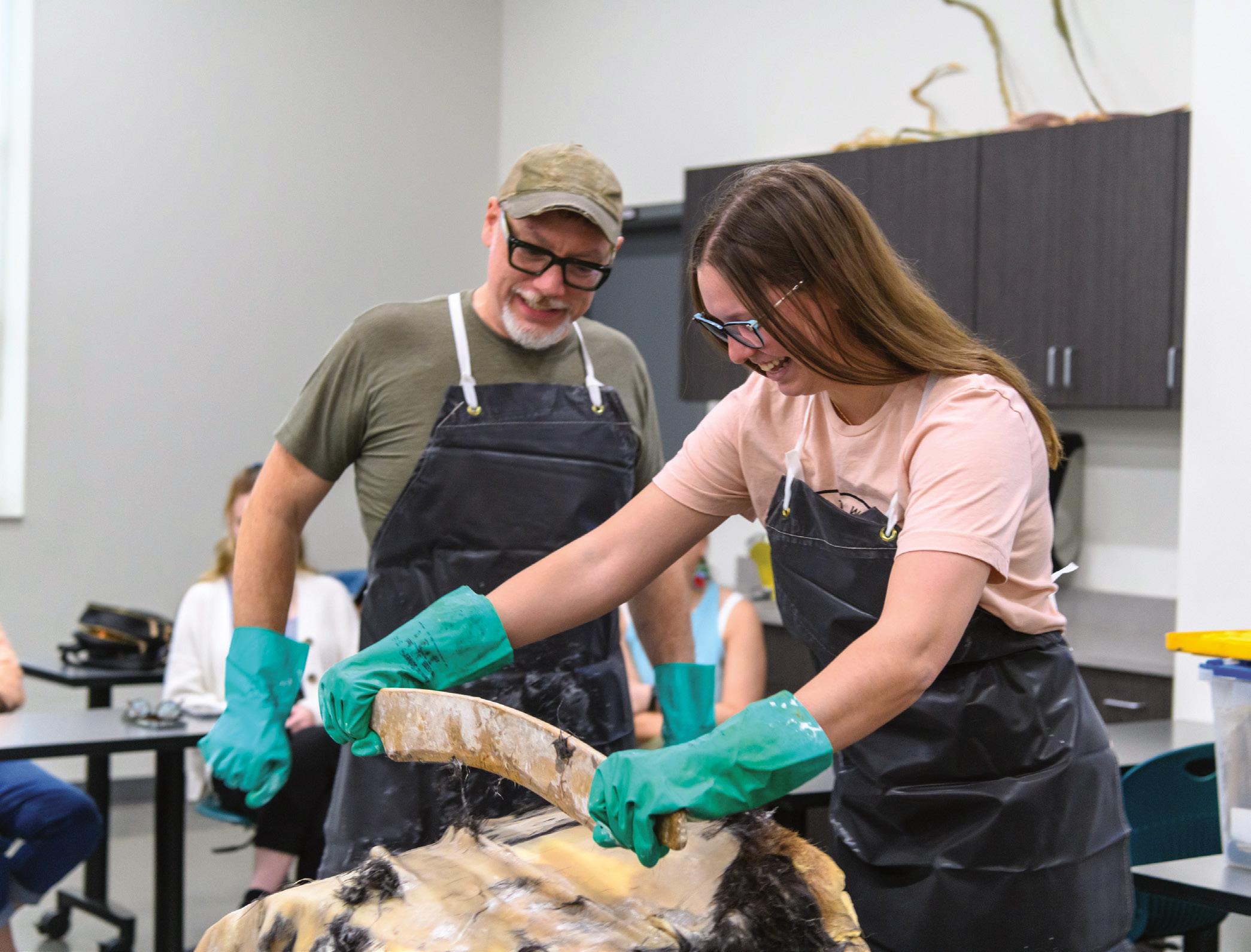
an exhibit,” Masood said. “This was getting up close, being able to really look at them, sometimes they get to handle them, it’s a rare opportunity.”
The benefit of having materials up close, like OSU was able to have this spring, was beneficial and something Borland said you can’t get just by looking at a computer screen.
“You can understand certain things from very high res, digitized images,” she said. “But you can’t sense the weight of the book, or how the pages turn or what noises happened, to engage with it, how it smells, and all these things. There’s this kind of sensory physical experience, and I think of it really linking directly to the past, when you touch something that someone in the 13th century also touched.”
RESEARCH.OKSTATE.EDU 51
Most medieval manuscripts were made using parchment. OSU students learned about the parchment-making process from expert Jesse Meyer in a workshop this spring.
Finding a Signal
OSU English professor uses National Endowment for the Humanities Fellowship to research WWII radio, television
For years around the globe, American military members have gotten a sense of home because of one network.
From World War II to today, including the famous “Gooood Morning, Vietnam,” radio call, the American Forces Radio and Television Service (AFRTS or also known as AFN) supplied news, entertainment and command information to the armed forces overseas.
Oklahoma State University professor Stacy Takacs has become an expert on the AFN as she was awarded and has completed a National Endowment for the Humanities fellowship for her research on the subject.
NEH fellowships are competitive awards granted to individuals to produce scholarly works that add value to the humanities and the general public. The fellowship offers recipients like Takacs the gift of time — the opportunity to focus solely on their work as NEH expects fulltime commitment to the project. Recipients are unable to accept teaching assignments or engage in other activities that could detract from their term commitment.
A professor in the Department of English and the American Studies program, Dr. Takacs was selected to work on her manuscript “‘We Bring You Home’: The American Forces Network and
STORY ERIN MILEK | PHOTO PROVIDED
52 OSU RESEARCH MATTERS 2023
US Militarism Post-WWII.” The book examines the 80-year history of the network.
“I took a research trip to the National Archives and Records Administration in College Park, Maryland, early in the term to complete some research that was delayed by COVID closures,” Takacs said. “Once that was done, I sat, and I wrote, and I sat, and I wrote. In seven months, I completed two full chapters and four smaller vignettes that will be featured as insets in the book.”
In her research, Takacs uncovered a gap that she was eager to dive deeper into. Thanks to an OSU College of Arts and Sciences travel grant, she will get that opportunity.
“While at the National Archive, I discovered a trove of important material related to AFN’s use as a public diplomacy tool during the Cold War,” Takacs said. “I also discovered a gap related to my research on Vietnam. I will be returning to plug that hole and tighten up that chapter.”
Dr. Jeff Menne, Department of English head, commended Takacs’ ambition as an educator. He said her work will benefit the field and bring distinction to the department.
“Dr. Takacs is a rigorous researcher, as this book and the NEH fellowship attest, but she brings the same level of rigor to the classroom, and our students benefit from it,” Menne said.
“She models analytical thinking for her students and is impressive in the classroom.”
Takacs is still working on completing the last two chapters of her manuscript. Once the piece is complete, she hopes to continue sharing her work.
“I’d like to create a geographic information system map of AFRTS radio and TV stations from 1942 through the present day to illustrate the growth cycles of the network and the broader ‘empire of bases’ it serves,” Takacs said. “I’d hope to make that accessible online. I’d also like to share my archive of materials — which is extensive — on the web.”
Dr. John Kinder, director of the American Studies program, shared in praising Takacs’ accomplishments, noting that this fellowship sets a precedent for faculty and raises the program’s status in both the region and the nation.
“I hope this accomplishment reminds students, faculty and fellow Oklahomans why research universities such as OSU are so valuable,” Kinder said. “It’s because our faculty members are not only award-winning teachers but also world-class scholars.
“Dr. Takacs has already amassed a career’s worth of accomplishments — and I have little doubt that the best is yet to come.”
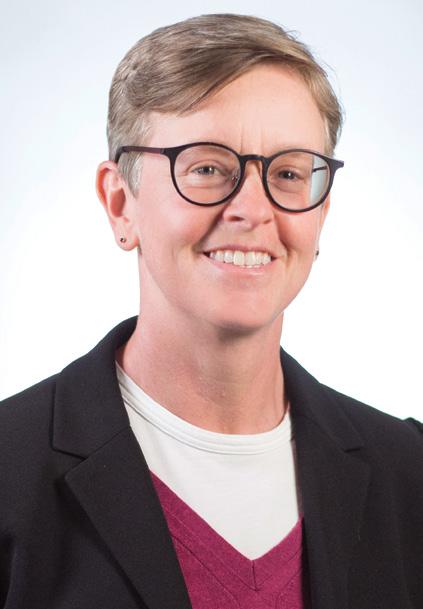
“I hope this accomplishment reminds students, faculty and fellow Oklahomans why research universities such as OSU are so valuable. It’s because our faculty members are not only award-winning teachers but also world-class scholars.”
DR. JOHN KINDER, DIRECTOR OF THE AMERICAN STUDIES PROGRAM
RESEARCH.OKSTATE.EDU 53
Dr. Stacy Takacs
THE CONVERSATION
People blame and judge parents for children’s heavier weights
Americans stigmatize parents of heavier children, specifically blaming them for their children’s weights, according to experiments conducted by our team of psychologists.
The more a person views parents as responsible for a child’s excess weight, the more likely they are to view such parents as bad parents who are lazy, overindulgent and incompetent.
Our findings corroborate what parents of children with higher weights have reported for years: that other people — friends, other parents, strangers or even their pediatricians — might blame them, dislike them and think they are poor parents.
WHY IT MATTERS
In the U.S., about 1 in 3 children have body mass indexes that would be categorized as overweight or obese. The number has grown during the COVID19 pandemic, meaning an increasing number of parents face stigma on account of their child’s weight.
This parental weight stigma is just beginning to receive serious scientific attention but could have major effects on parents, children and families.
For example, family courts across the U.S. and internationally have removed children with obesity from parental custody in large part due to their children’s weights. Family separation can have massive negative effects on children. Our work suggests that if judges react as our study participants did, they may view parents of heavier children as being bad parents simply because their children are heavier.
In reality, weight is not solely under personal control. In fact, dieting can cause weight gain.
Excess weight arises from a complex interplay of genes, environment, diet and activity.
Psychologists also know that weight stigma is associated with pervasive negative consequences, including bullying, ignorant comments and feelings of painful invisibility — as well as diminished educational and economic opportunities and worse medical outcomes importantly not simply due to one’s weight. Experiencing weight stigma, insidiously, might itself facilitate weight gain and cause other negative effects.
WHAT STILL ISN’T KNOWN
If people blame and stigmatize parents of children with higher weights, what effects does it have on parents, on their children and on the parent-child interactions that are so important for healthy development?
We do not yet know, for example, if heavier children are aware people stigmatize their parents. If so, these children might not only be ashamed of their size, but also might erroneously feel responsible for how people treat their parents.
HOW WE DO OUR WORK
For this research, published in the journal Psychological Science, we ran three experiments with over 1,000 U.S. participants — about 75% white and 25% other races/ethnicities — over the course of 2022.
We randomly assigned participants to view one of four line drawings depicting a mother or father
STORY JAIMIE ARONA KREMS AND DEVANSHI PATEL
FACULTY
STORY FROM
AUTHORED
54 OSU RESEARCH MATTERS 2023
next to an 8-year-old daughter or son. We also included a short description of the parent and child.
In two of the line drawings and descriptions, the child was described and depicted as “healthy” weight. In the other two, the child was depicted and described as having “obesity.” The parents were always depicted and described as being healthy weight. This allowed us to conclude that study participants’ reactions to parents were due to their children’s weights, not the parents’.
We asked participants a few short questions about how good or bad a parent they thought the adult was. Participants also answered questions about what they believed influenced the child’s weight (as well as their academic performance and

athleticism, to help obscure the focus of the study). Participants were given 100 “responsibility points” to allot to four factors that could be behind the child’s weight: parent behavior, child behavior, genetic factors and societal factors.
As expected, people who viewed the child with obesity assigned more responsibility points to parent behavior and saw that parent as a worse parent. We found parent and child gender made little difference, consistent with other work.
This is consistent with previous research showing people blame parents for children’s obesity more than people blame society or the kids themselves.
We also tested whether providing alternative explanations for the child’s weight would decrease the amount of blame parents received for it. When we
told participants the child had a thyroid condition that caused her excess weight, they stigmatized the mother less, holding her less responsible.
Next, our team is exploring how parents’ own weight, income and race/ ethnicity influences the stigma directed toward them on account of their child’s excess weight.
Jaimie Arona Krems, assistant professor of psychology at Oklahoma State University, and Devanshi Patel, Ph.D. candidate in clinical psychology at Oklahoma State University wrote this story in partnership with The Conversation. The Conversation is a nonprofit news outlet dedicated to sharing research from experts like those on our faculty. Read more from our faculty by going to okla.st/theconversation.
RESEARCH.OKSTATE.EDU 55
Factory of Tomorrow
Nobel Prize-winning physicist Dennis Gabor famously said the best way to predict the future is to create it.
That’s precisely what a collaborative team of researchers — engineers, computer scientists and behavioral scientists — from Oklahoma State University and across the nation plan to do for the world of manufacturing.
Led by Spears School of Business professor of management Dr. Bryan Edwards, the OSU team is purposefully designing the factory of tomorrow, which will weave artificial intelligence, automation and humans seamlessly together in a manufacturing ecosystem that takes productivity and safety to the next level while opening the door of skilled labor to people that could only dream of it today.
“Let’s create the jobs of the future instead of letting them just happen haphazardly,” Edwards said. “Let’s get ahead of it. Let’s envision the factory of tomorrow.”
Edwards has assembled a team of OSU researchers that includes Dr. Dursun Delen, a Regents Professor of Management Science and Information Systems at Spears Business and the director of research for the OSU Center for Health Systems Innovation; Dr. Weihua Sheng, an electrical and computer engineering professor at OSU’s College of Engineering, Architecture and Technology; and associate professor Dr. Christopher Crick of the OSU Department of Computer Science, who has worked extensively with models of human cognition and social development to improve robot control and learning, human-robot interaction and artificial intelligence in general.
The OSU group has joined faculty from the University of Louisville, the University of Kentucky, the University of Texas-Arlington and Cornell University to seek funding for a multi-university research center that has the potential to change the world of manufacturing.
The ambitious project aims to revolutionize the way workers and manufacturing centers interact and would include everything from the walls of the factory to the skin of the employee. Much of it involves collaborative interfaces that help people work alongside robots in intuitive and groundbreaking ways. The public is already aware of some collaborative interfaces like virtual reality headsets, but they can also include wearables such as haptic-capable clothing that can detect pressure, heat and vibration.
“We can use AI so that the robot understands our intentions based on body language, what we’re doing, our movements, and then we can communicate our intentions to that robot, and they’ll almost immediately pick it up,” Edwards said. “Think about using robots to lift heavy
STORY STEPHEN HOWARD | PHOTOS AARON MURPHY
56 OSU RESEARCH MATTERS 2023
OSU researchers hoping to use AI to streamline the future of work
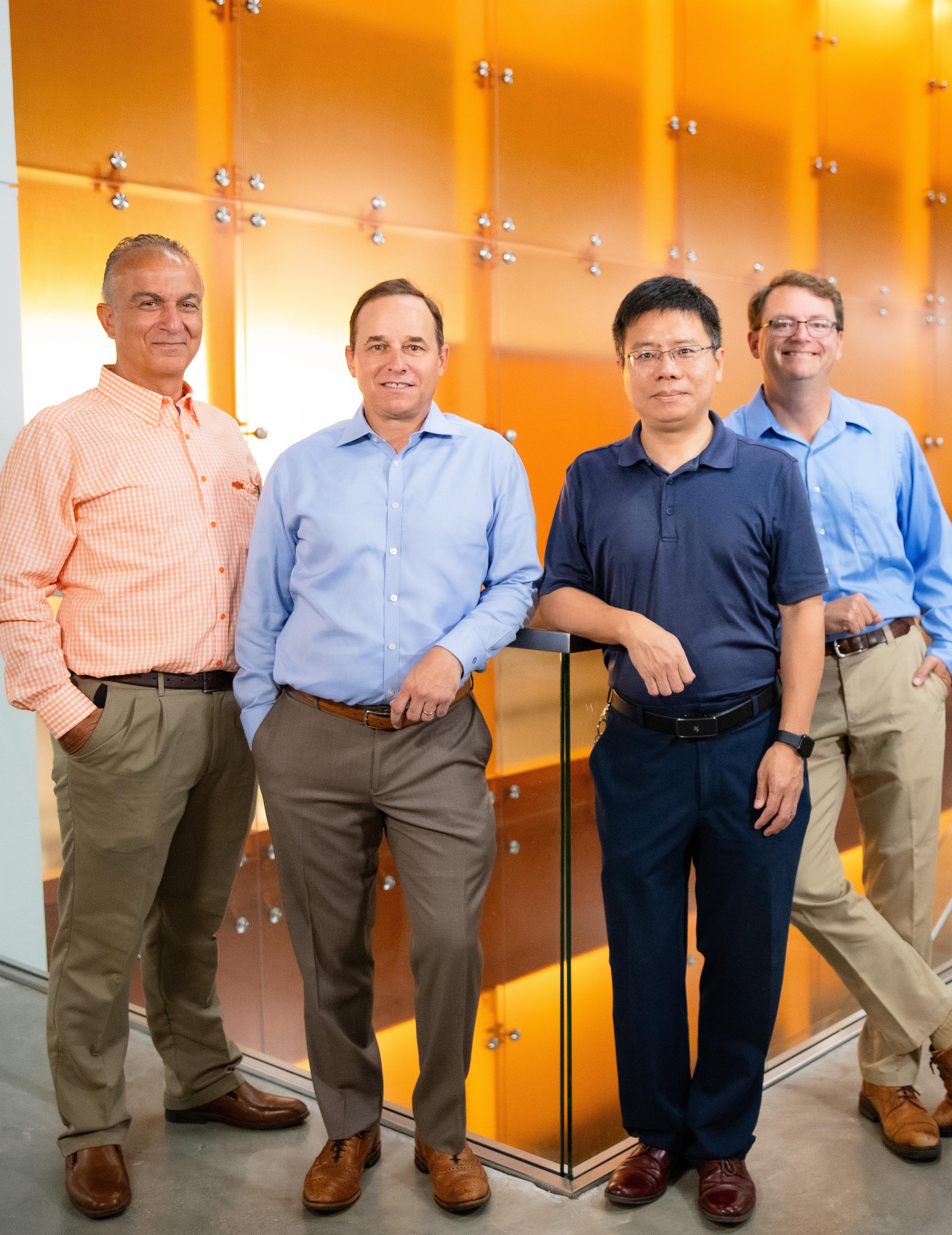 OSU faculty researchers (from left)
OSU faculty researchers (from left)
RESEARCH.OKSTATE.EDU 57
Dr. Dursun Delen, Dr. Bryan Edwards, Dr. Weihua Sheng and Dr. Christopher Crick have joined forces on a project to revolutionize the manufacturing industry.
objects instead of humans. You notice something’s tipping over and the robot senses it too, immediately. Think about being able to communicate with a robot as you’re lifting heavy objects and going through a door. That involves twists and turns, and it will have to understand what you’re asking it to do.”
This technology would substantially increase the speed of production. Things that previously took years to develop, such as the research and design of a new vehicle, could be done in the blink of an eye thanks to AI software that can instantly reference the designs of every vehicle ever made, as well as the latest in safety innovations and consumer habits. Then, workers and automated machines could fit the parts together in a collaborative and safe environment.
It has the potential to open new opportunities to underemployed people across the world. The passage of the Americans with Disabilities Act in 1990 helped many people enter the workforce, but those with disabilities are still unemployed and underemployed at staggering rates.
Delen, who has spent 30 years in data science and AI machine learning on top of his work with the Department of Defense and NASA, believes the increase in efficiency afforded by new technology could also bring outsourced manufacturing jobs back to the United States.

“People think AI and machines are going to take over the work,” Delen said.
“But that is not going to be the optimal way to pursue it. It should be an augmentation, a mixed initiative, an optimal combination of humans and robots and AI working together. And when that happens, manufacturing that has been offshored, outsourced to other countries, will come back to the U.S. because it’s going to be cost-efficient and it’s going to be streamlined in a way that humans and robots will work together at a significantly higher level of efficiency.”
Getting people to understand the benefits of the factory of tomorrow may be the first step, but the second and possibly most important step will be getting people to trust it. Throughout history, humans have shown a level of resistance to new tools and technology, and Edwards, a behavioral scientist, sees it happening now with AI.
Edwards said communicating how AI will benefit each person will be the key to acceptance, and that starts with the next generation. His plan is to create a master’s degree geared toward the science of future technologies in the workplace. People in these positions will not only envision the future of industries but will also work with grade schools across the country to help implement the skills that will be needed when today’s children enter the workforce.
This will help dissuade fears that new technologies are here to take jobs from people — another key in getting the
workforce to trust AI and robots. Rather than entering the job market with fear, the next generation will be prepared to work alongside technology and adapt to it as it changes.
“Throughout human history, new technology has replaced human jobs, but we’ve always maintained a pretty steady employment rate,” Edwards said. “In other words, there are other jobs that the new technology creates, even if it replaces some of the existing jobs. So, being able to get out in front of that and identify the new jobs that will be created will be another measure of success for us.”
In 2020, Edwards and Dr. William Paiva, executive director of the OSU Center for Health Systems Innovation, joined forces with faculty engineers from the University of Louisville to earn a share of a $1.5 million grant from the National Science Foundation. The goal was to develop and evaluate AI technologies that allowed robots to do routine patient-care tasks to alleviate stress during the nation’s nursing
“People think AI and machines are going to take over the work. But that is not going to be the optimal way to pursue it. It should be an augmentation, a mixed initiative, an optimal combination of humans and robots and AI working together.”
58 OSU RESEARCH MATTERS 2023
DR. DURSUN DELEN, REGENTS PROFESSOR OF MANAGEMENT SCIENCE AND INFORMATION SYSTEMS AND THE DIRECTOR OF RESEARCH FOR THE OSU CENTER FOR HEALTH SYSTEMS INNOVATION
shortage. The Association of American Medical Colleges has warned about the possible shortage of more than 100,000 nurses by 2030.
Led by the grant’s principal investigator, the University of Louisville’s Dr. Dan Popa, the group developed ARNA, an adaptive robotic nursing assistant, that was put to work at the Louisville School of Nursing. ARNA weighs about 500 pounds and utilizes cameras and lidar, a remote sensing method that uses light waves to examine terrain and objects, to navigate patient rooms and hospital hallways while helping nurses carry out tasks quickly and safely.
Edwards sees ARNA as a perfect example of how technology can help preserve and even create new jobs while solving problems in the workplace.
“We’re not trying to replace nurses. We’re trying to fill the nursing shortage and help our nurses,” he said.
ChatGPT, an AI large language model developed by OpenAI and launched in November 2022, essentially scrapes the internet to answer any question posed to it in a human-like way. It can write a joke, compose an email or even write a novel in a fraction of a second, and with every query, the program learns. However, because ChatGPT is reading the internet, it can
give out biased or false data to the extent it runs across it during its searches.
In the future, it’s not hard to imagine an AI program assisting companies with human-resource tasks like employee recruitment and performance evaluations. Research shows that human bias exists in many HR systems based on gender, race and other considerations. So, to the extent that a company uses its own database to feed into the AI system, that bias in the database is going to be manifested in whatever outcome the AI has.
“If you’re using an algorithm to predict who to hire for a job or who to promote, bias is going to be built right into that AI,” Edwards said. “For example, women dominate the nursing field, so that’s going to be femaleheavy bias in those algorithms. Males are more prevalent in engineering, so there’ll be a little bit more bias in some of that. So, for instance, if you’re building a robot in manufacturing, a field that’s dominated by men, the AI may not consider or compensate for women.”
The way to overcome these biases, Edwards said, is to teach the AI to decipher information better, which is certainly possible for a technology capable of learning. But, once again, the key to implementation is human intentionality and a laser-like focus on the goal of moving the technology forward.

These groundbreaking technologies won’t reach their full potential without researchers and scientists mapping out the future, finding ways to deliberately weave the technology and people together in safe and innovative ways.
OSU, with its modern land-grant mission, is at the forefront of these conversations.
“I wouldn’t be able to do this type of work if I weren’t at a land-grant institution, a R1 institution, like Oklahoma State,” Edwards said. “We have a lot of support for this research, from former OSU President Burns Hargis to the current president, Dr. Kayse Shrum, and even here at Spears Business with prior Dean Ken Eastman and current Dean James Payne.
“The Power of Personal is definitely at work in this research.”
“Throughout human history, new technology has replaced human jobs, but we’ve always maintained a pretty steady employment rate. ...
So, being able to get out in front of that and identify the new jobs that will be created will be another measure of success for us.”
RESEARCH.OKSTATE.EDU 59
DR. BRYAN EDWARDS, SPEARS SCHOOL OF BUSINESS PROFESSOR OF MANAGEMENT
Preparing for Parenthood
OSU psychology professor studying mental health in pregnancy
Even for those who have planned for pregnancy and curated a list of items they need, lined up daycare and drafted their birth plan, there is still something many overlook — mental health.
It’s not an issue many families plan for, but it can have a greatly detrimental effect on the mother and infant.
As many as 20% of people experience postpartum depression and anxiety around giving birth, said Dr. Lucia Ciciolla, associate professor of psychology at Oklahoma State University, making mental illness one of the most common complications associated with pregnancy and childbirth.
Ciciolla’s research focuses on the perinatal period, which includes pregnancy through the first year postpartum. This is a period of major biological, developmental and psychological change that is foundational for healthy child development and family functioning.
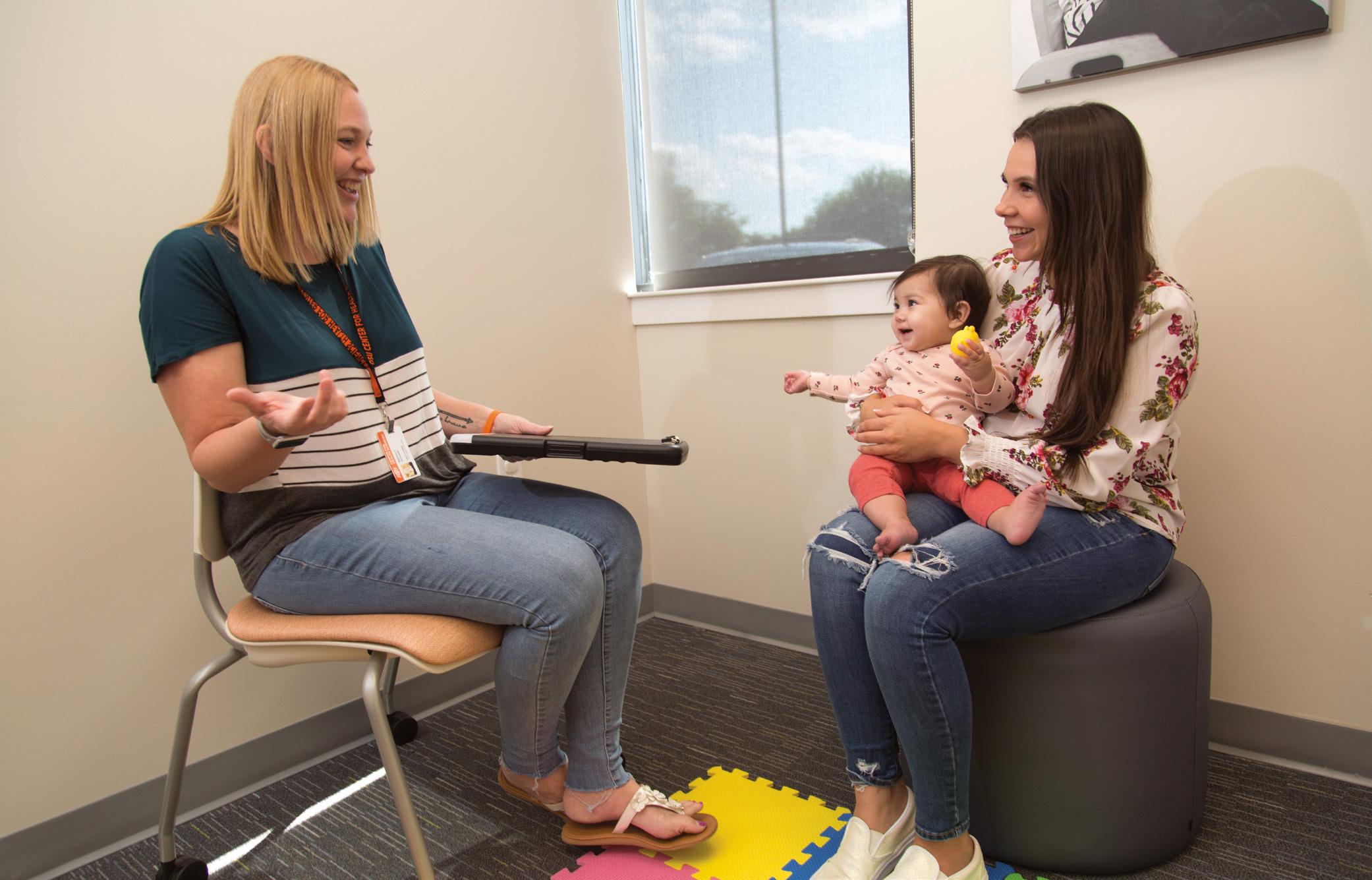
In the context of maternal mental health and the mother-infant relationship, Ciciolla is able investigate the intergenerational transmission of adversity and resilience during this critical period.
In other words, Ciciolla wants to “understand how one generation impacts the next, and how a parent’s own experiences and mental health might shape their child, through both their biology as well as through their parenting.”
STORY SYDNEY TRAINOR | PHOTO RYAN JENSEN
60 OSU RESEARCH MATTERS 2023
The mother and infant come in for assessments during the studies where they perform tasks for the researchers to observe how they interact with each other during high and low stress tasks.
Ciciolla is currently leading the Epigenetics of Mother-Baby Reactivity and Childhood Experiences study.
As part of the Center for Integrative Research on Childhood Adversity, funded by the National Institute for General Medical Sciences at the National Institutes of Health, Ciciolla leads the EMBRACE study, which focuses on the perinatal, intergenerational epigenetic pathways from maternal risk and protective factors to infant stress reactivity.
Specifically, the study examines how maternal history of adversity and supportive relationships are related to epigenetic changes to genes involved in regulating the stress hormone response, and the impact of these changes on how babies respond to and recover from stressful situations, like missing a nap or being away from their parents.
“It is about understanding how stress and adversity get under the skin and change one’s biology, and how that might get passed on to the infant, and how that might change how both the mother and infant then respond to stress and stressful situations,” Ciciolla said.
The study has three data collection points during pregnancy and postpartum. Families stay in the study until infants are 4 months old and uses questionnaires to learn about mothers’ life experiences, mental and physical health, infant development and relationships. They also collect saliva from mothers and infants to get information about epigenetic markers that alter the expression of stressrelated genes and about their actual stress hormone levels.
Results from this study are expected to help identify mother-infant stress profiles and protective factors that may be targets for interventions to promote healthy stress regulation across generations.
“This project is in line with my broader program of research and clinical work supporting maternal and infant mental health. I am hopeful this research can inform new programs to
support moms and babies and promote healthy stress regulation,” Ciciolla said.
Ciciolla is also a co-investigator on the HEALthy Brain and Child Development study.
HBCD study is a longitudinal research project which seeks to understand the role of perinatal exposures on child neurodevelopment.
“HBCD is a national study funded by the National Institutes of Health and the National Institute on Drug Abuse. It is focused on pregnancy and following the infant until they reach 10 years old,” said Dr. Julie Croff, professor in the Department of Rural Health at OSU Center for Health Sciences.
OSU is one of 25 sites for the HBCD study. Ciciolla is a member of several national working groups tasked with planning the HBCD study and supports data collection efforts at the OSU site focused on child developmental assessments, caregiver reports of family functioning and child and caregiver interactions.
Croff is the contact principal investigator of HBCD and serves as Ciciolla’s mentor on EMBRACE. They both share interests in health during pregnancy and interventions to improve maternal and children’s health.
Croff said assessments for HBCD are more frequent in the first three years because that is when most brain development occurs, then they spread out.
“Our first assessment, visit one, is during pregnancy and visit two is in that first month of life,” Croff said. “During the first month of life, the mother and infant will come in for the assessment. One of the unique components of the study is when the infant has an MRI during natural sleep. Researchers will also collect specimens like saliva and urine from both baby and mother.”
In the three-to-nine-month period, an EEG will be performed along with the MRI to have multiple data sources, Croff said.
“The studies like EMBRACE and HBCD are helping us to better understand the lives of pregnant people,
and then inform the interventions that might be most powerful to them,” Croff said.
Ciciolla’s previous work with perinatal populations also included the NIH-funded Sleep and Mother-Baby Regulation study, focused on how sleep impacts the infant and mother’s wellbeing and mental health.
Ashley Quigley, a clinical psychology graduate student working with Ciciolla, plays a role in data collection through each of these studies and is also interested in perinatal, intergenerational processes of risk and resilience.
“My thesis is actually looking at how mother’s anxiety during pregnancy can influence infant sleep in the postpartum period, but also understanding the role that infants can have in shaping their own future and their own development too,” Quigley said.
Quigley also looked at the role of infant temperament and reactions to their environments in shaping sleep patterns.
Quigley found that the mother’s bond to the baby during pregnancy was protective against infant temperamental negativity, suggesting that the critical importance of the mother-infant relationship for infant well-being begins prenatally.
“That’s just one study and there’s a lot of components to it, but basically the overarching theme is understanding that things can happen during pregnancy that can influence a child’s development once they’re born,” Quigley said.
Ciciolla hopes to use the data from these related studies to support future research grants that dive deeper into understanding the mechanisms driving developmental outcomes and inform the development of programs to support maternal and infant mental health and well-being.
“Studies like HBCD and EMBRACE will support upcoming solutions for families in Oklahoma and beyond,” Croff said.
RESEARCH.OKSTATE.EDU 61
NIBLACK RESEARCH SCHOLARS’ NEWEST CLASS
Research at Oklahoma State University starts the minute students step foot on campus. For 13 students, their careers are being accelerated through the Niblack Research Scholars program.
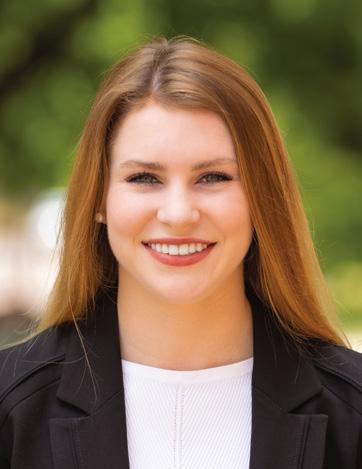




These undergraduates have been selected as Niblack Research Scholars for the 2023-24 school year, earning them an $8,000 scholarship and the opportunity to conduct research with faculty across campus.
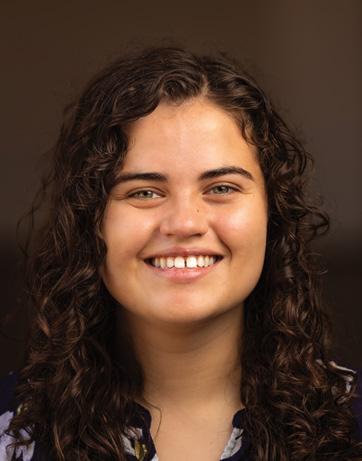


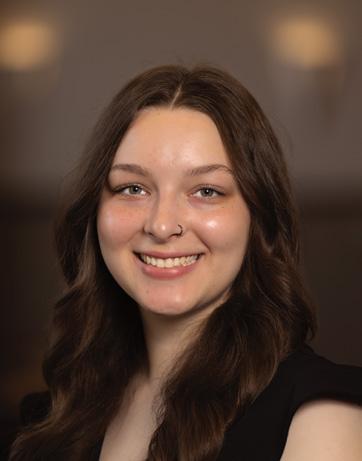
Funded by Dr. John Niblack and his wife, Heidi, the Niblack Research Scholars program has been a key part of OSU’s undergraduate research success for 18 years. The program allows these students to perform
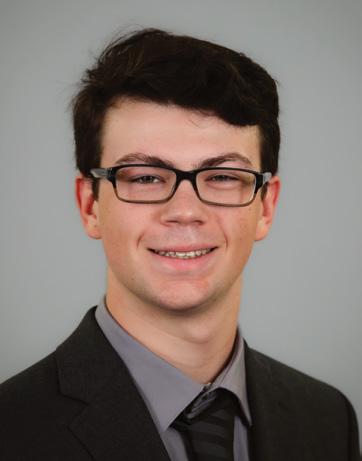


cutting-edge research in various fields under faculty mentors’ supervision.
Niblack graduated from OSU in 1960 with a bachelor’s degree in chemistry and earned a doctorate in biochemistry from the University of Illinois before becoming vice chairman of Pfizer Inc.
As a scientist for the international pharmaceutical giant, he was responsible for Pfizer’s Global Research and Development Division, where he directed research into drugs for viral illnesses, cancer and autoimmune disorders.
Niblack retired in 2002 and founded the Niblack Research Scholarship program in 2004.
 Ethan Biedenstein Haslet, Texas Mechanical and Aerospace Engineering
Trinity McMahon Tulsa Physiological Sciences
J. Elijah Brown Broken Arrow, Oklahoma Biochemistry and Molecular Biology
Ella McReynolds El Reno, Oklahoma Microbiology and Molecular Genetics
Kayleen Sugianto Enid, Oklahoma Integrative Biology
Clauddia Dodd Oklahoma City Microbiology and Molecular Genetics
Ella Moffet Woodward, Oklahoma Nutritional Sciences
Therese Tankam Edmond, Oklahoma Physiological Sciences
S. Connor Downs Edmond, Oklahoma Integrative Biology
Angelique Robinson Mustang, Oklahoma Nutritional Sciences
Feven Tesfaselassie Edmond, Oklahoma Animal and Food Sciences
Faith Howe Sulphur, Oklahoma Animal and Food Sciences
Ethan Biedenstein Haslet, Texas Mechanical and Aerospace Engineering
Trinity McMahon Tulsa Physiological Sciences
J. Elijah Brown Broken Arrow, Oklahoma Biochemistry and Molecular Biology
Ella McReynolds El Reno, Oklahoma Microbiology and Molecular Genetics
Kayleen Sugianto Enid, Oklahoma Integrative Biology
Clauddia Dodd Oklahoma City Microbiology and Molecular Genetics
Ella Moffet Woodward, Oklahoma Nutritional Sciences
Therese Tankam Edmond, Oklahoma Physiological Sciences
S. Connor Downs Edmond, Oklahoma Integrative Biology
Angelique Robinson Mustang, Oklahoma Nutritional Sciences
Feven Tesfaselassie Edmond, Oklahoma Animal and Food Sciences
Faith Howe Sulphur, Oklahoma Animal and Food Sciences
62 OSU RESEARCH MATTERS 2023
Griffyn Stoodley Stillwater Chemical Engineering
THREE OSU STUDENTS WIN OTTO S. COX GRADUATE FELLOWSHIPS
At Oklahoma State University, the Otto S. Cox Graduate Fellowship for Genetic Research helps students stand out in the corresponding field.
Students earn the annual fellowship by showcasing proven records of genetic inquiry and the potential to impact the discipline in the future.
“OSU genetics research continues to grow in both breadth and depth, supporting our priorities in One Health and production agriculture,” said Dr. Kenneth Sewell, OSU’s vice president for research. “The Cox Fellowship for Genetics Research is an important part of that growth.”
This year had a highly competitive application pool with three OSU students — Stephen Kotey, Huishan Liu and Jesna Varghese —earning a fellowship. The award will provide a $1,000 stipend and recognition for pursuing challenging work in a rapidly evolving and critical research area.
Past recipients of the Cox Fellowship have gone on to study phenomena as diverse as the neurochemistry of the link between childhood adversity and addiction to the degradation of fish habitats, Sewell said. Other alumni of this fellowship are continuing to pursue advanced degrees or have established laboratories at universities, government agencies or in the pharmaceutical industry.
“Clearly, the Cox Fellowship is having its intended positive impact,” he said.
With tuberculosis being the second leading cause of death by an infectious pathogen after COVID-19, Kotey’s research is focused on targeting important genetic elements in host immune cells, known as long non-coding RNAs as a therapeutic regimen in the treatment of mycobacterial infections, including tuberculosis.
“It is a great privilege to be part of the story of humanity’s fight against them,” Kotey said. “The search for a potent treatment regimen for these infectious diseases has been in the works for over
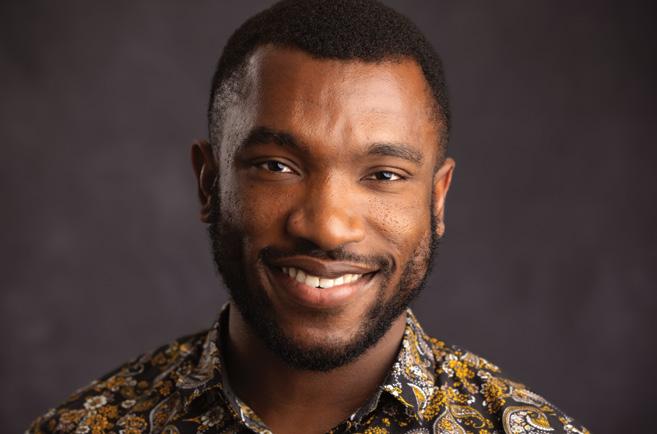
150 years. The importance of this work grants me a fulfillment that makes me cherish every bit of the research I do.
“Also, this work comes with the honor of mentoring and training undergraduates and young scientists.”
Varghese’s work is also related to antibiotic alternatives.
“The opportunistic human pathogen Pseudomonas aeruginosa produces intra-specific killing complexes known as pyocins that have the potential to specifically kill P. aeruginosa as a therapeutic alternative to antibiotics,” Varghese said.
Varghese is studying the molecularmechanistic of the regulation of an alternative pathway for pyocin expression in cells that was discovered by fellow researchers in the Cabeen Lab.
“We are trying to achieve a molecular-mechanistic understanding of the regulation of the alternative pyocin production pathway,” Varghese said.
Varghese developed an interest in therapeutics and drug discovery while pursuing their master’s degree.
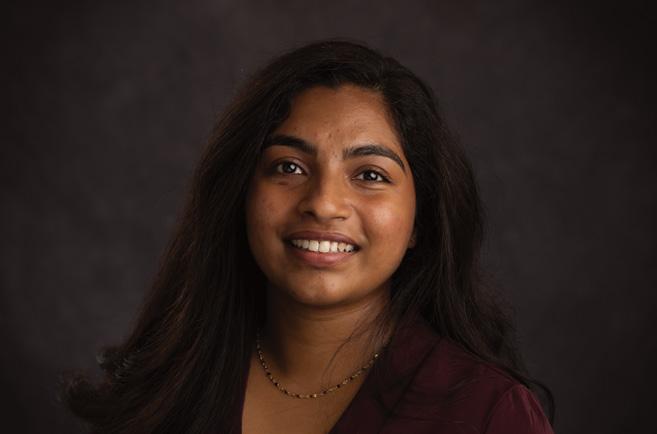
“The project I am working on now completely aligns to my interest,” Varghese said. “In this day and age of antibiotic resistance succumbing the world, I feel it is really important to study alternative ways of treating bacterial infections. The area of my research is very exciting to me, and I hope to make an influence in the scientific community in the future.”
Liu’s work in the lab is on the forefront of research helping to reduce the synthetic fertilizer pollution by engineering a mutually beneficial relationship between host plants and nitrogen fixing bacteria.
Liu’s research focuses on how plants recognize beta-glucans produced by bacteria and fungi and which receptors are required for beta-glucans activated plant immunity and symbiosis in legume Medicago truncatula — a widely used model plant for studying plant symbiosis.
“Beta-glucans are important microbe-associated molecular patterns for innate immunity to defense against pathogen infection in both mammals and plants,” Liu said. “Interestingly, we discovered that beta-glucans can also activate plant symbiotic signaling pathway, which are essential for establishing a mutualistic relationship between plant roots and symbiotic microorganisms.”
By identifying the plant pattern recognition receptors involved in betaglucans perception, people can better understand the communication between hosts and microbes.
“I am truly honored to be recognized by the Cox fellowship this year, it boosts my confidence in scientific research and motivates me to pursue further explorations in the future,” Liu said.
 STEPHEN KOTEY doctoral candidate in biochemistry and molecular biology
JESNA VARGHESE doctoral candidate in microbiology and molecular genetics
STEPHEN KOTEY doctoral candidate in biochemistry and molecular biology
JESNA VARGHESE doctoral candidate in microbiology and molecular genetics
RESEARCH.OKSTATE.EDU 63
HUISHAN LIU doctoral student in biochemistry
PRESIDENT’S FELLOWS
Three Oklahoma State University professors were named 2023 President’s Fellows Faculty Research Award recipients.
RAMESH KAIPA
Dr. Ramesh Kaipa — associate professor and director of the Department of Communication Sciences and Disorders — researches treatments for individuals with speech disorders following neurological illness.

It’s common for people with Parkinson’s disease to experience speech deficits that have a major bearing on their quality of life. There is limited research to develop an evidence-based treatment for fast speech rate in Parkinson’s. As the director of the Motor Speech Lab, Kaipa hopes to fill this void.
“The overarching theme of my research is to improve quality of life for individuals diagnosed with neurogenic communication disorders,” Kaipa said.
The funds from this award will be used to finance a project that will test the efficacy of a novel line of treatment intended to address fast rate of speech in individuals with Parkinson’s disease.
“This will be one of the first projects to solely focus on treating speech rate deficit in this population,” Kaipa said. “The outcomes of this project will have broader ramifications on service-delivery models for people with Parkinson’s disease. Additionally, this project will reinforce OSU’s One Health model.”
WINYOO CHOWANADISAI
Dr. Winyoo Chowanadisai — associate professor of nutritional sciences — researches how diets and genetics affect human health.
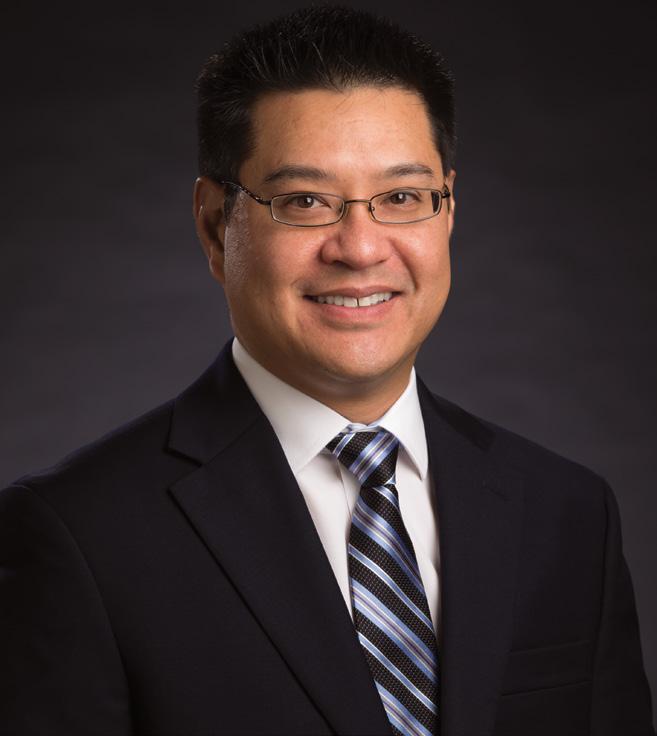
“My goal is to determine ways for people to adjust their diets based on their genes to promote health in a way that is specific for each person,” Chowanadisai said.
Chowanadisai is specifically interested in preserving brain and cognitive function during aging and preventing dementias like Alzheimer’s disease.
The funds from this award are being used to support a project for accessing the UK Biobank — a database of extensive health, dietary and genomics data — to examine how important different minerals and vitamins are to human health and preventing neurodegeneration and chronic diseases.
“This award supports the students in my lab so they can focus on data science and research using the UK Biobank with fewer financial worries,” Chowanadisai said.
This past summer, undergraduates Parker Johnson and Gracie Meade and concurrent enrollment student Aiden Yejoon Kim worked in Chowanadisai’s lab.
MIKE SCHOONOVER
Dr. Mike Schoonover — professor of veterinary clinical sciences and equine surgery service chief at the Boren Veterinary Teaching Medical Hospital — researches equine intravenous regional limb perfusion techniques (IVRLP).
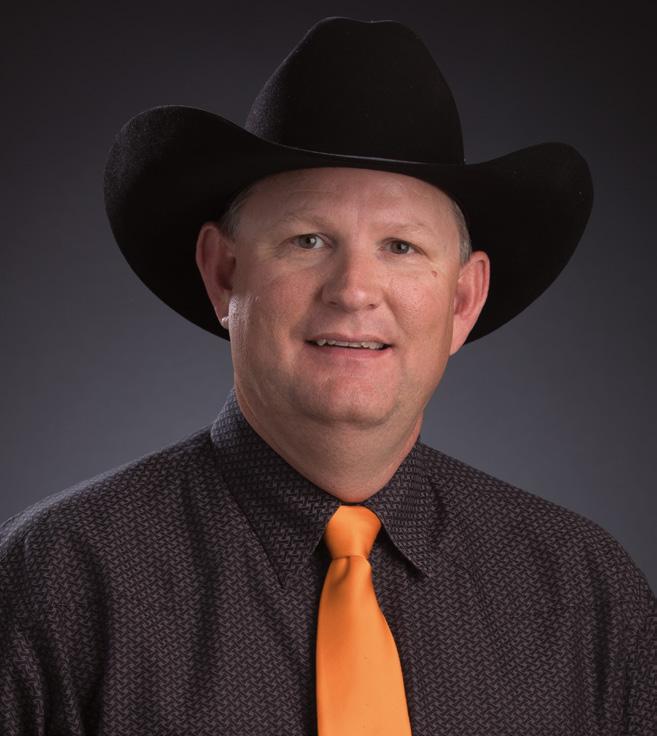
These techniques are used in the prevention and treatment of orthopedic and soft tissue infections in horses.
“Although much research has been published on the efficacy of IVRLP in adult horses, limited scientific information is available on the use of this technique in foals,” Schoonover said. “The horse industry is very important to Oklahoma and has a major impact on the state’s economy and the quality of life of many Oklahomans. Newborn foals within our state, nation and worldwide will benefit from improved treatment protocols because of this study and the additional research it stimulates.”
The research funded by this award is focused on providing needed scientific evidence of the effectiveness and safety of concurrent intravenous and IVRLP with amikacin — an antimicrobial — for the treatment of infection in the joints of neonatal foals as well as help guide future research of IVRLP in foals using different medications and techniques.
64 OSU RESEARCH MATTERS 2023
REGENTS DISTINGUISHED RESEARCH AWARD
Oklahoma State University honored seven faculty members with the 2022 Regents Distinguished Research Award during the December 2022 University Awards Convocation.
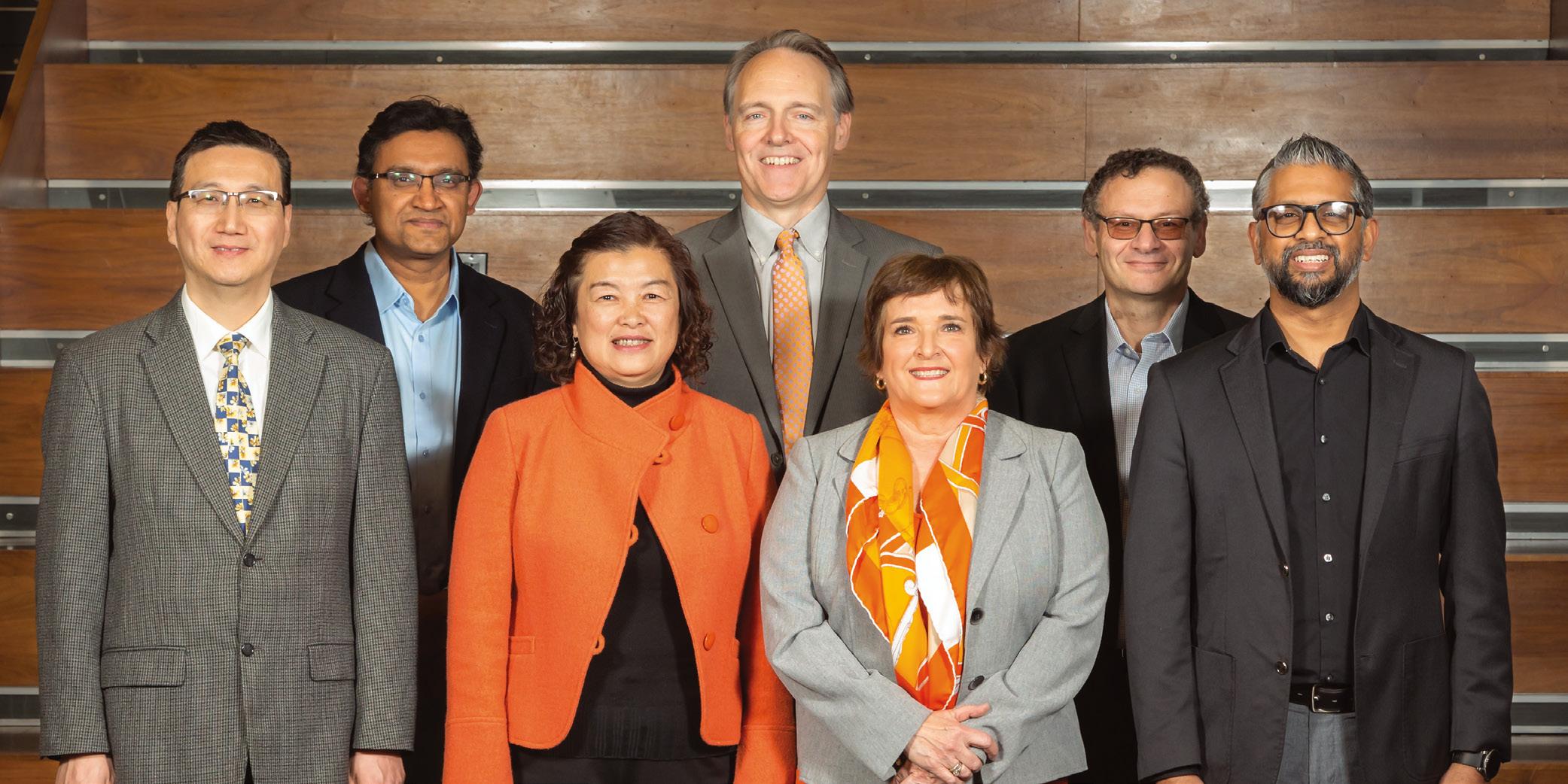
The award recipients must demonstrate a distinguished record of past and continuing excellence in research and be recognized nationally and internationally.
“Research excellence is one of the hallmarks of our land-grant university,” said Dr. Kenneth Sewell, OSU’s vice president for research. “These honorees are great examples of the impact our faculty have on their disciplines and society at large, not to mention the transformative effect they have on their students here on campus.”
The Regents Distinguished Research Award program includes one award per college, except the College of Arts and Sciences which has two — one in the sciences and one in the arts/humanities disciplines.
Dr. Tilanka Chandrasekera
Design and Merchandising, College of Education and Human Sciences
Dr. Mostafa Elshahed
Microbiology and Molecular Genetics, College of Arts and Sciences
Dr. Guoliang Fan
Electrical and Computer Engineering, College of Engineering, Architecture and Technology
Dr. Thomas Lanners
Music, College of Arts and Sciences
Dr. Akhilesh Ramachandran
Pathobiology, College of Veterinary Medicine
Dr. Betty Simkins
Finance, Spears School of Business
Dr. Ning Wang
Biosystems and Agricultural Engineering, Ferguson College of Agriculture
From left: Dr. Guoliang Fan, Dr. Akhilesh Ramachandran, Dr. Ning Wang, Dr. Thomas Lanners, Dr. Betty Simkins, Dr. Mostafa Elshahed and Dr. Tilanka Chandrasekera.
WHERE CAN YOU FIND RESEARCH THAT IMPROVES LIVES ?
AT OKLAHOMA STATE UNIVERSITY, A CARNEGIE R1 RESEARCH UNIVERSITY, WE PERFORM ACCESSIBLE, INNOVATIVE AND LIFE-CHANGING RESEARCH that is human focused. We are focused on finding solutions for accessible technology, health resources, drought management, revitalizing rural communities and more.
We are constantly exploring and discovering ways to enhance the local and global landscape. Our agricultural research scientists are involved in an international effort to address water security and resource management issues across the world, plus we recently launched the Oklahoma Aerospace Institute for Research and Education. From the land to the sky, our experts are passionately pursuing knowledge to create change.

ORANGE IS THE ANSWER.
Oklahoma State University Office of the Vice President for Research 203 Whitehurst Stillwater, Oklahoma 74078-1020
 Research, scholarship and creative activity at Oklahoma State University
Research, scholarship and creative activity at Oklahoma State University

































































 OSU faculty researchers (from left)
OSU faculty researchers (from left)















 Ethan Biedenstein Haslet, Texas Mechanical and Aerospace Engineering
Trinity McMahon Tulsa Physiological Sciences
J. Elijah Brown Broken Arrow, Oklahoma Biochemistry and Molecular Biology
Ella McReynolds El Reno, Oklahoma Microbiology and Molecular Genetics
Kayleen Sugianto Enid, Oklahoma Integrative Biology
Clauddia Dodd Oklahoma City Microbiology and Molecular Genetics
Ella Moffet Woodward, Oklahoma Nutritional Sciences
Therese Tankam Edmond, Oklahoma Physiological Sciences
S. Connor Downs Edmond, Oklahoma Integrative Biology
Angelique Robinson Mustang, Oklahoma Nutritional Sciences
Feven Tesfaselassie Edmond, Oklahoma Animal and Food Sciences
Faith Howe Sulphur, Oklahoma Animal and Food Sciences
Ethan Biedenstein Haslet, Texas Mechanical and Aerospace Engineering
Trinity McMahon Tulsa Physiological Sciences
J. Elijah Brown Broken Arrow, Oklahoma Biochemistry and Molecular Biology
Ella McReynolds El Reno, Oklahoma Microbiology and Molecular Genetics
Kayleen Sugianto Enid, Oklahoma Integrative Biology
Clauddia Dodd Oklahoma City Microbiology and Molecular Genetics
Ella Moffet Woodward, Oklahoma Nutritional Sciences
Therese Tankam Edmond, Oklahoma Physiological Sciences
S. Connor Downs Edmond, Oklahoma Integrative Biology
Angelique Robinson Mustang, Oklahoma Nutritional Sciences
Feven Tesfaselassie Edmond, Oklahoma Animal and Food Sciences
Faith Howe Sulphur, Oklahoma Animal and Food Sciences


 STEPHEN KOTEY doctoral candidate in biochemistry and molecular biology
JESNA VARGHESE doctoral candidate in microbiology and molecular genetics
STEPHEN KOTEY doctoral candidate in biochemistry and molecular biology
JESNA VARGHESE doctoral candidate in microbiology and molecular genetics




